Motivating Employees: Basic Principles of Management
VerifiedAdded on 2021/08/06
|54
|2937
|233
AI Summary
This article discusses the basic principles of management and the impact of employee motivation on productivity. It covers the concepts of motivation, the motivation process, and the characteristics of motivation. It also explores the sources of motivation, including positive and negative motivation, extrinsic and intrinsic motivation, and early theories of motivation. Finally, it discusses contemporary theories of motivation, including goal-setting theory, self-efficacy theory, reinforcement theory, and equity theory.
Contribute Materials
Your contribution can guide someone’s learning journey. Share your
documents today.
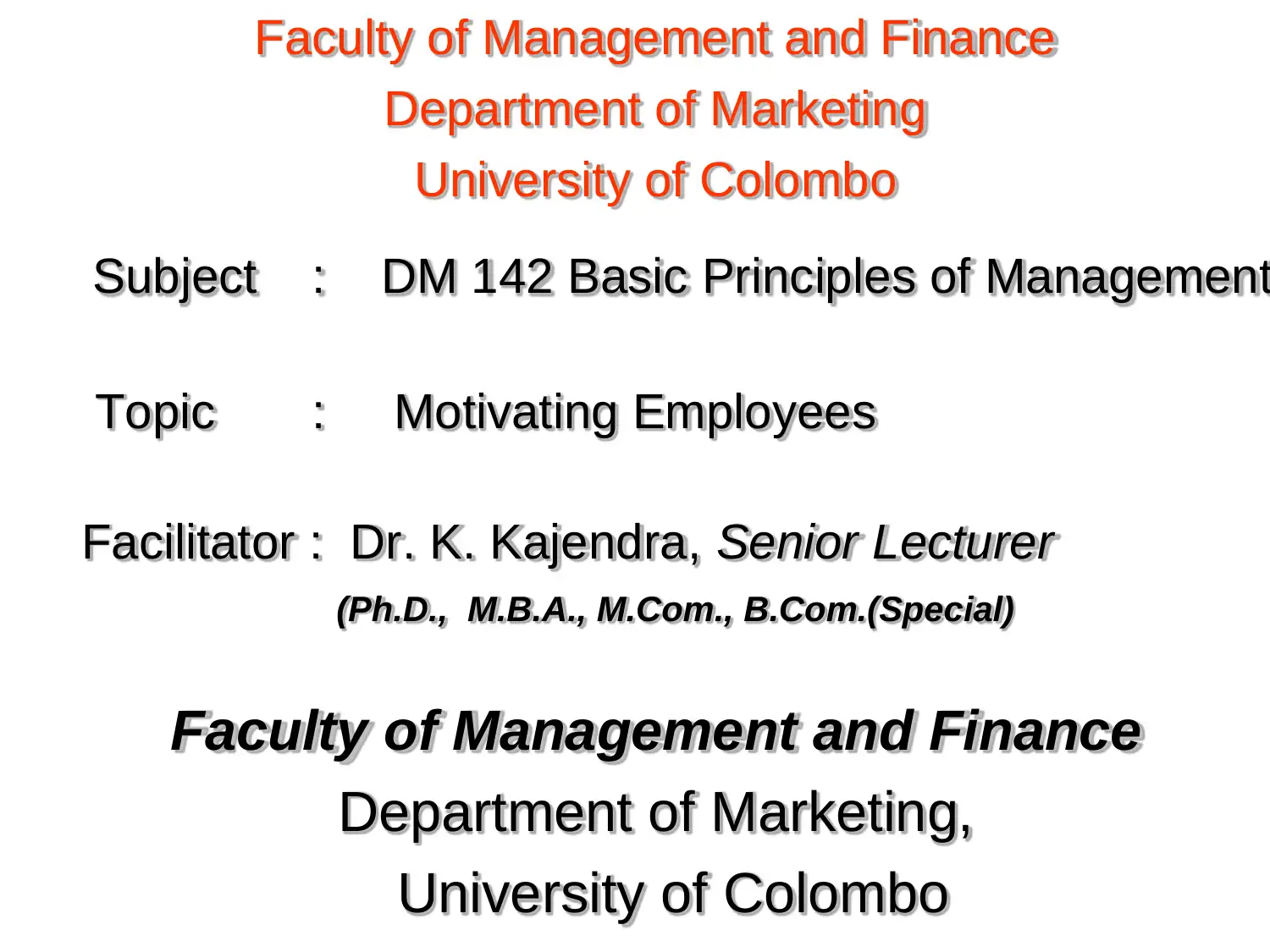
Faculty of Management and Finance
Department of Marketing
University of Colombo
Subject : DM 142 Basic Principles of Management
Topic : Motivating Employees
Facilitator : Dr. K. Kajendra, Senior Lecturer
(Ph.D., M.B.A., M.Com., B.Com.(Special)
Faculty of Management and Finance
Department of Marketing,
University of Colombo
Department of Marketing
University of Colombo
Subject : DM 142 Basic Principles of Management
Topic : Motivating Employees
Facilitator : Dr. K. Kajendra, Senior Lecturer
(Ph.D., M.B.A., M.Com., B.Com.(Special)
Faculty of Management and Finance
Department of Marketing,
University of Colombo
Secure Best Marks with AI Grader
Need help grading? Try our AI Grader for instant feedback on your assignments.
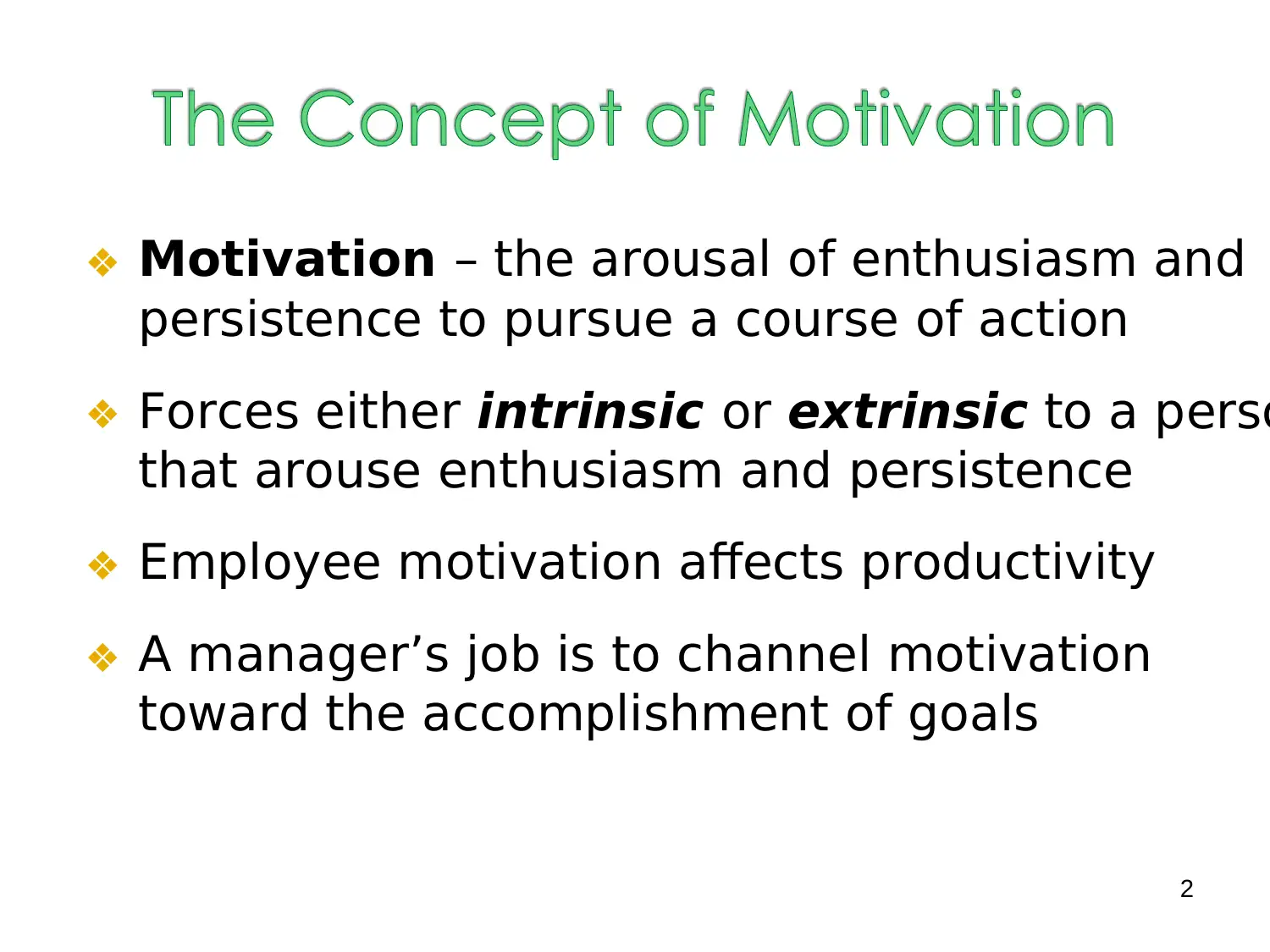
❖ Motivation – the arousal of enthusiasm and
persistence to pursue a course of action
❖ Forces either intrinsic or extrinsic to a perso
that arouse enthusiasm and persistence
❖ Employee motivation affects productivity
❖ A manager’s job is to channel motivation
toward the accomplishment of goals
2
persistence to pursue a course of action
❖ Forces either intrinsic or extrinsic to a perso
that arouse enthusiasm and persistence
❖ Employee motivation affects productivity
❖ A manager’s job is to channel motivation
toward the accomplishment of goals
2
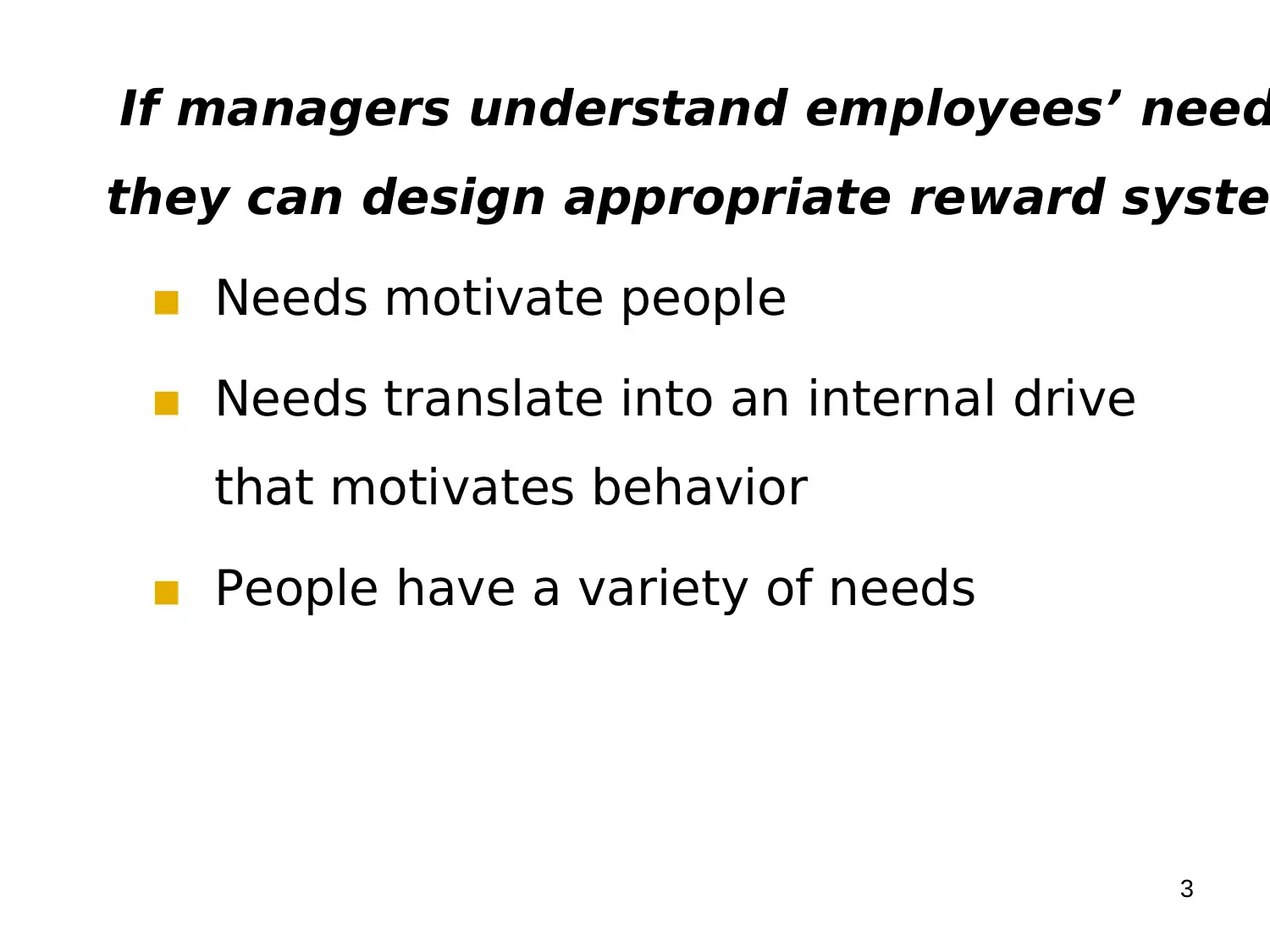
If managers understand employees’ need
they can design appropriate reward syste
▪ Needs motivate people
▪ Needs translate into an internal drive
that motivates behavior
▪ People have a variety of needs
3
they can design appropriate reward syste
▪ Needs motivate people
▪ Needs translate into an internal drive
that motivates behavior
▪ People have a variety of needs
3
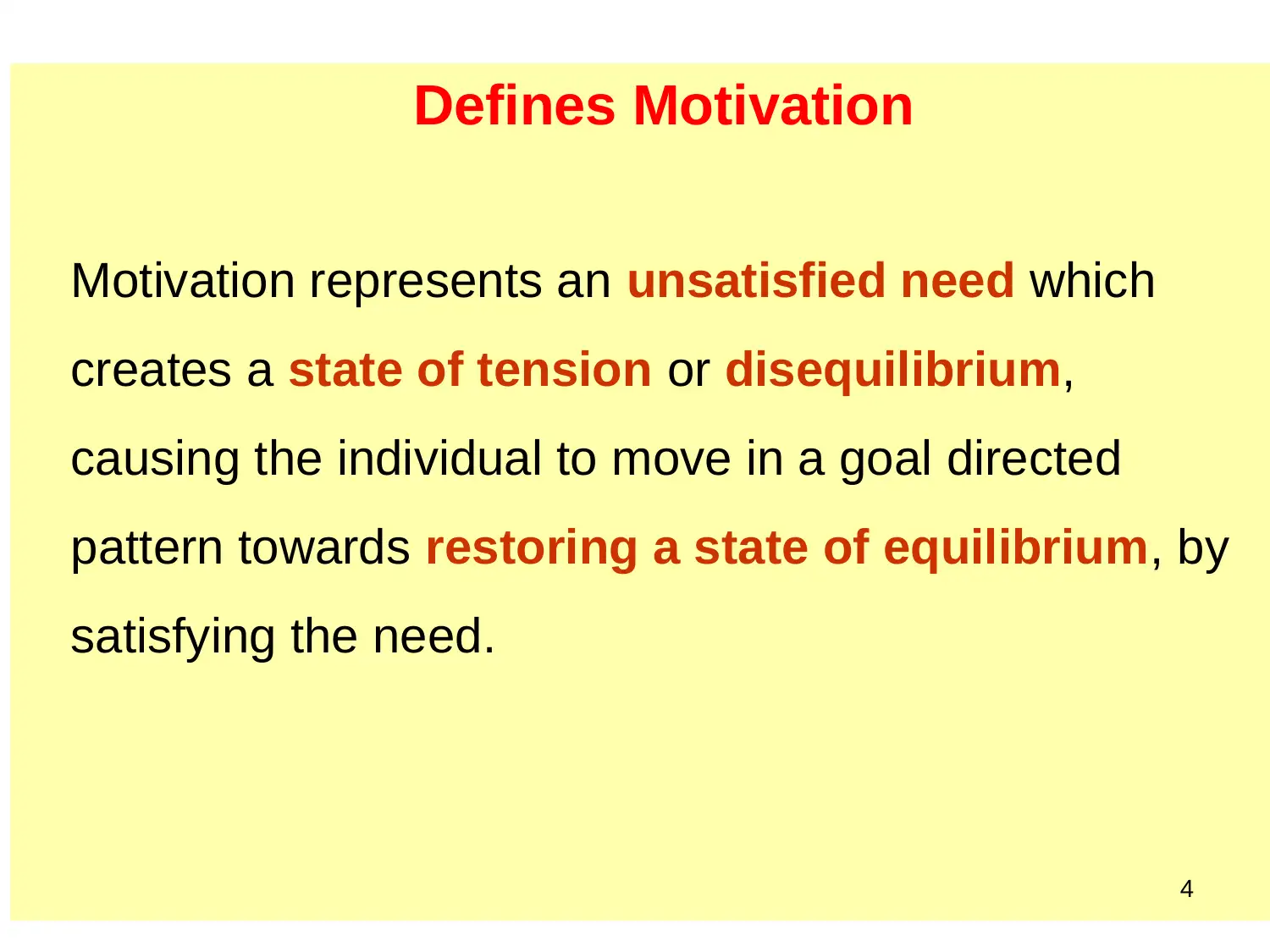
4
Defines Motivation
Motivation represents an unsatisfied need which
creates a state of tension or disequilibrium,
causing the individual to move in a goal directed
pattern towards restoring a state of equilibrium, by
satisfying the need.
Defines Motivation
Motivation represents an unsatisfied need which
creates a state of tension or disequilibrium,
causing the individual to move in a goal directed
pattern towards restoring a state of equilibrium, by
satisfying the need.
Secure Best Marks with AI Grader
Need help grading? Try our AI Grader for instant feedback on your assignments.
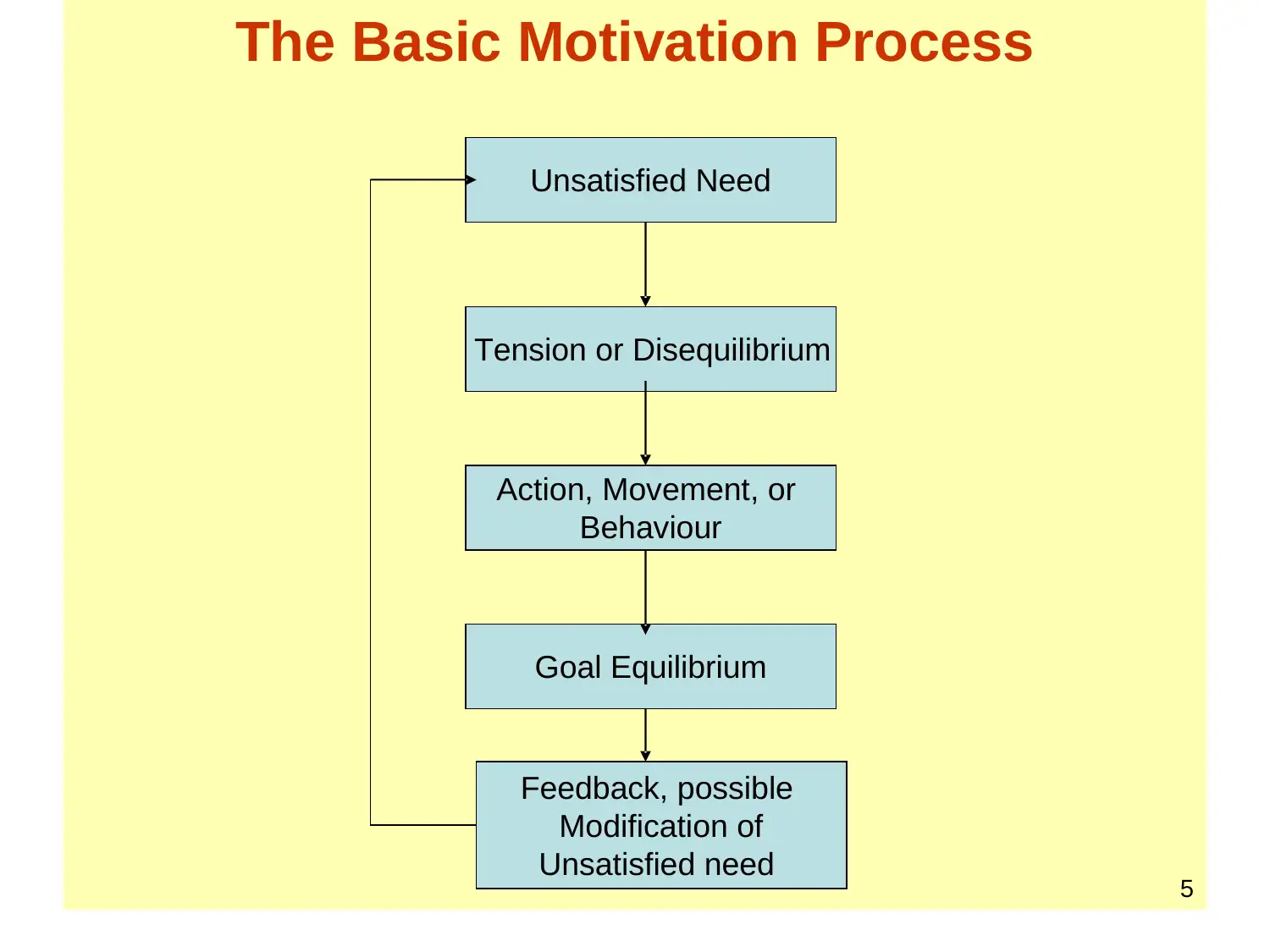
5
The Basic Motivation Process
Unsatisfied Need
Tension or Disequilibrium
Action, Movement, or
Behaviour
Goal Equilibrium
Feedback, possible
Modification of
Unsatisfied need
The Basic Motivation Process
Unsatisfied Need
Tension or Disequilibrium
Action, Movement, or
Behaviour
Goal Equilibrium
Feedback, possible
Modification of
Unsatisfied need
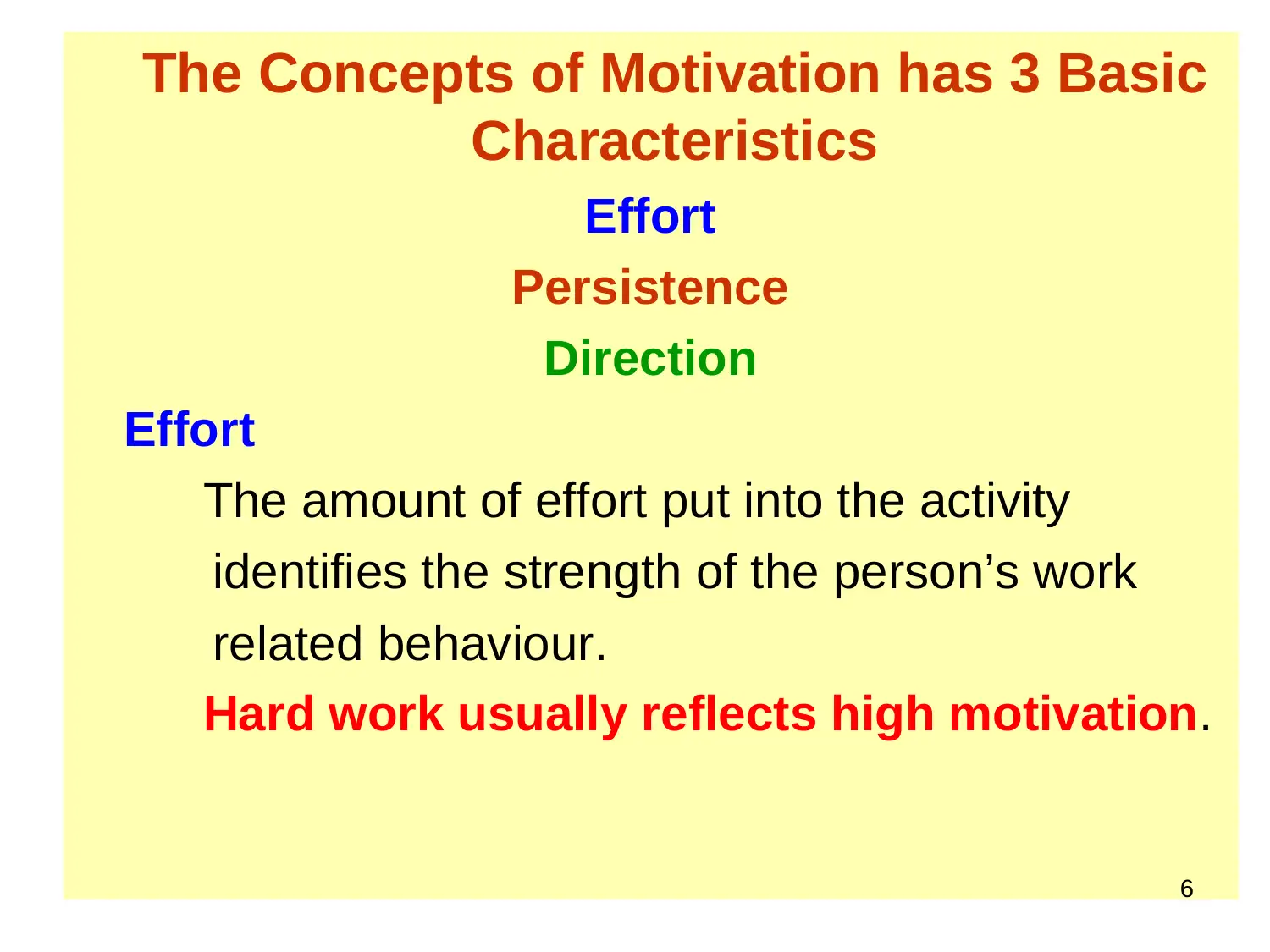
6
The Concepts of Motivation has 3 Basic
Characteristics
Effort
Persistence
Direction
Effort
The amount of effort put into the activity
identifies the strength of the person’s work
related behaviour.
Hard work usually reflects high motivation.
The Concepts of Motivation has 3 Basic
Characteristics
Effort
Persistence
Direction
Effort
The amount of effort put into the activity
identifies the strength of the person’s work
related behaviour.
Hard work usually reflects high motivation.
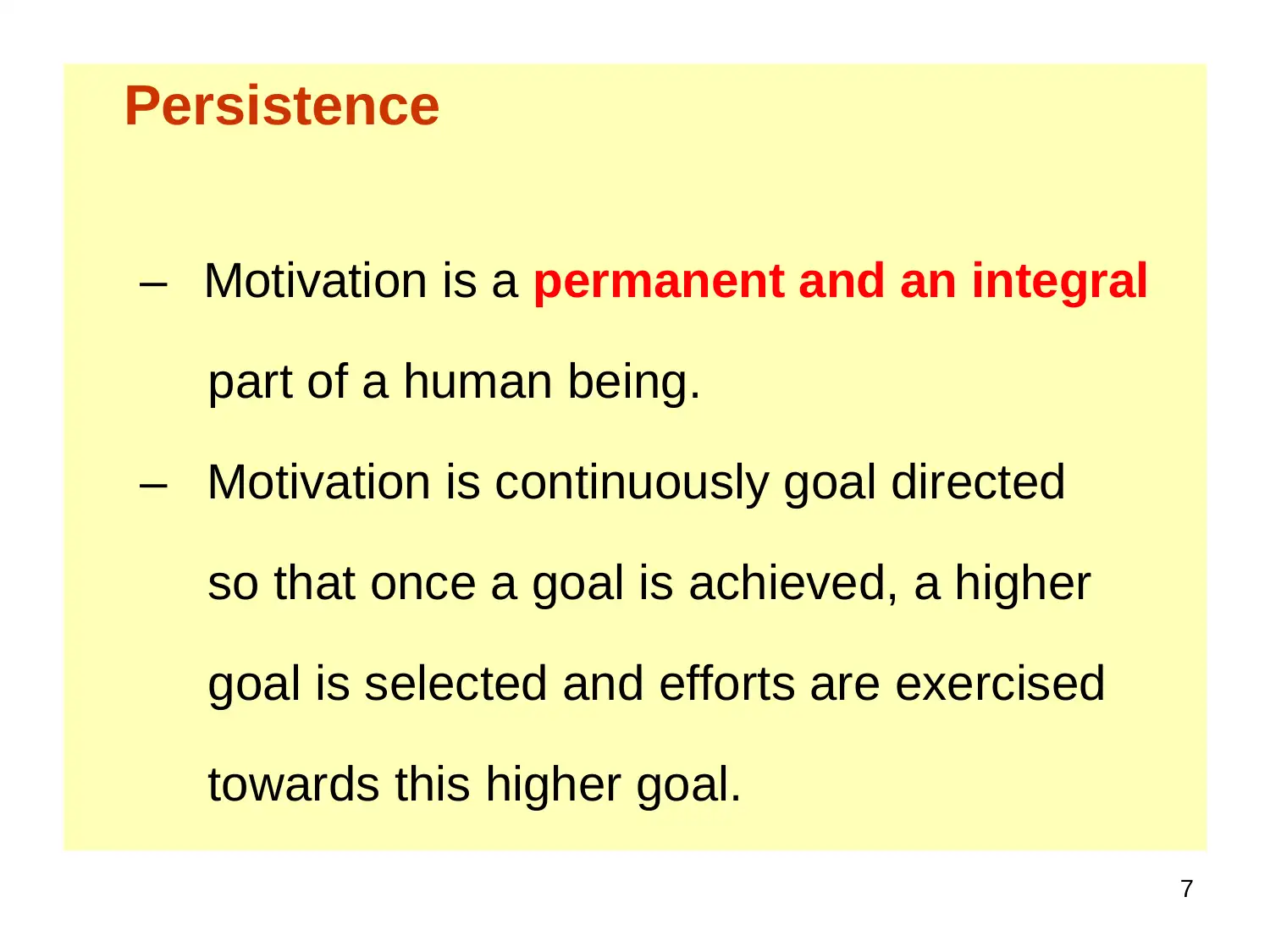
7
Persistence
– Motivation is a permanent and an integral
part of a human being.
– Motivation is continuously goal directed
so that once a goal is achieved, a higher
goal is selected and efforts are exercised
towards this higher goal.
Persistence
– Motivation is a permanent and an integral
part of a human being.
– Motivation is continuously goal directed
so that once a goal is achieved, a higher
goal is selected and efforts are exercised
towards this higher goal.
Paraphrase This Document
Need a fresh take? Get an instant paraphrase of this document with our AI Paraphraser
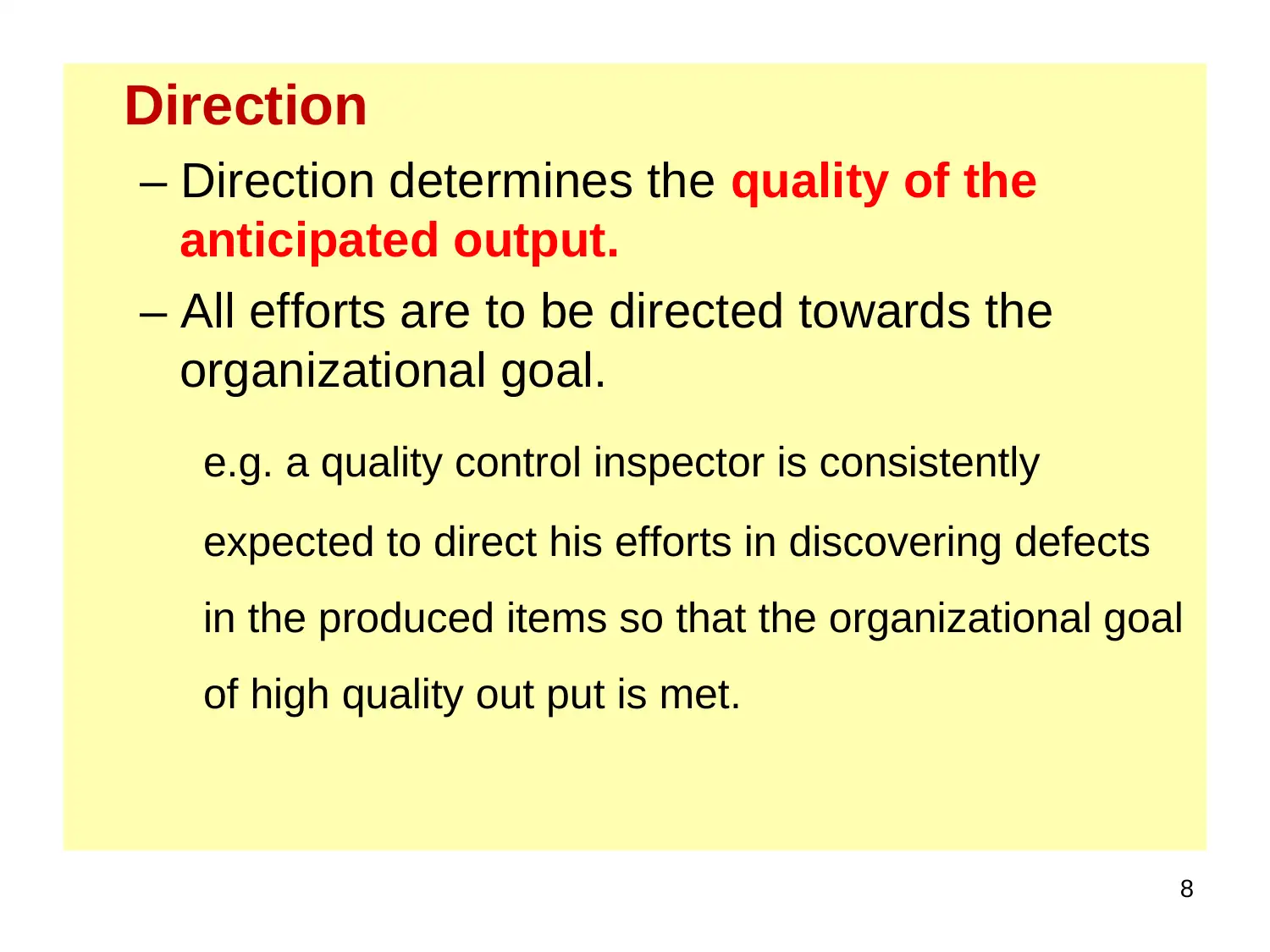
8
Direction
– Direction determines the quality of the
anticipated output.
– All efforts are to be directed towards the
organizational goal.
e.g. a quality control inspector is consistently
expected to direct his efforts in discovering defects
in the produced items so that the organizational goal
of high quality out put is met.
Direction
– Direction determines the quality of the
anticipated output.
– All efforts are to be directed towards the
organizational goal.
e.g. a quality control inspector is consistently
expected to direct his efforts in discovering defects
in the produced items so that the organizational goal
of high quality out put is met.
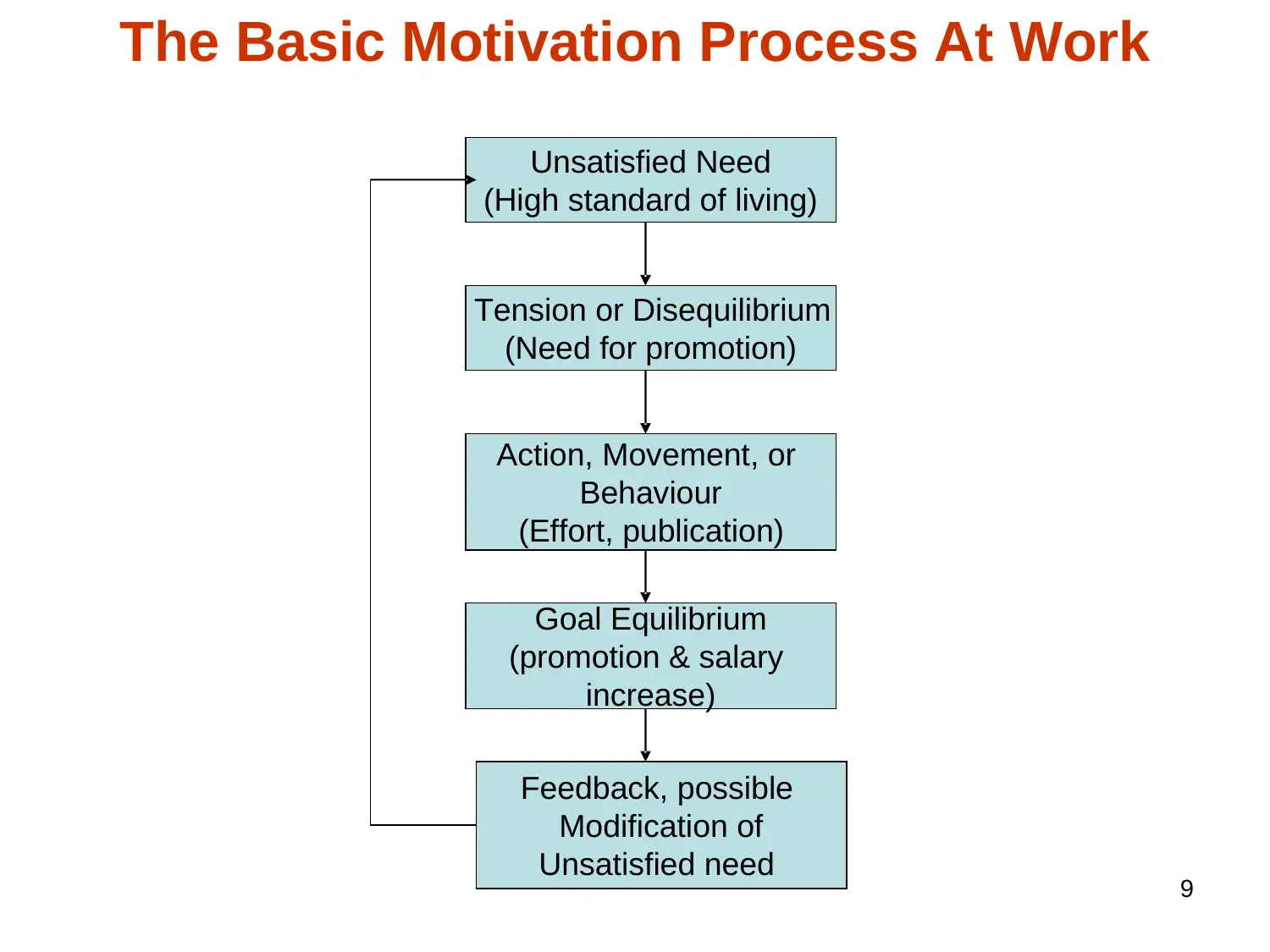
9
The Basic Motivation Process At Work
Unsatisfied Need
(High standard of living)
Tension or Disequilibrium
(Need for promotion)
Action, Movement, or
Behaviour
(Effort, publication)
Goal Equilibrium
(promotion & salary
increase)
Feedback, possible
Modification of
Unsatisfied need
The Basic Motivation Process At Work
Unsatisfied Need
(High standard of living)
Tension or Disequilibrium
(Need for promotion)
Action, Movement, or
Behaviour
(Effort, publication)
Goal Equilibrium
(promotion & salary
increase)
Feedback, possible
Modification of
Unsatisfied need
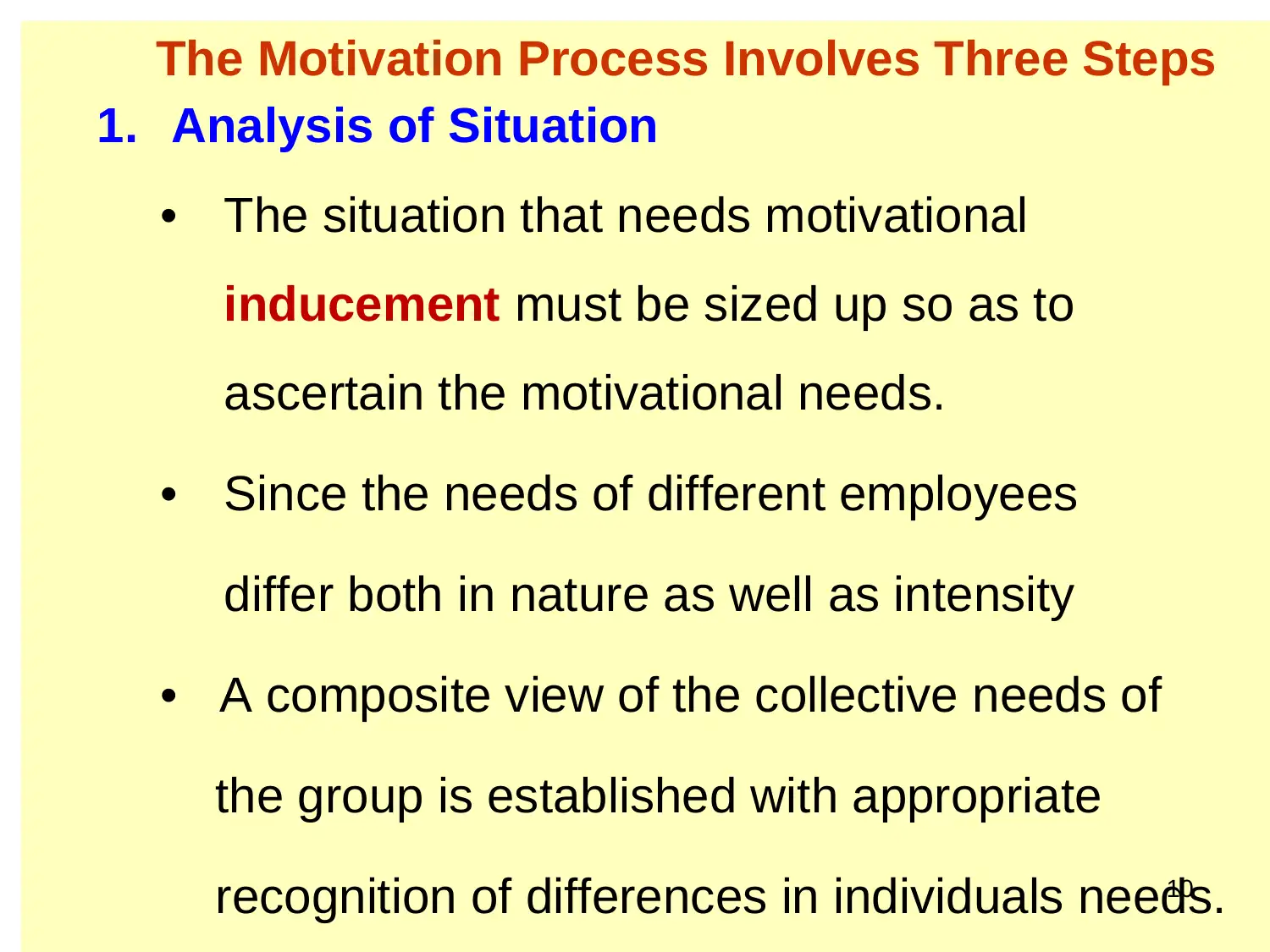
10
The Motivation Process Involves Three Steps
1. Analysis of Situation
• The situation that needs motivational
inducement must be sized up so as to
ascertain the motivational needs.
• Since the needs of different employees
differ both in nature as well as intensity
• A composite view of the collective needs of
the group is established with appropriate
recognition of differences in individuals needs.
The Motivation Process Involves Three Steps
1. Analysis of Situation
• The situation that needs motivational
inducement must be sized up so as to
ascertain the motivational needs.
• Since the needs of different employees
differ both in nature as well as intensity
• A composite view of the collective needs of
the group is established with appropriate
recognition of differences in individuals needs.
Secure Best Marks with AI Grader
Need help grading? Try our AI Grader for instant feedback on your assignments.
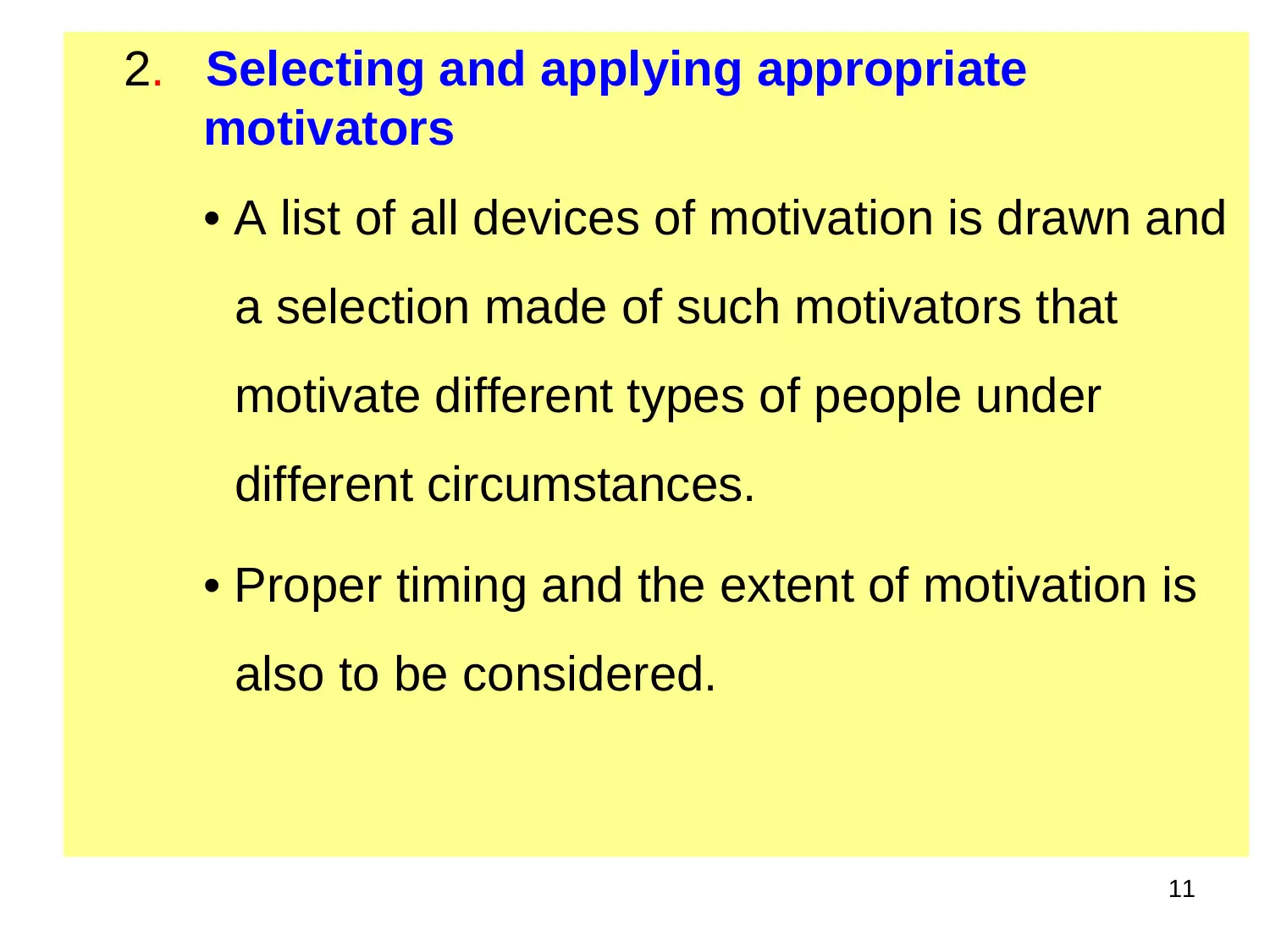
11
2. Selecting and applying appropriate
motivators
• A list of all devices of motivation is drawn and
a selection made of such motivators that
motivate different types of people under
different circumstances.
• Proper timing and the extent of motivation is
also to be considered.
2. Selecting and applying appropriate
motivators
• A list of all devices of motivation is drawn and
a selection made of such motivators that
motivate different types of people under
different circumstances.
• Proper timing and the extent of motivation is
also to be considered.
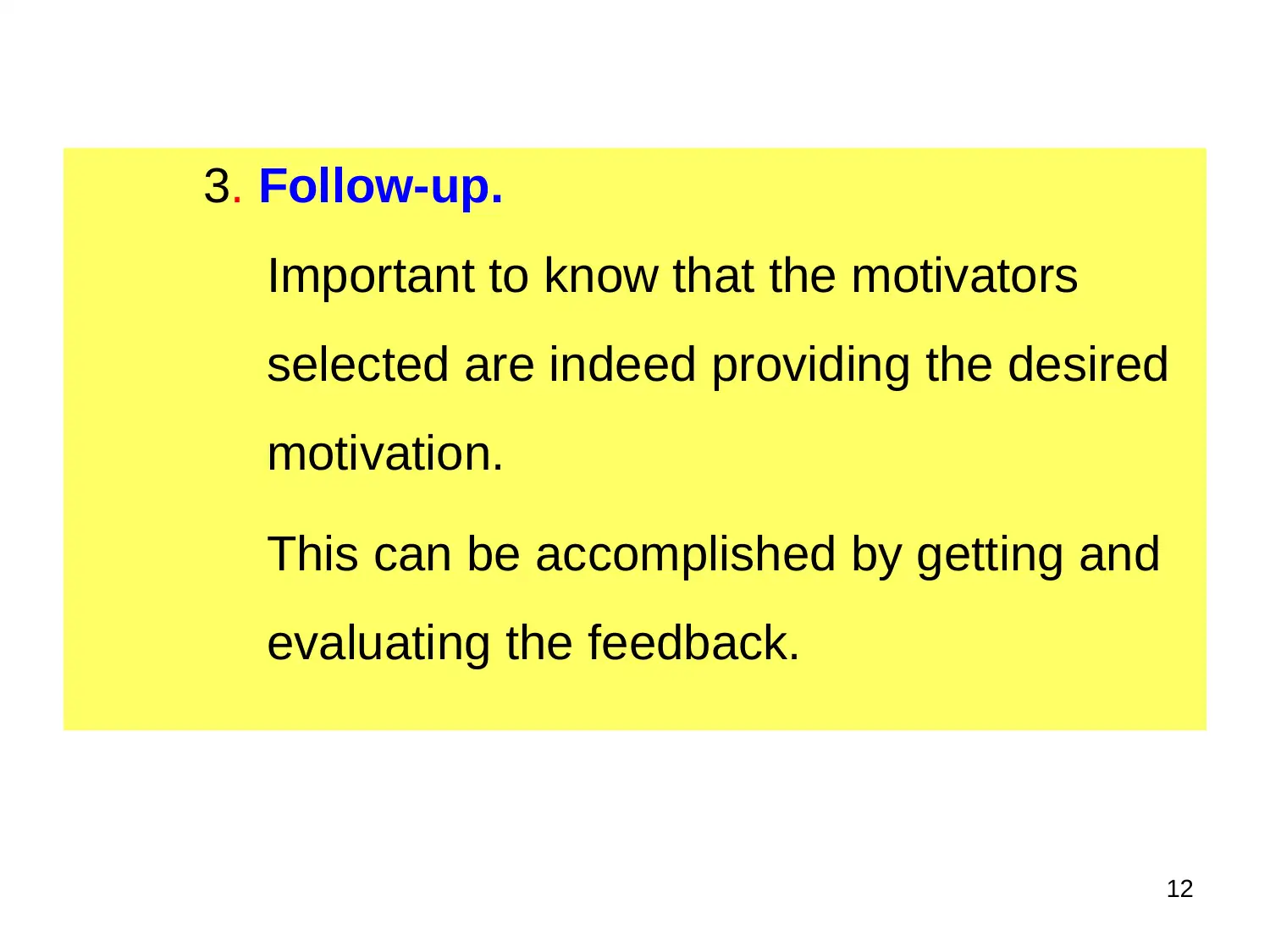
12
3. Follow-up.
Important to know that the motivators
selected are indeed providing the desired
motivation.
This can be accomplished by getting and
evaluating the feedback.
3. Follow-up.
Important to know that the motivators
selected are indeed providing the desired
motivation.
This can be accomplished by getting and
evaluating the feedback.
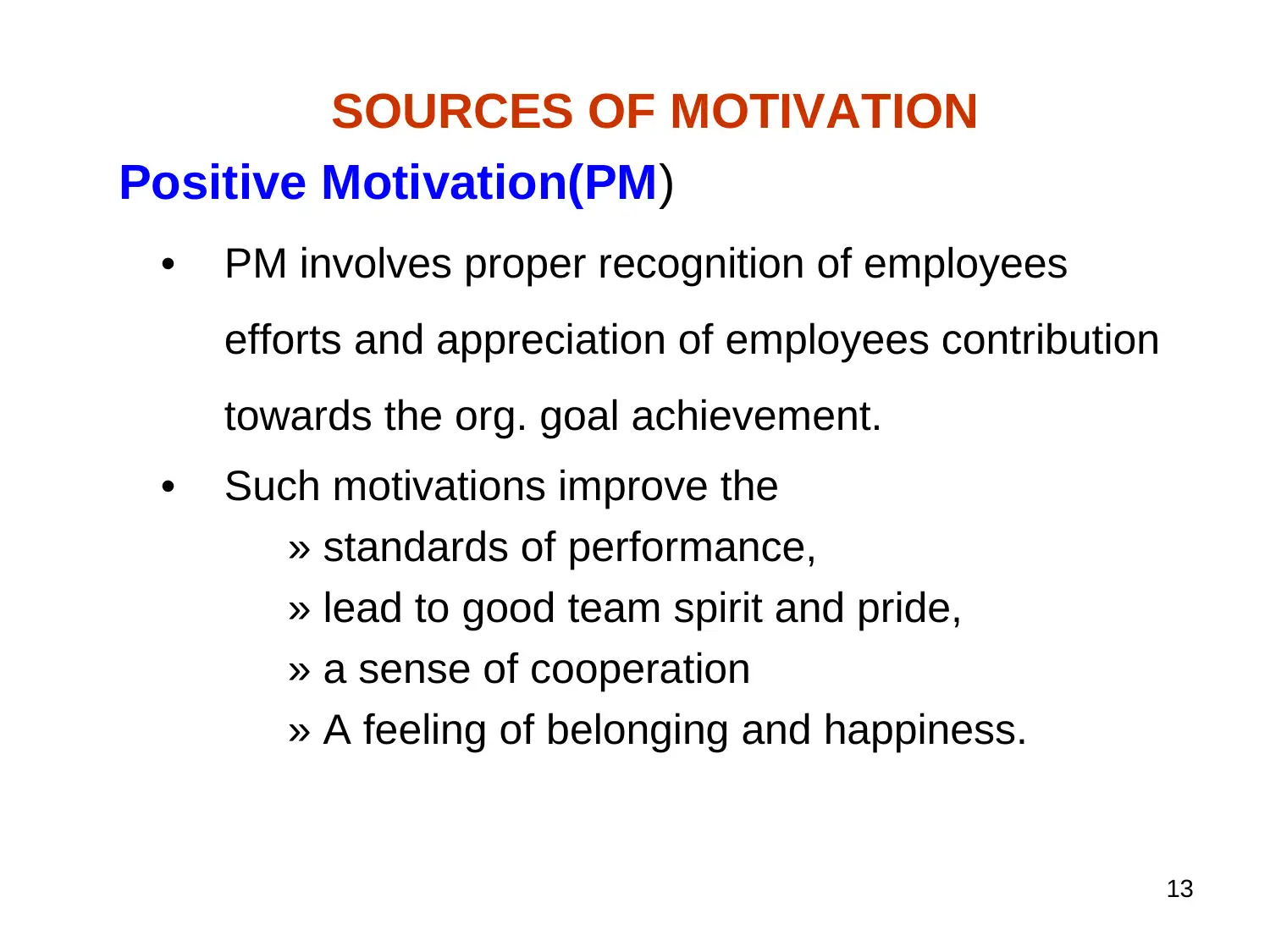
13
SOURCES OF MOTIVATION
Positive Motivation(PM)
• PM involves proper recognition of employees
efforts and appreciation of employees contribution
towards the org. goal achievement.
• Such motivations improve the
» standards of performance,
» lead to good team spirit and pride,
» a sense of cooperation
» A feeling of belonging and happiness.
SOURCES OF MOTIVATION
Positive Motivation(PM)
• PM involves proper recognition of employees
efforts and appreciation of employees contribution
towards the org. goal achievement.
• Such motivations improve the
» standards of performance,
» lead to good team spirit and pride,
» a sense of cooperation
» A feeling of belonging and happiness.
Paraphrase This Document
Need a fresh take? Get an instant paraphrase of this document with our AI Paraphraser
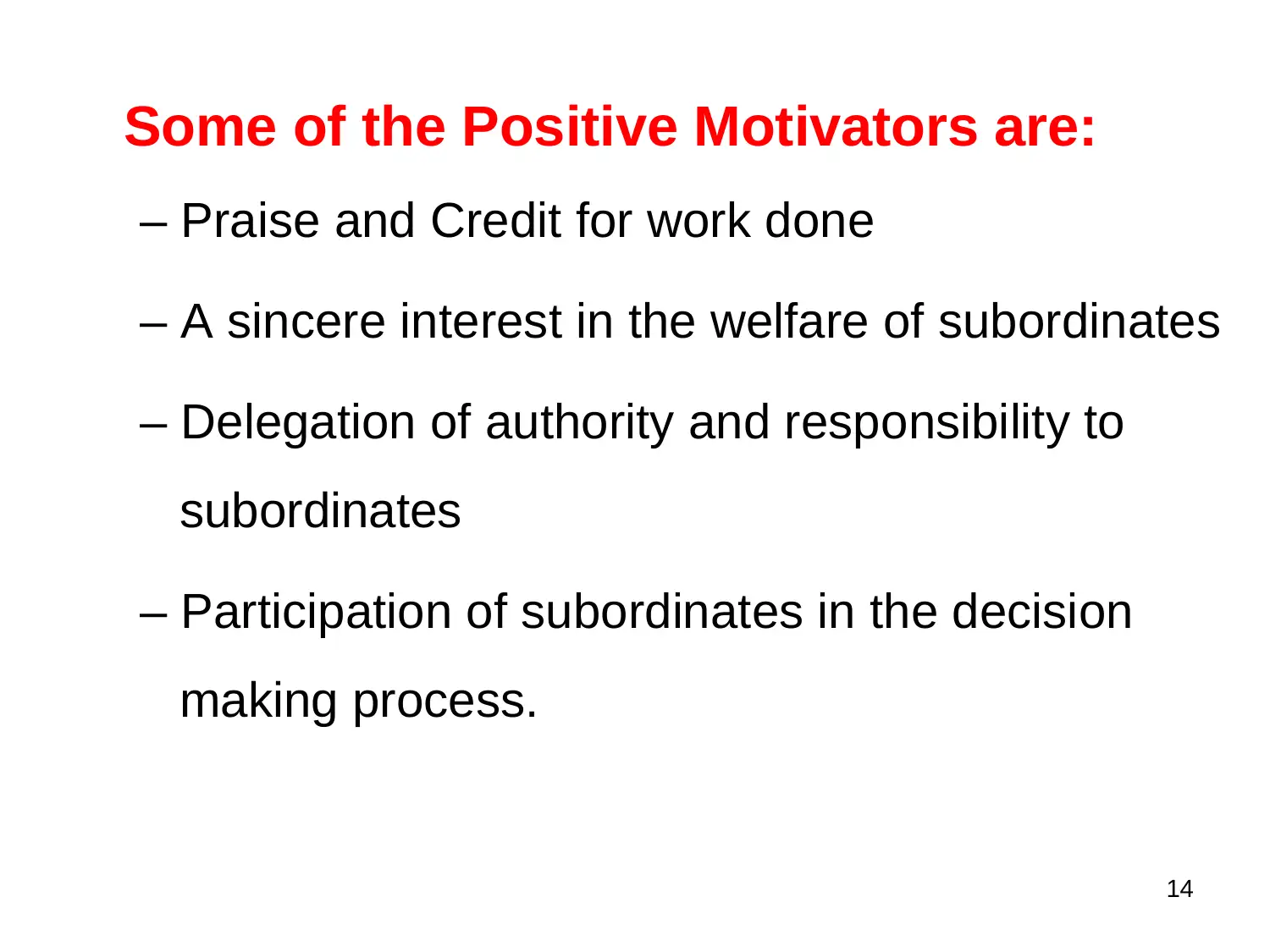
14
Some of the Positive Motivators are:
– Praise and Credit for work done
– A sincere interest in the welfare of subordinates
– Delegation of authority and responsibility to
subordinates
– Participation of subordinates in the decision
making process.
Some of the Positive Motivators are:
– Praise and Credit for work done
– A sincere interest in the welfare of subordinates
– Delegation of authority and responsibility to
subordinates
– Participation of subordinates in the decision
making process.
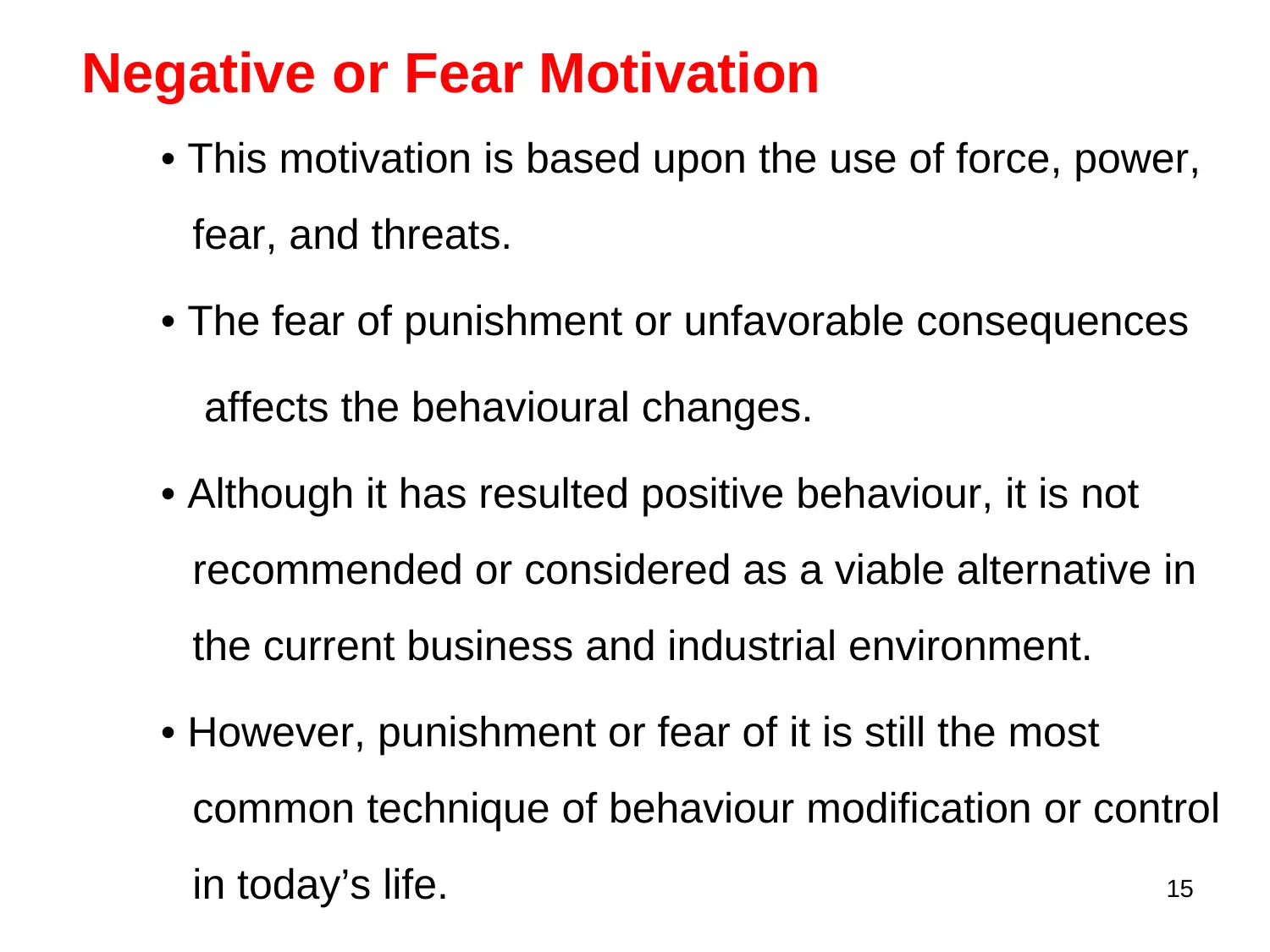
15
Negative or Fear Motivation
• This motivation is based upon the use of force, power,
fear, and threats.
• The fear of punishment or unfavorable consequences
affects the behavioural changes.
• Although it has resulted positive behaviour, it is not
recommended or considered as a viable alternative in
the current business and industrial environment.
• However, punishment or fear of it is still the most
common technique of behaviour modification or control
in today’s life.
Negative or Fear Motivation
• This motivation is based upon the use of force, power,
fear, and threats.
• The fear of punishment or unfavorable consequences
affects the behavioural changes.
• Although it has resulted positive behaviour, it is not
recommended or considered as a viable alternative in
the current business and industrial environment.
• However, punishment or fear of it is still the most
common technique of behaviour modification or control
in today’s life.
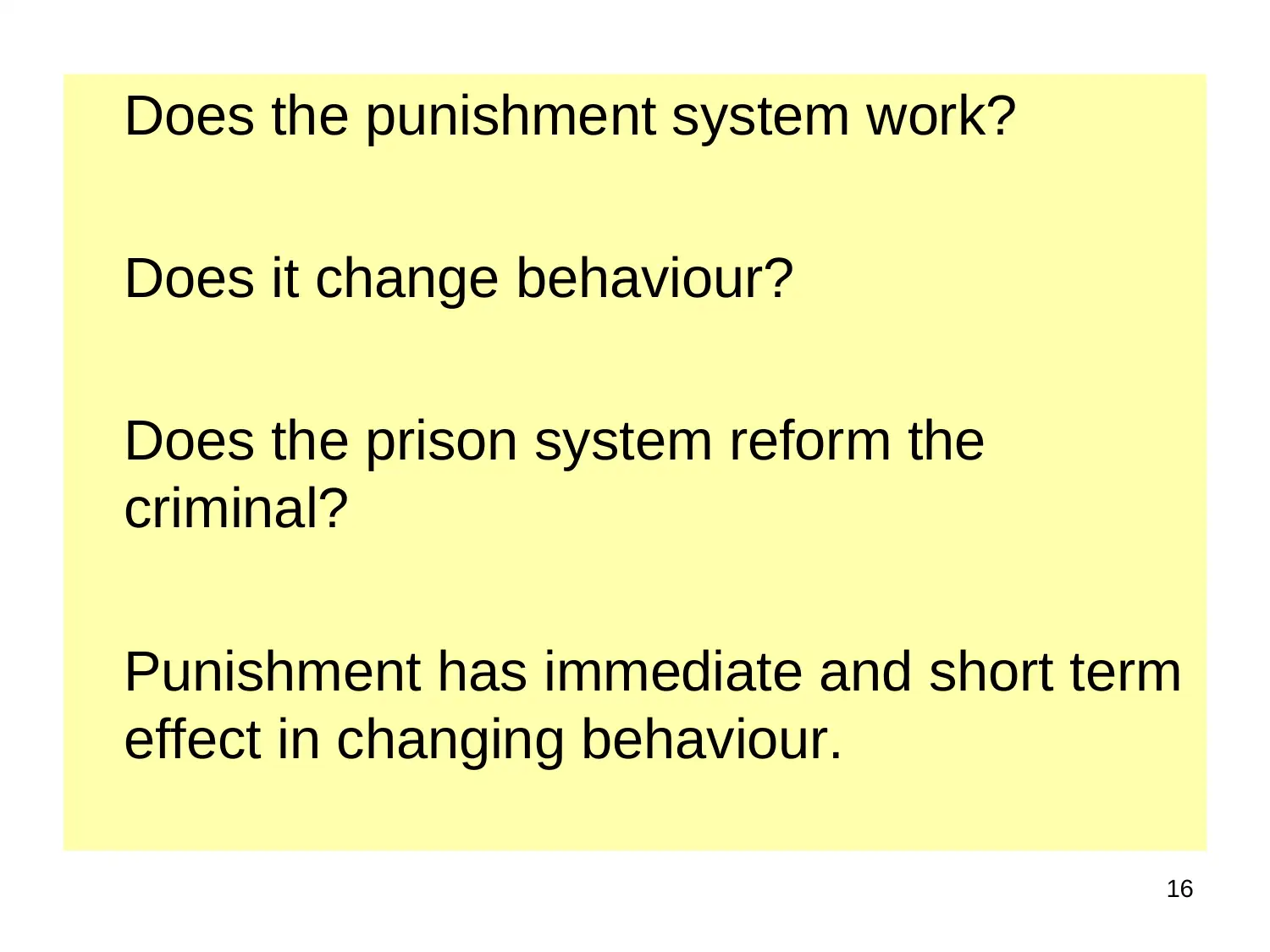
16
Does the punishment system work?
Does it change behaviour?
Does the prison system reform the
criminal?
Punishment has immediate and short term
effect in changing behaviour.
Does the punishment system work?
Does it change behaviour?
Does the prison system reform the
criminal?
Punishment has immediate and short term
effect in changing behaviour.
Secure Best Marks with AI Grader
Need help grading? Try our AI Grader for instant feedback on your assignments.
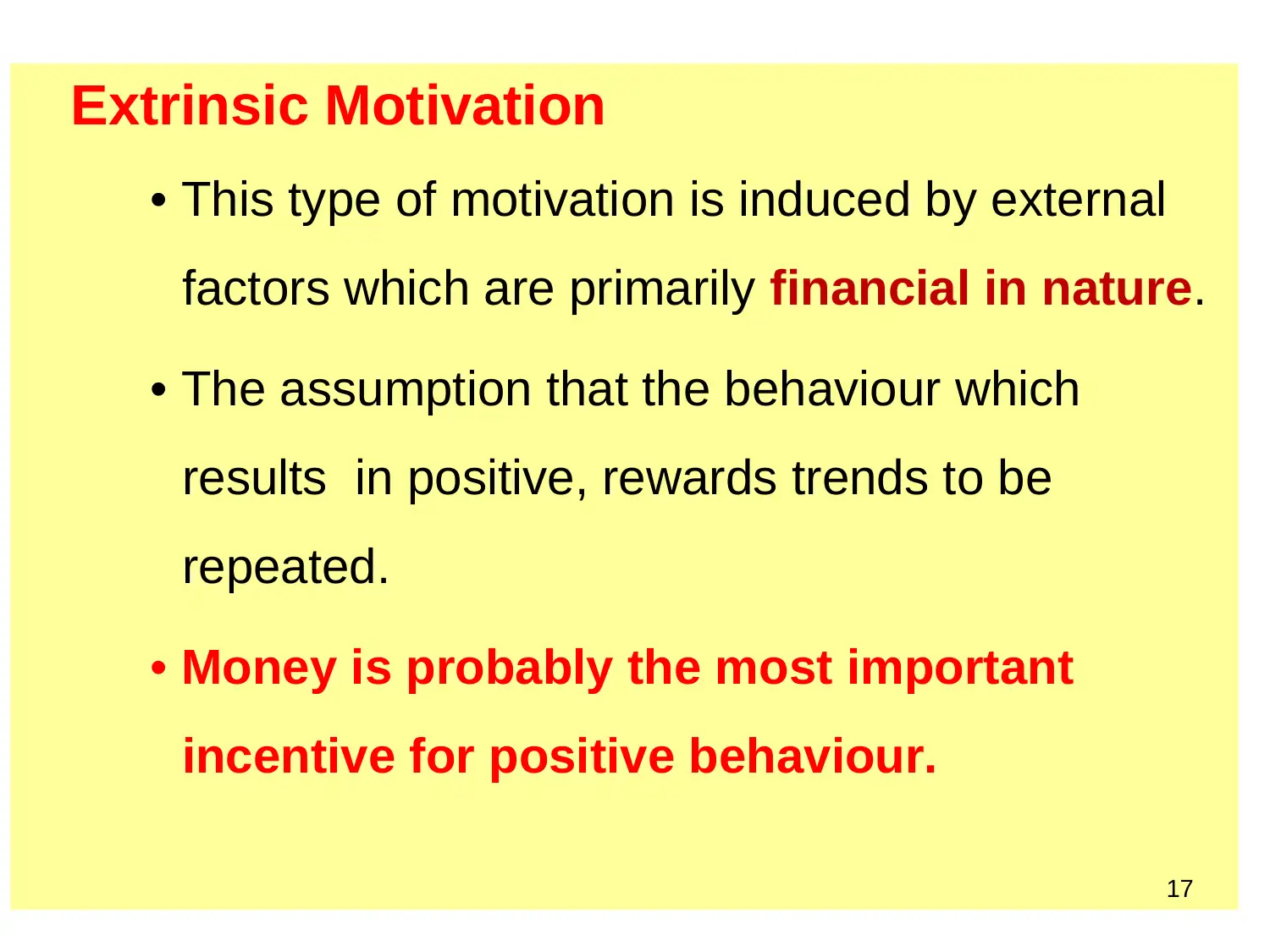
17
Extrinsic Motivation
• This type of motivation is induced by external
factors which are primarily financial in nature.
• The assumption that the behaviour which
results in positive, rewards trends to be
repeated.
• Money is probably the most important
incentive for positive behaviour.
Extrinsic Motivation
• This type of motivation is induced by external
factors which are primarily financial in nature.
• The assumption that the behaviour which
results in positive, rewards trends to be
repeated.
• Money is probably the most important
incentive for positive behaviour.
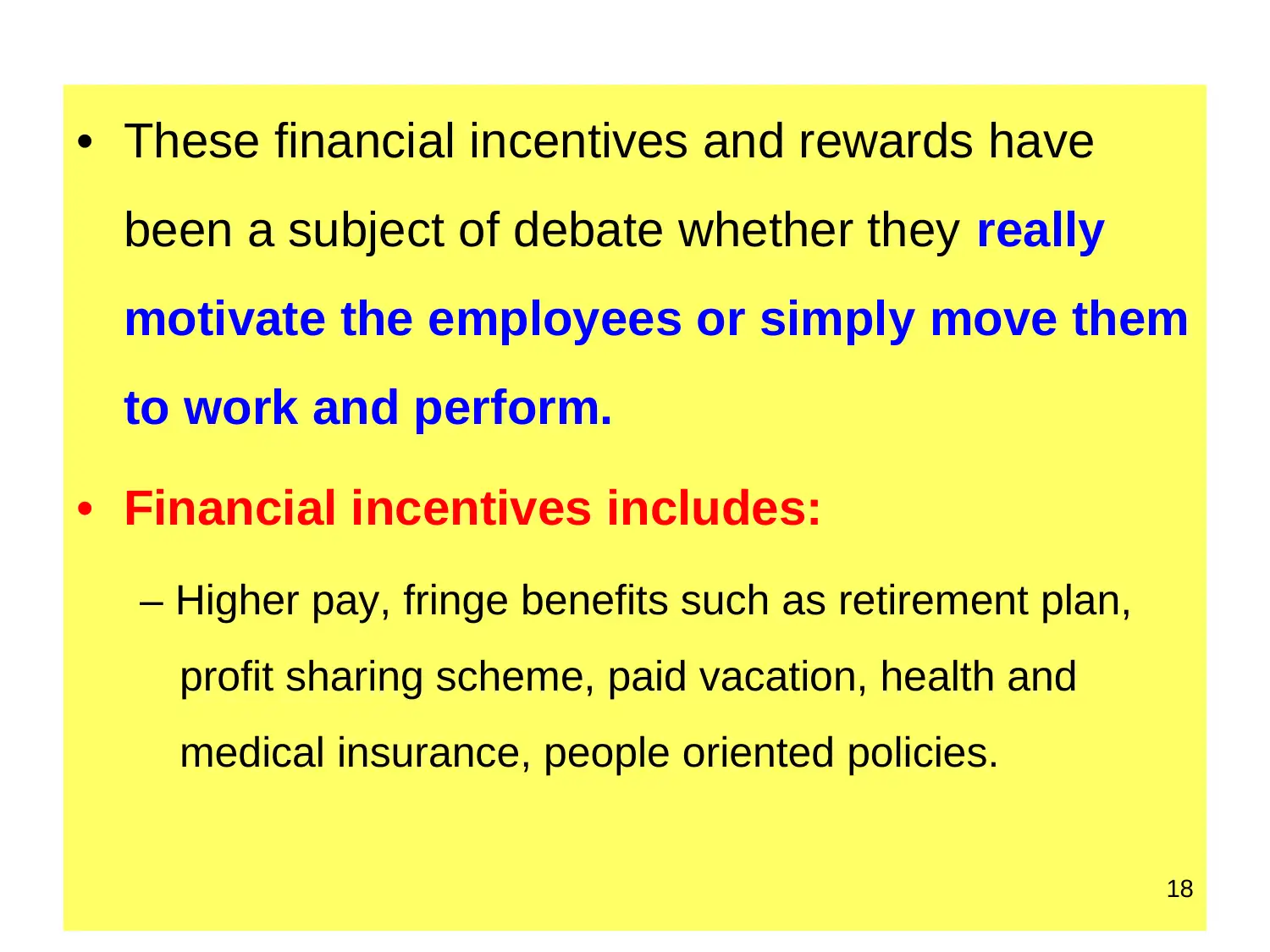
18
• These financial incentives and rewards have
been a subject of debate whether they really
motivate the employees or simply move them
to work and perform.
• Financial incentives includes:
– Higher pay, fringe benefits such as retirement plan,
profit sharing scheme, paid vacation, health and
medical insurance, people oriented policies.
• These financial incentives and rewards have
been a subject of debate whether they really
motivate the employees or simply move them
to work and perform.
• Financial incentives includes:
– Higher pay, fringe benefits such as retirement plan,
profit sharing scheme, paid vacation, health and
medical insurance, people oriented policies.
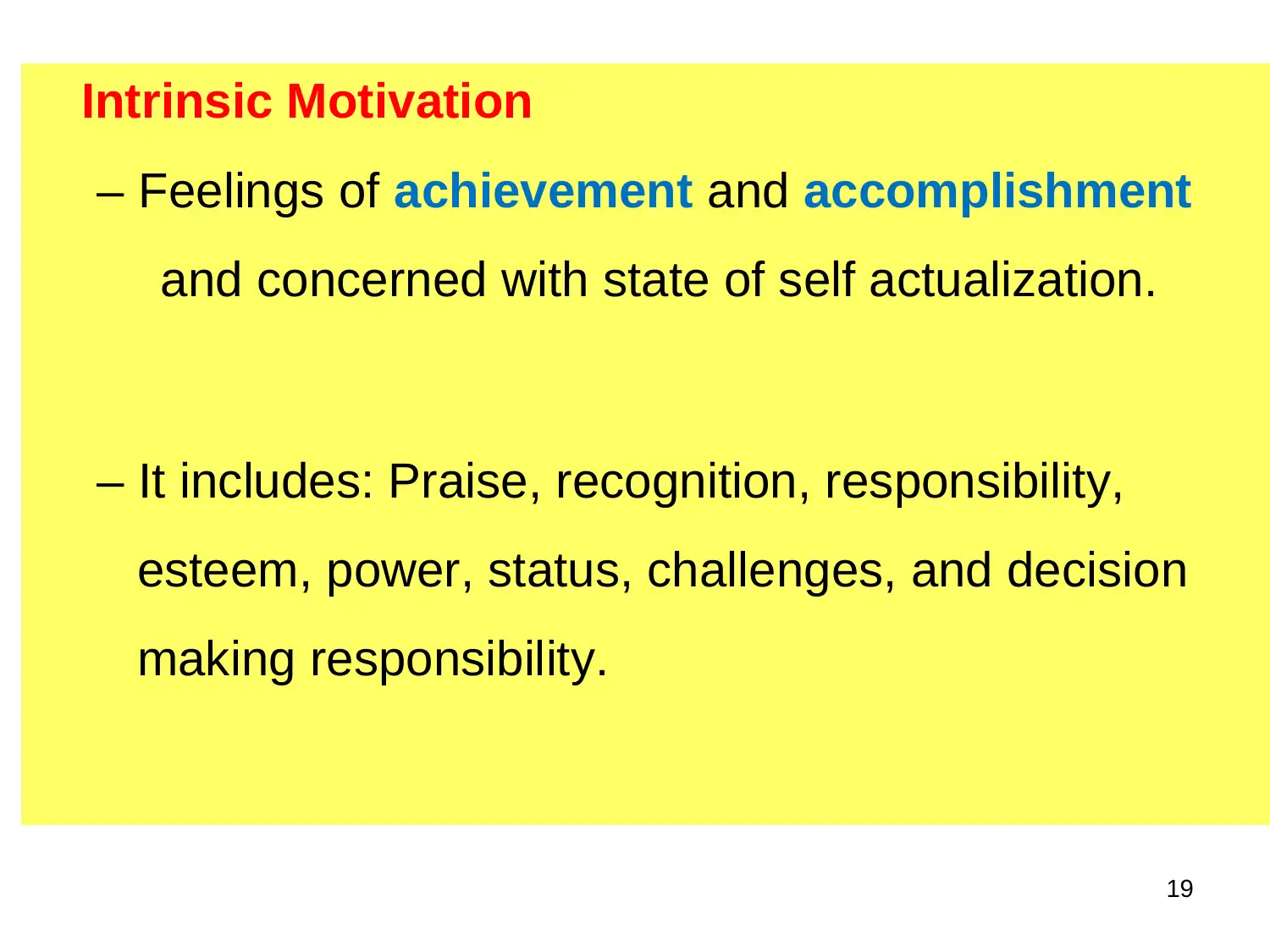
19
Intrinsic Motivation
– Feelings of achievement and accomplishment
and concerned with state of self actualization.
– It includes: Praise, recognition, responsibility,
esteem, power, status, challenges, and decision
making responsibility.
Intrinsic Motivation
– Feelings of achievement and accomplishment
and concerned with state of self actualization.
– It includes: Praise, recognition, responsibility,
esteem, power, status, challenges, and decision
making responsibility.
Paraphrase This Document
Need a fresh take? Get an instant paraphrase of this document with our AI Paraphraser
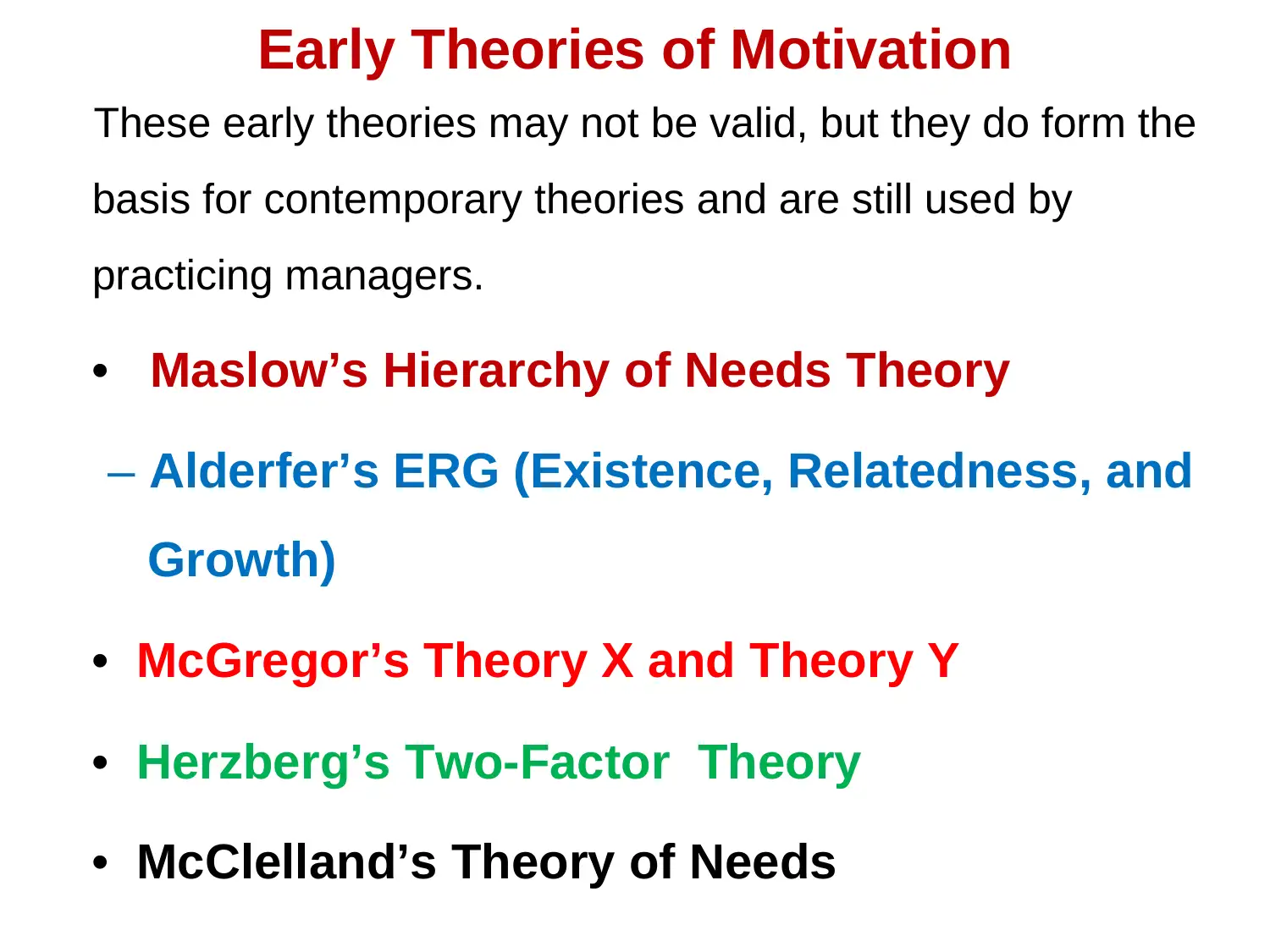
Early Theories of Motivation
These early theories may not be valid, but they do form the
basis for contemporary theories and are still used by
practicing managers.
• Maslow’s Hierarchy of Needs Theory
– Alderfer’s ERG (Existence, Relatedness, and
Growth)
• McGregor’s Theory X and Theory Y
• Herzberg’s Two-Factor Theory
• McClelland’s Theory of Needs
These early theories may not be valid, but they do form the
basis for contemporary theories and are still used by
practicing managers.
• Maslow’s Hierarchy of Needs Theory
– Alderfer’s ERG (Existence, Relatedness, and
Growth)
• McGregor’s Theory X and Theory Y
• Herzberg’s Two-Factor Theory
• McClelland’s Theory of Needs
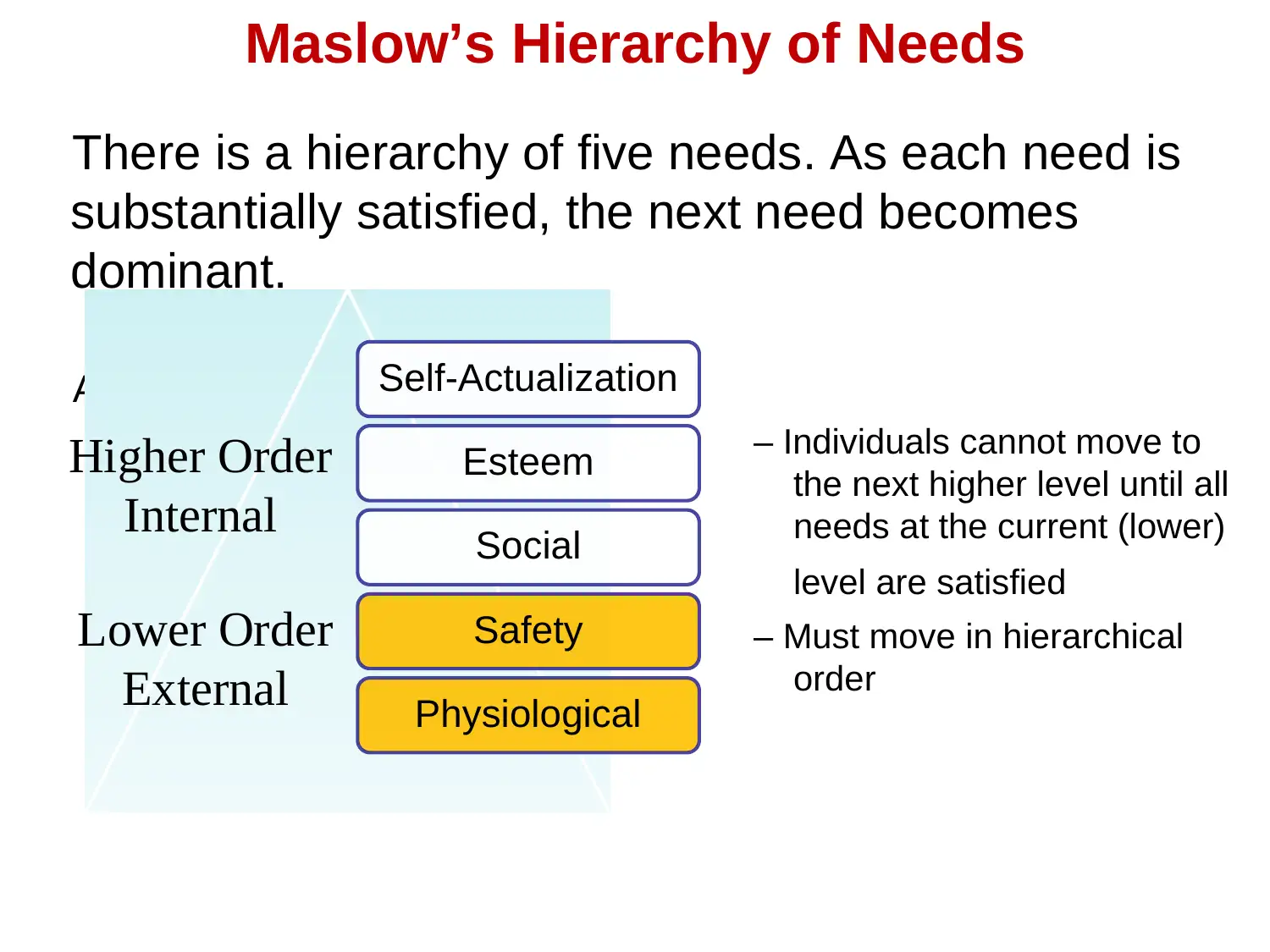
Maslow’s Hierarchy of Needs
There is a hierarchy of five needs. As each need is
substantially satisfied, the next need becomes
dominant.
Assumptions
– Individuals cannot move to
the next higher level until all
needs at the current (lower)
level are satisfied
– Must move in hierarchical
order
Self-Actualization
Esteem
Social
Safety
Physiological
Lower Order
External
Higher Order
Internal
There is a hierarchy of five needs. As each need is
substantially satisfied, the next need becomes
dominant.
Assumptions
– Individuals cannot move to
the next higher level until all
needs at the current (lower)
level are satisfied
– Must move in hierarchical
order
Self-Actualization
Esteem
Social
Safety
Physiological
Lower Order
External
Higher Order
Internal
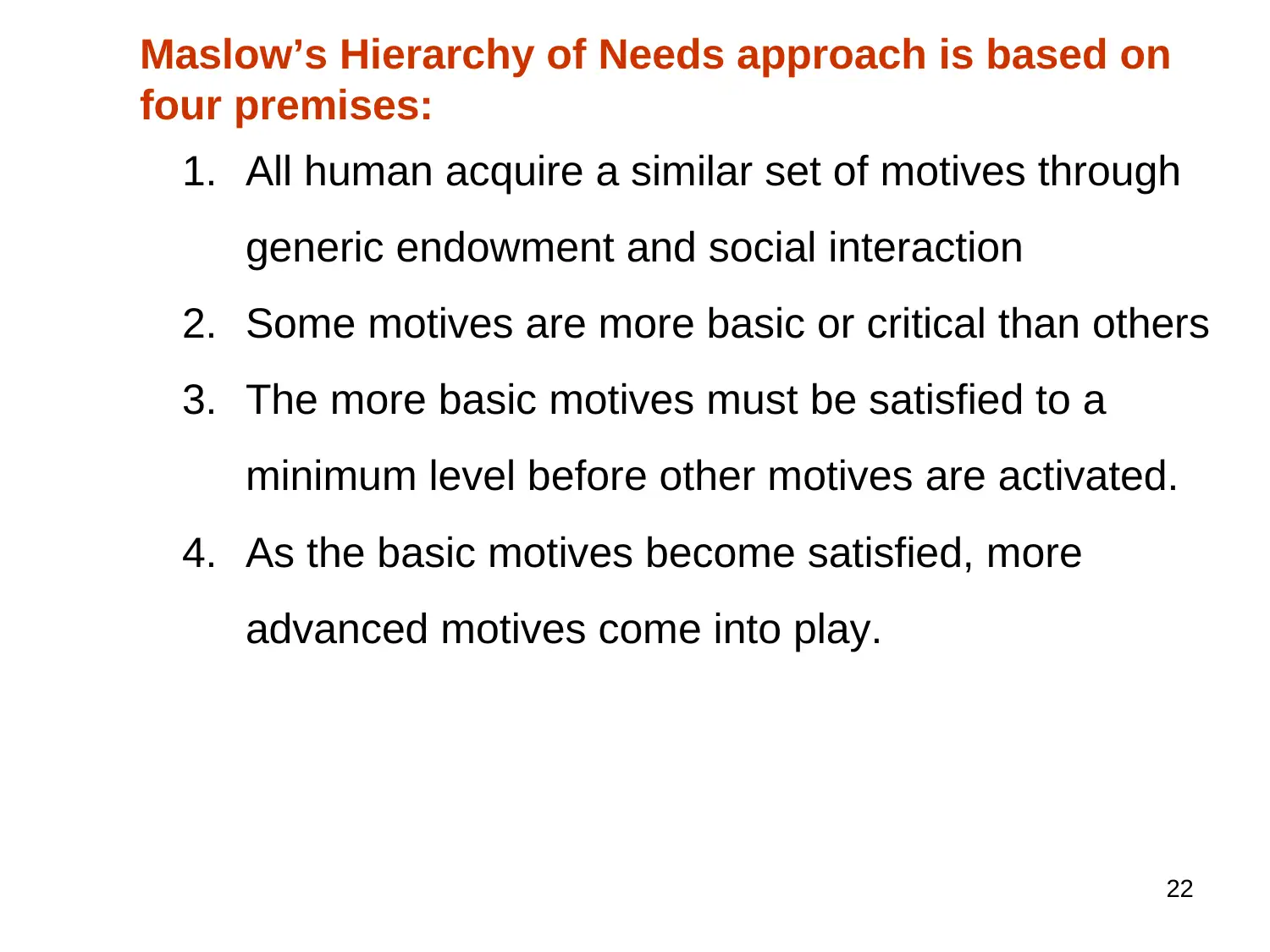
22
Maslow’s Hierarchy of Needs approach is based on
four premises:
1. All human acquire a similar set of motives through
generic endowment and social interaction
2. Some motives are more basic or critical than others
3. The more basic motives must be satisfied to a
minimum level before other motives are activated.
4. As the basic motives become satisfied, more
advanced motives come into play.
Maslow’s Hierarchy of Needs approach is based on
four premises:
1. All human acquire a similar set of motives through
generic endowment and social interaction
2. Some motives are more basic or critical than others
3. The more basic motives must be satisfied to a
minimum level before other motives are activated.
4. As the basic motives become satisfied, more
advanced motives come into play.
Secure Best Marks with AI Grader
Need help grading? Try our AI Grader for instant feedback on your assignments.
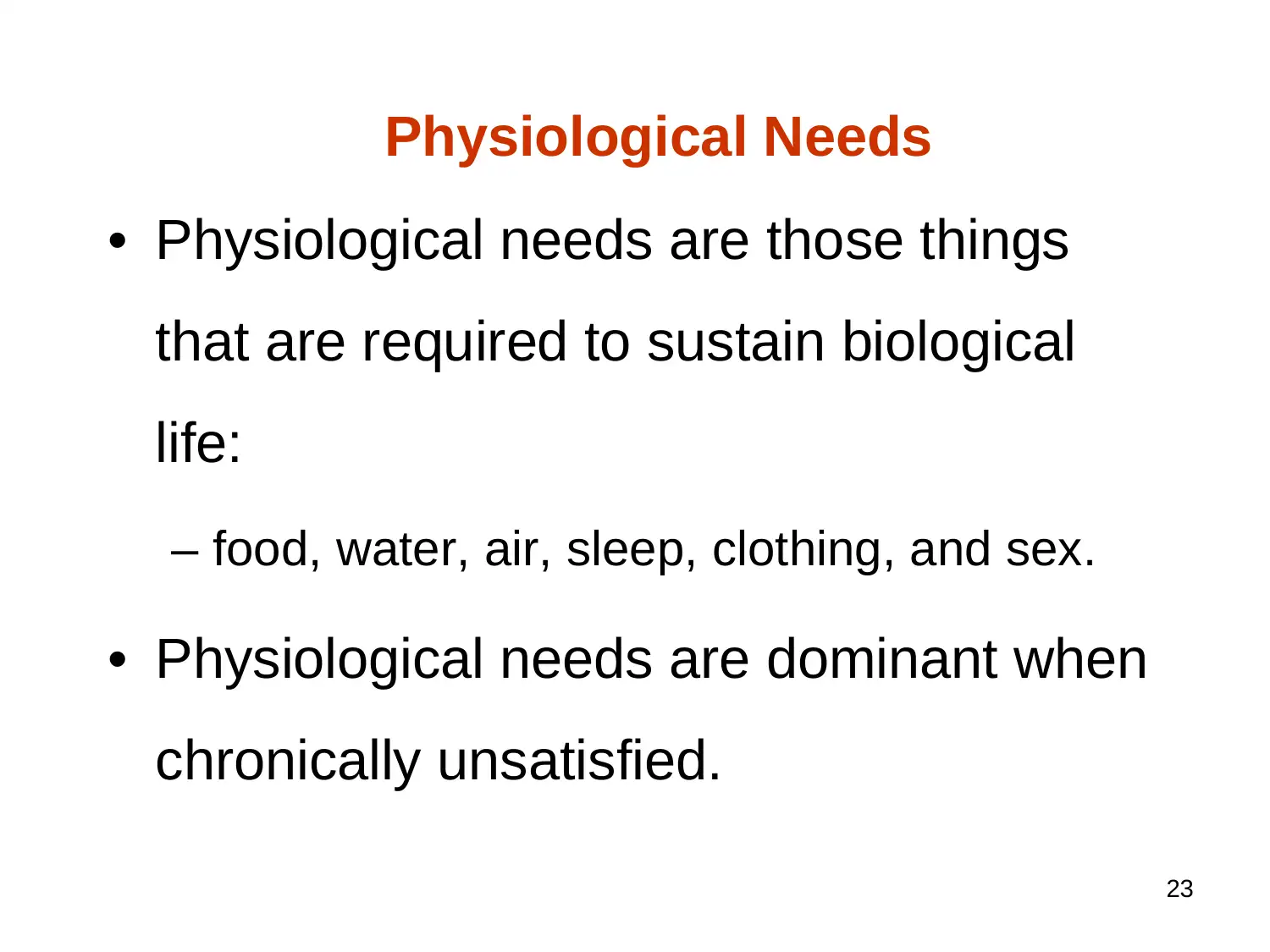
23
Physiological Needs
• Physiological needs are those things
that are required to sustain biological
life:
– food, water, air, sleep, clothing, and sex.
• Physiological needs are dominant when
chronically unsatisfied.
Physiological Needs
• Physiological needs are those things
that are required to sustain biological
life:
– food, water, air, sleep, clothing, and sex.
• Physiological needs are dominant when
chronically unsatisfied.
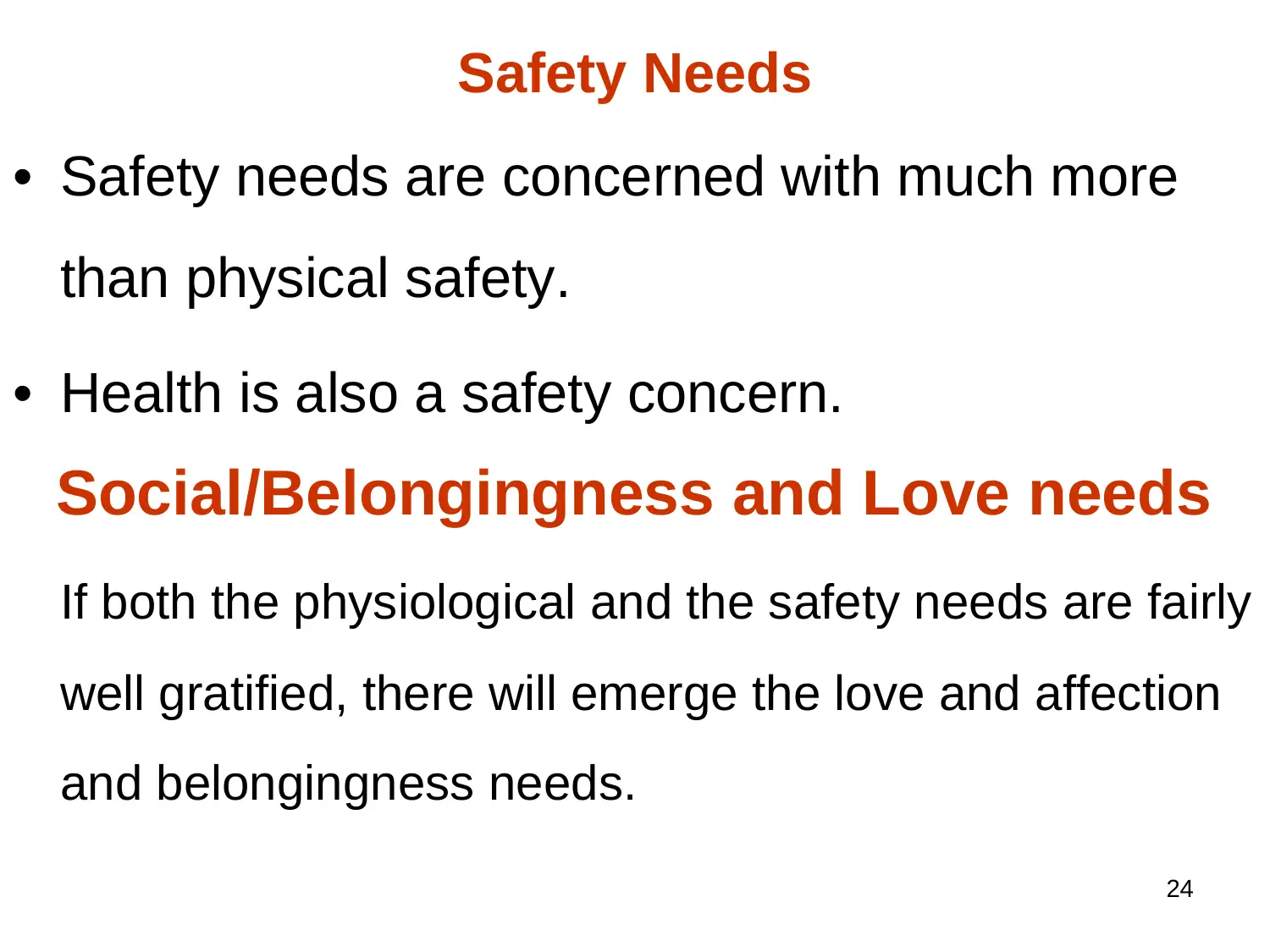
24
Safety Needs
• Safety needs are concerned with much more
than physical safety.
• Health is also a safety concern.
Social/Belongingness and Love needs
If both the physiological and the safety needs are fairly
well gratified, there will emerge the love and affection
and belongingness needs.
Safety Needs
• Safety needs are concerned with much more
than physical safety.
• Health is also a safety concern.
Social/Belongingness and Love needs
If both the physiological and the safety needs are fairly
well gratified, there will emerge the love and affection
and belongingness needs.
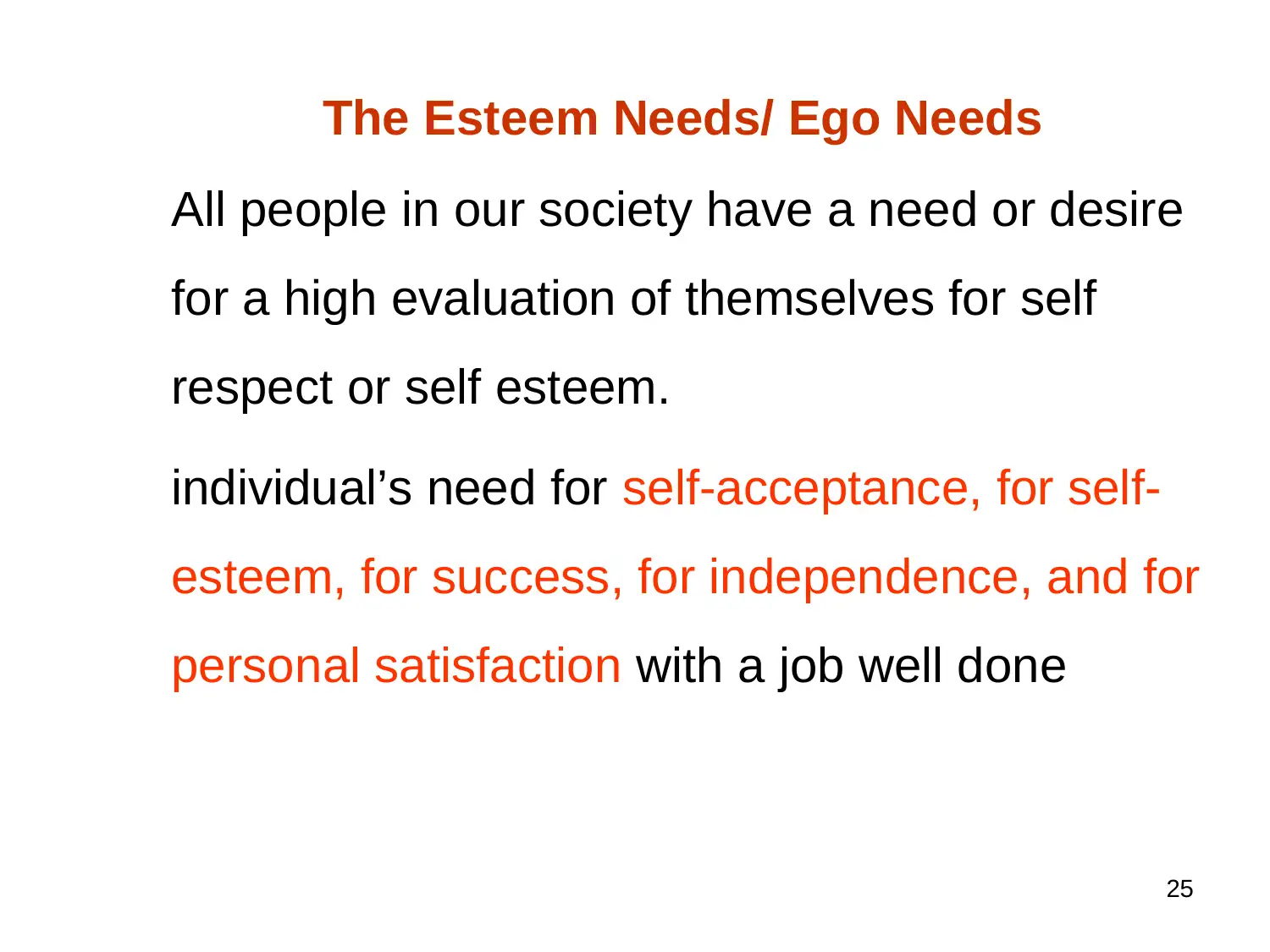
25
The Esteem Needs/ Ego Needs
All people in our society have a need or desire
for a high evaluation of themselves for self
respect or self esteem.
individual’s need for self-acceptance, for self-
esteem, for success, for independence, and for
personal satisfaction with a job well done
The Esteem Needs/ Ego Needs
All people in our society have a need or desire
for a high evaluation of themselves for self
respect or self esteem.
individual’s need for self-acceptance, for self-
esteem, for success, for independence, and for
personal satisfaction with a job well done
Paraphrase This Document
Need a fresh take? Get an instant paraphrase of this document with our AI Paraphraser
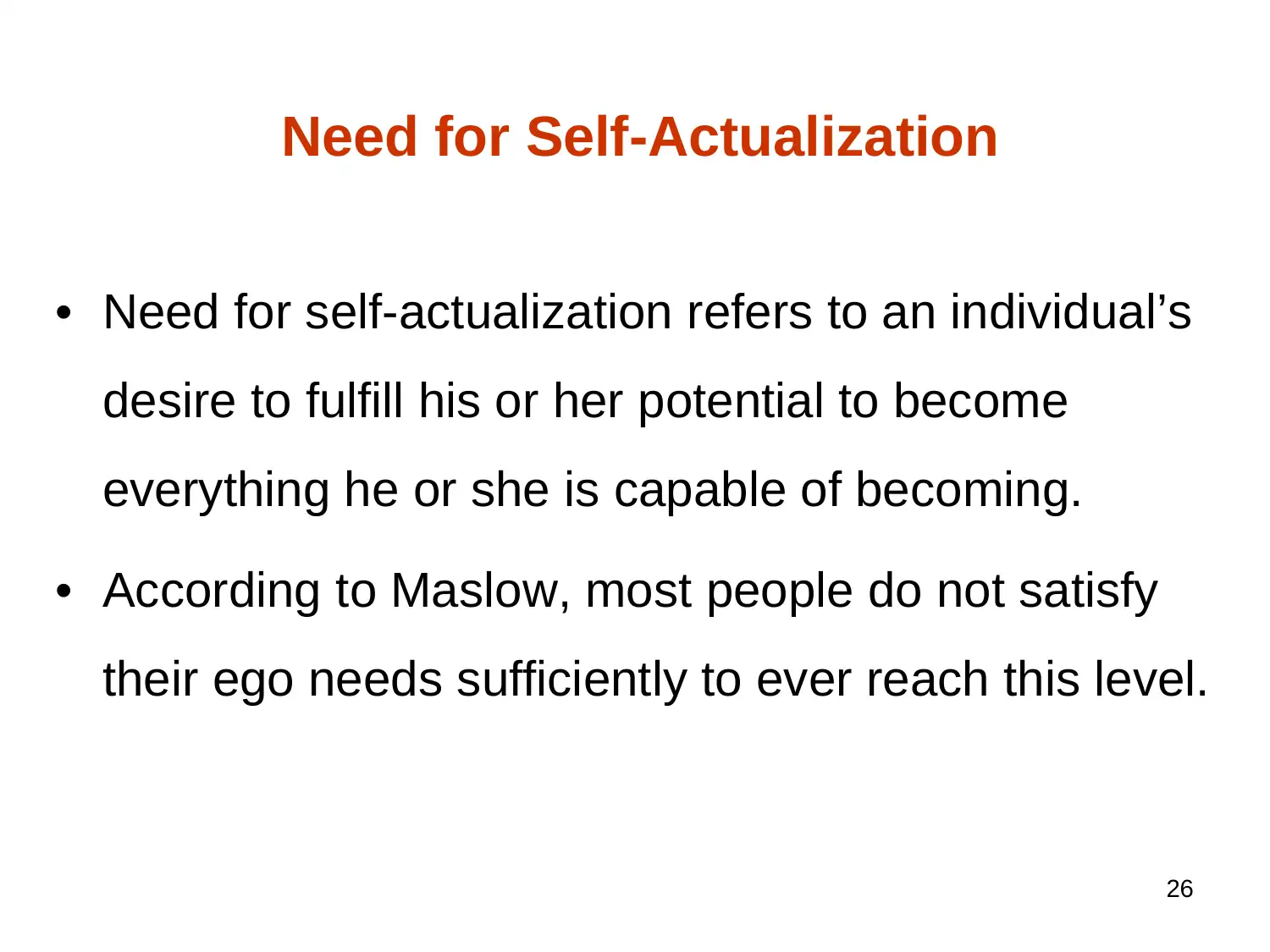
26
Need for Self-Actualization
• Need for self-actualization refers to an individual’s
desire to fulfill his or her potential to become
everything he or she is capable of becoming.
• According to Maslow, most people do not satisfy
their ego needs sufficiently to ever reach this level.
Need for Self-Actualization
• Need for self-actualization refers to an individual’s
desire to fulfill his or her potential to become
everything he or she is capable of becoming.
• According to Maslow, most people do not satisfy
their ego needs sufficiently to ever reach this level.
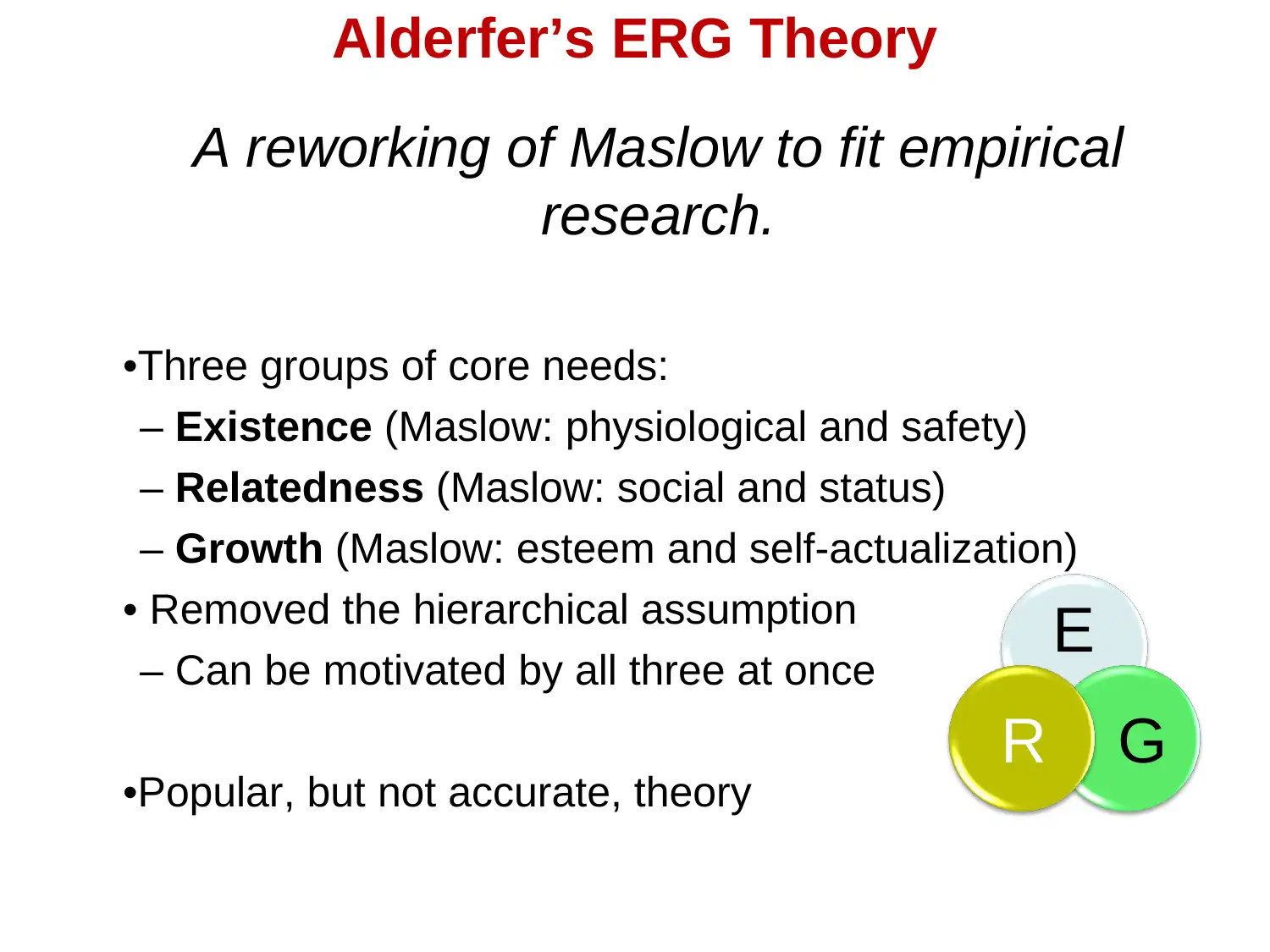
Alderfer’s ERG Theory
A reworking of Maslow to fit empirical
research.
•Three groups of core needs:
– Existence (Maslow: physiological and safety)
– Relatedness (Maslow: social and status)
– Growth (Maslow: esteem and self-actualization)
• Removed the hierarchical assumption
– Can be motivated by all three at once
•Popular, but not accurate, theory
E
GR
A reworking of Maslow to fit empirical
research.
•Three groups of core needs:
– Existence (Maslow: physiological and safety)
– Relatedness (Maslow: social and status)
– Growth (Maslow: esteem and self-actualization)
• Removed the hierarchical assumption
– Can be motivated by all three at once
•Popular, but not accurate, theory
E
GR
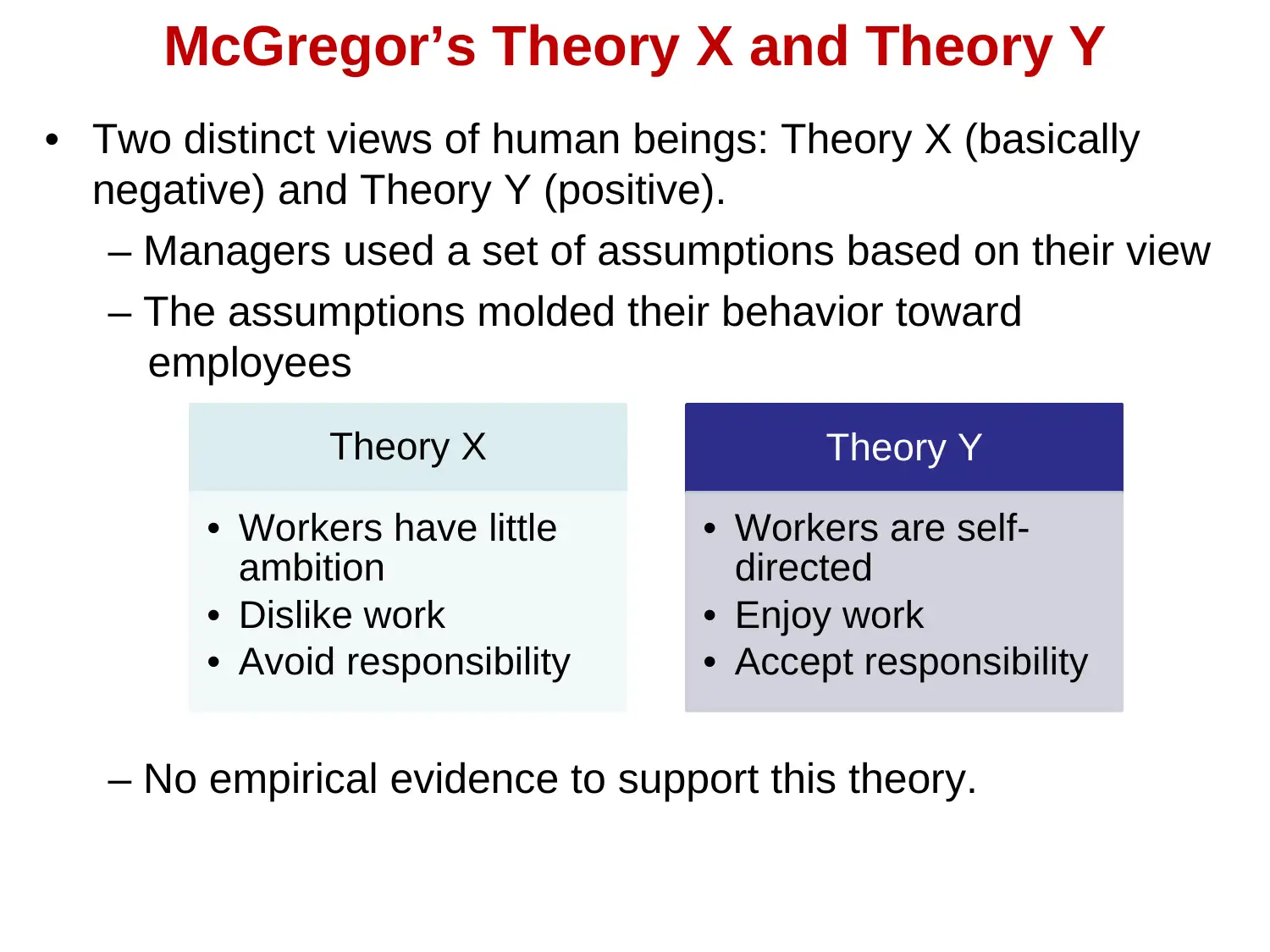
McGregor’s Theory X and Theory Y
• Two distinct views of human beings: Theory X (basically
negative) and Theory Y (positive).
– Managers used a set of assumptions based on their view
– The assumptions molded their behavior toward
employees
– No empirical evidence to support this theory.
Theory X
• Workers have little
ambition
• Dislike work
• Avoid responsibility
Theory Y
• Workers are self-
directed
• Enjoy work
• Accept responsibility
• Two distinct views of human beings: Theory X (basically
negative) and Theory Y (positive).
– Managers used a set of assumptions based on their view
– The assumptions molded their behavior toward
employees
– No empirical evidence to support this theory.
Theory X
• Workers have little
ambition
• Dislike work
• Avoid responsibility
Theory Y
• Workers are self-
directed
• Enjoy work
• Accept responsibility
Secure Best Marks with AI Grader
Need help grading? Try our AI Grader for instant feedback on your assignments.
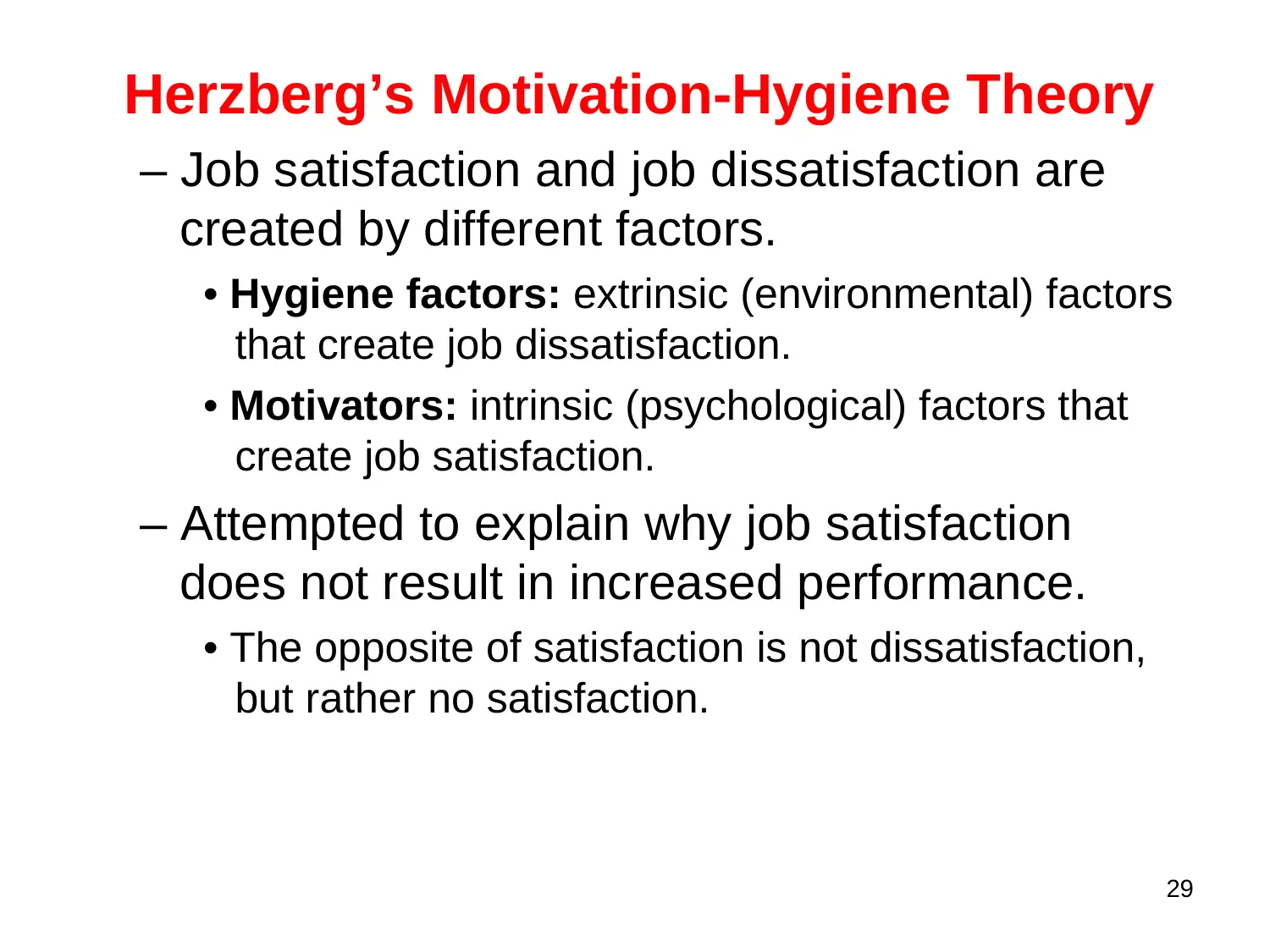
29
Herzberg’s Motivation-Hygiene Theory
– Job satisfaction and job dissatisfaction are
created by different factors.
• Hygiene factors: extrinsic (environmental) factors
that create job dissatisfaction.
• Motivators: intrinsic (psychological) factors that
create job satisfaction.
– Attempted to explain why job satisfaction
does not result in increased performance.
• The opposite of satisfaction is not dissatisfaction,
but rather no satisfaction.
Herzberg’s Motivation-Hygiene Theory
– Job satisfaction and job dissatisfaction are
created by different factors.
• Hygiene factors: extrinsic (environmental) factors
that create job dissatisfaction.
• Motivators: intrinsic (psychological) factors that
create job satisfaction.
– Attempted to explain why job satisfaction
does not result in increased performance.
• The opposite of satisfaction is not dissatisfaction,
but rather no satisfaction.
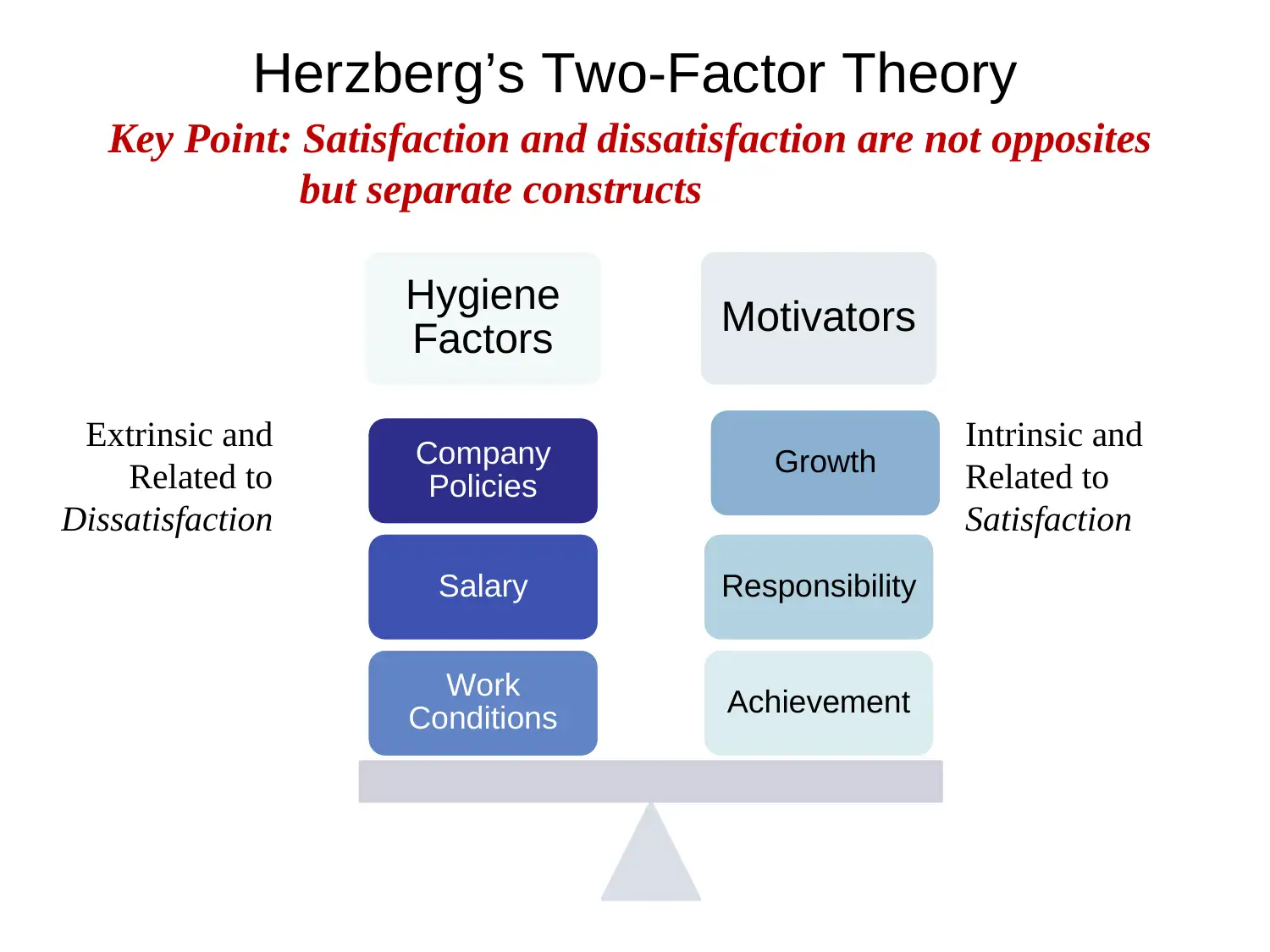
Herzberg’s Two-Factor Theory
Hygiene
Factors Motivators
Achievement
Responsibility
Growth
Work
Conditions
Salary
Company
Policies
Key Point: Satisfaction and dissatisfaction are not opposites
but separate constructs
Extrinsic and
Related to
Dissatisfaction
Intrinsic and
Related to
Satisfaction
Hygiene
Factors Motivators
Achievement
Responsibility
Growth
Work
Conditions
Salary
Company
Policies
Key Point: Satisfaction and dissatisfaction are not opposites
but separate constructs
Extrinsic and
Related to
Dissatisfaction
Intrinsic and
Related to
Satisfaction
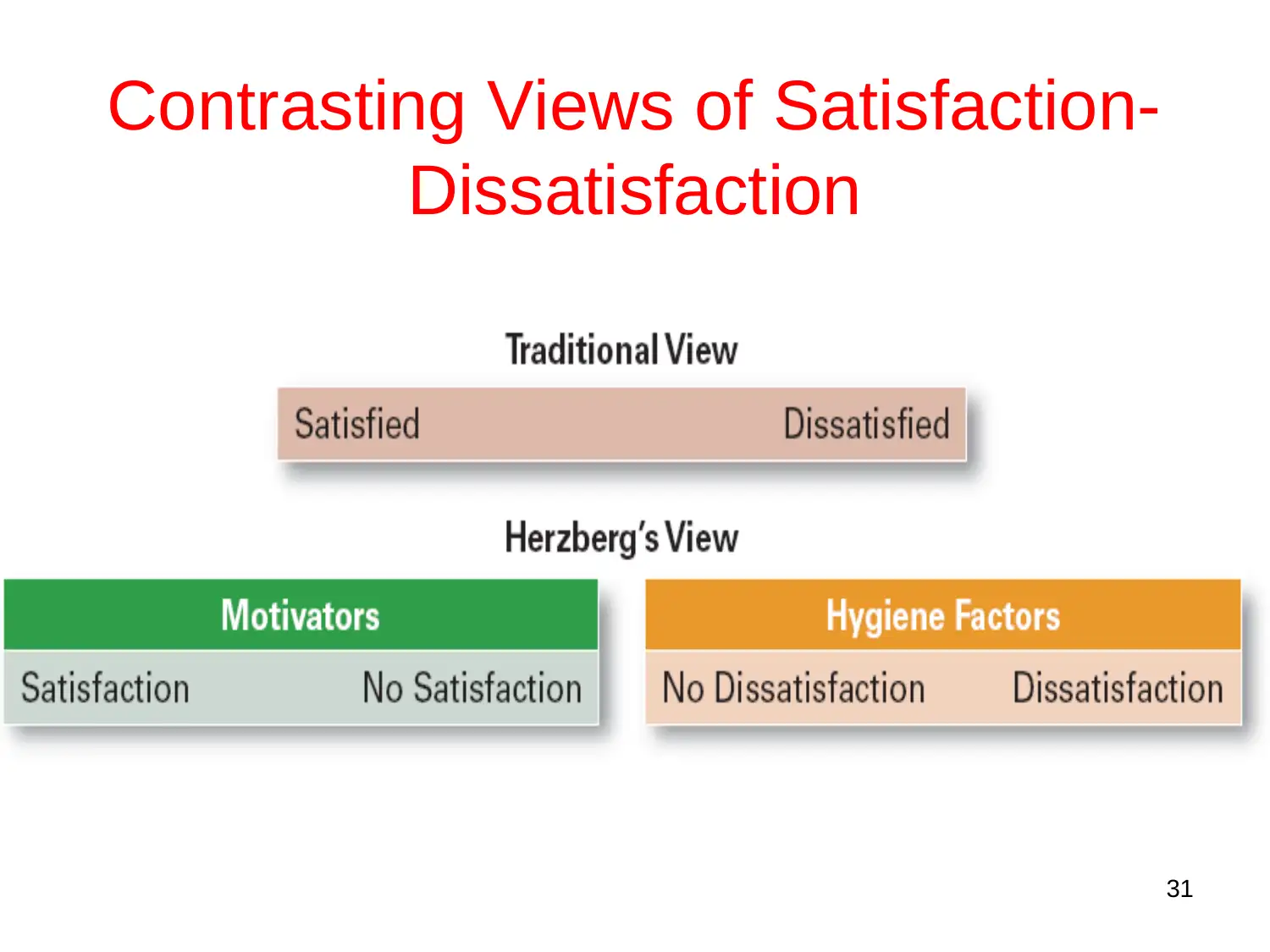
31
Contrasting Views of Satisfaction-
Dissatisfaction
Contrasting Views of Satisfaction-
Dissatisfaction
Paraphrase This Document
Need a fresh take? Get an instant paraphrase of this document with our AI Paraphraser
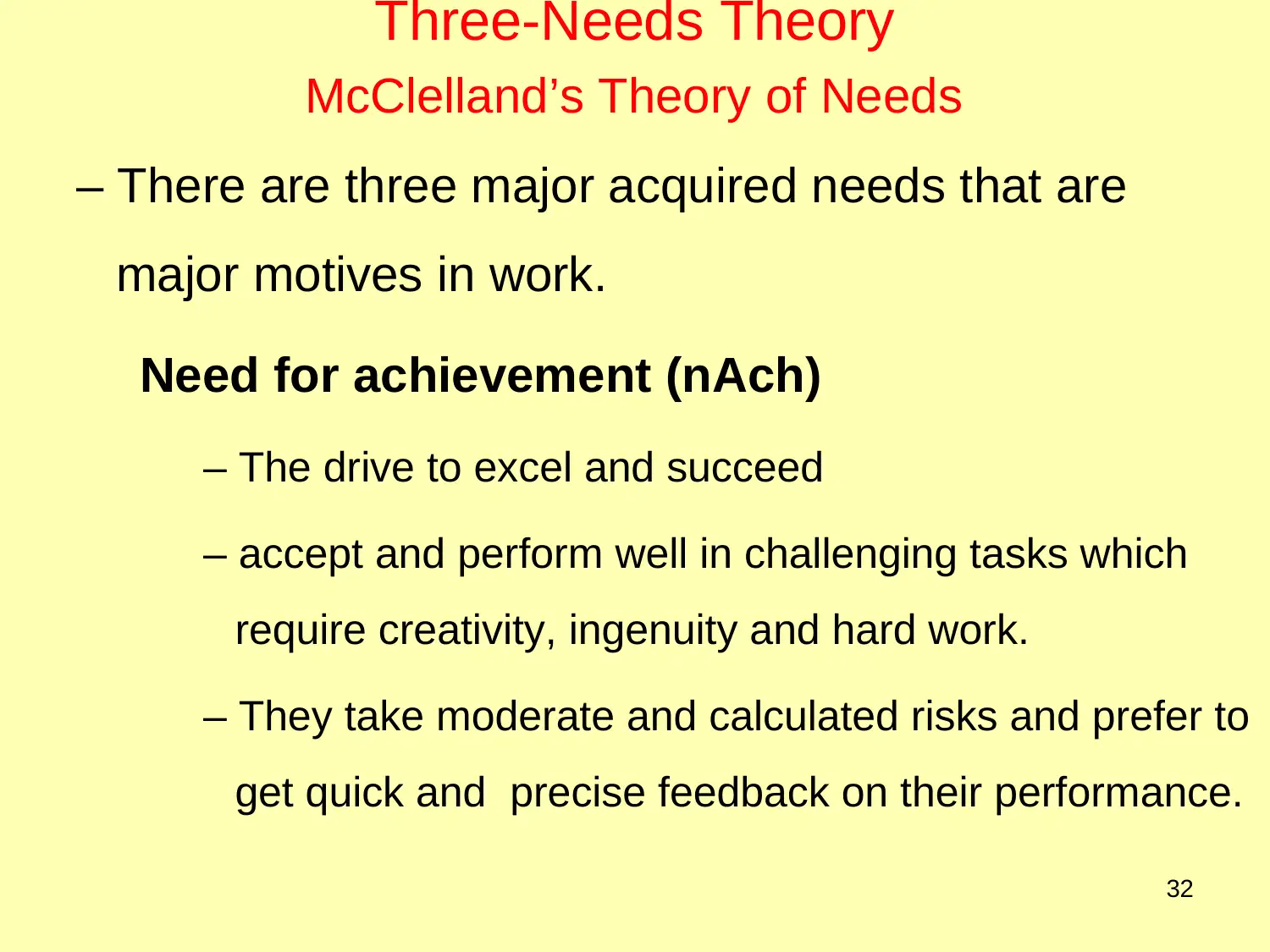
32
Three-Needs Theory
McClelland’s Theory of Needs
– There are three major acquired needs that are
major motives in work.
Need for achievement (nAch)
– The drive to excel and succeed
– accept and perform well in challenging tasks which
require creativity, ingenuity and hard work.
– They take moderate and calculated risks and prefer to
get quick and precise feedback on their performance.
Three-Needs Theory
McClelland’s Theory of Needs
– There are three major acquired needs that are
major motives in work.
Need for achievement (nAch)
– The drive to excel and succeed
– accept and perform well in challenging tasks which
require creativity, ingenuity and hard work.
– They take moderate and calculated risks and prefer to
get quick and precise feedback on their performance.
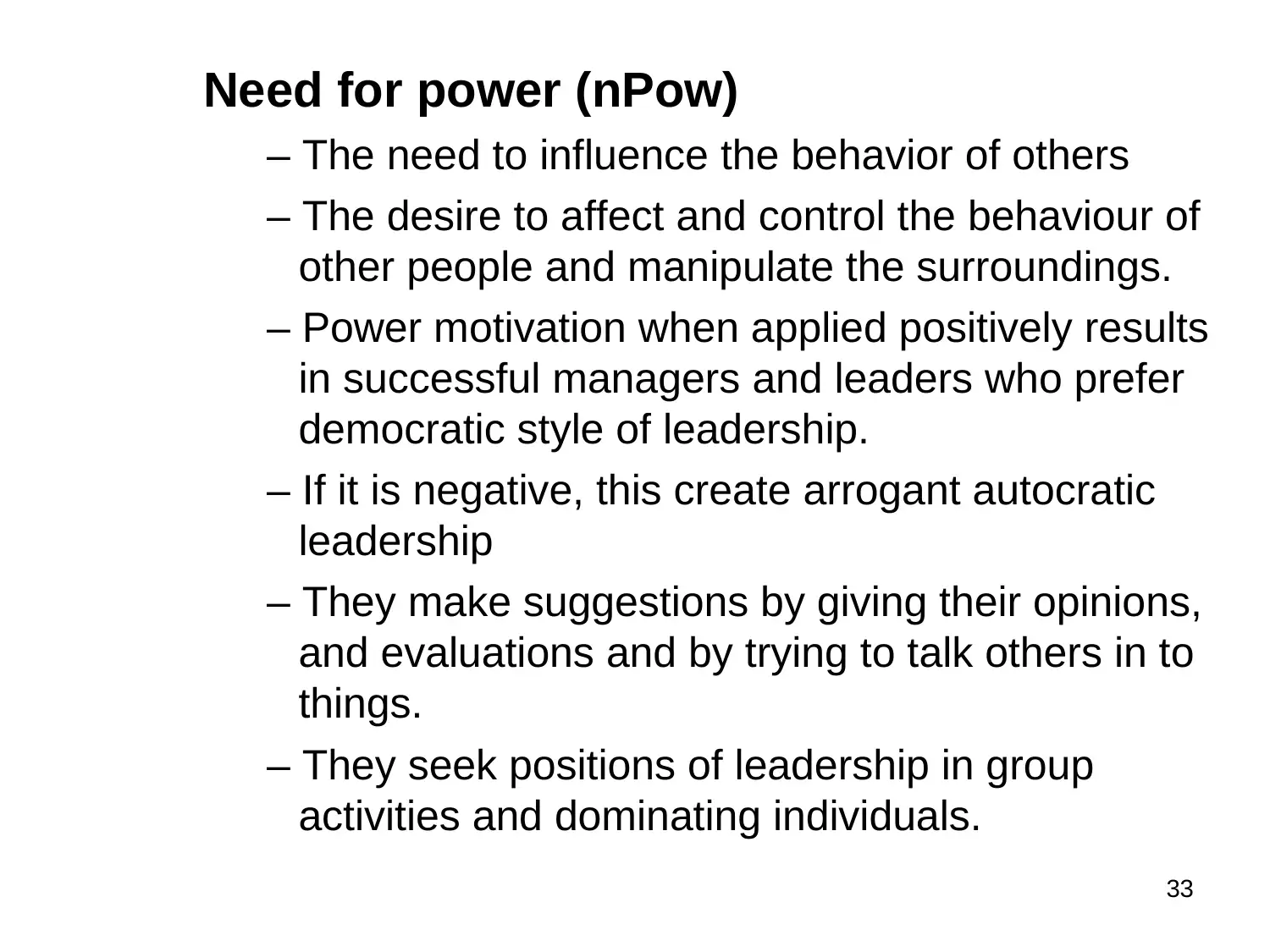
33
Need for power (nPow)
– The need to influence the behavior of others
– The desire to affect and control the behaviour of
other people and manipulate the surroundings.
– Power motivation when applied positively results
in successful managers and leaders who prefer
democratic style of leadership.
– If it is negative, this create arrogant autocratic
leadership
– They make suggestions by giving their opinions,
and evaluations and by trying to talk others in to
things.
– They seek positions of leadership in group
activities and dominating individuals.
Need for power (nPow)
– The need to influence the behavior of others
– The desire to affect and control the behaviour of
other people and manipulate the surroundings.
– Power motivation when applied positively results
in successful managers and leaders who prefer
democratic style of leadership.
– If it is negative, this create arrogant autocratic
leadership
– They make suggestions by giving their opinions,
and evaluations and by trying to talk others in to
things.
– They seek positions of leadership in group
activities and dominating individuals.
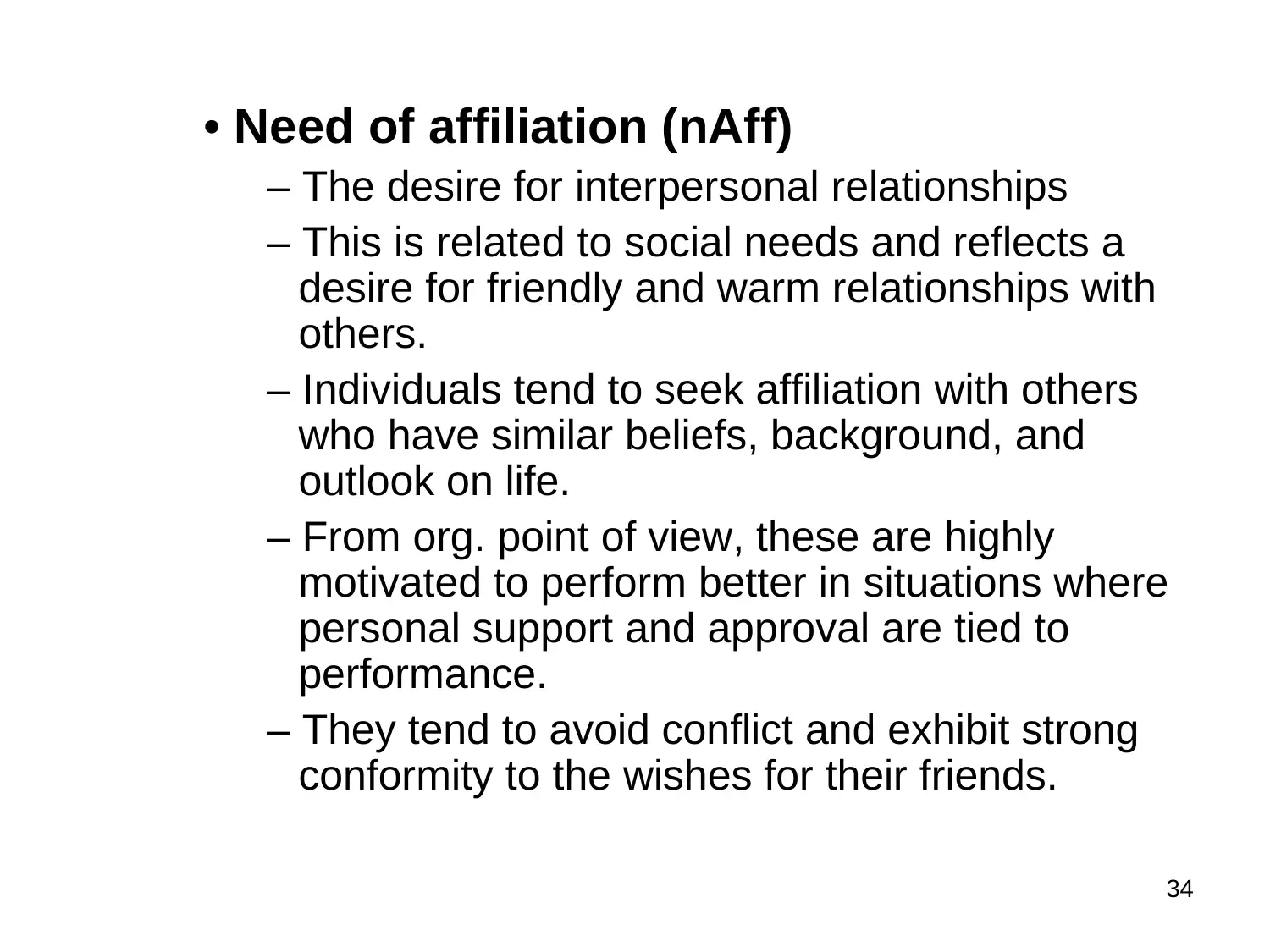
34
• Need of affiliation (nAff)
– The desire for interpersonal relationships
– This is related to social needs and reflects a
desire for friendly and warm relationships with
others.
– Individuals tend to seek affiliation with others
who have similar beliefs, background, and
outlook on life.
– From org. point of view, these are highly
motivated to perform better in situations where
personal support and approval are tied to
performance.
– They tend to avoid conflict and exhibit strong
conformity to the wishes for their friends.
• Need of affiliation (nAff)
– The desire for interpersonal relationships
– This is related to social needs and reflects a
desire for friendly and warm relationships with
others.
– Individuals tend to seek affiliation with others
who have similar beliefs, background, and
outlook on life.
– From org. point of view, these are highly
motivated to perform better in situations where
personal support and approval are tied to
performance.
– They tend to avoid conflict and exhibit strong
conformity to the wishes for their friends.
Secure Best Marks with AI Grader
Need help grading? Try our AI Grader for instant feedback on your assignments.
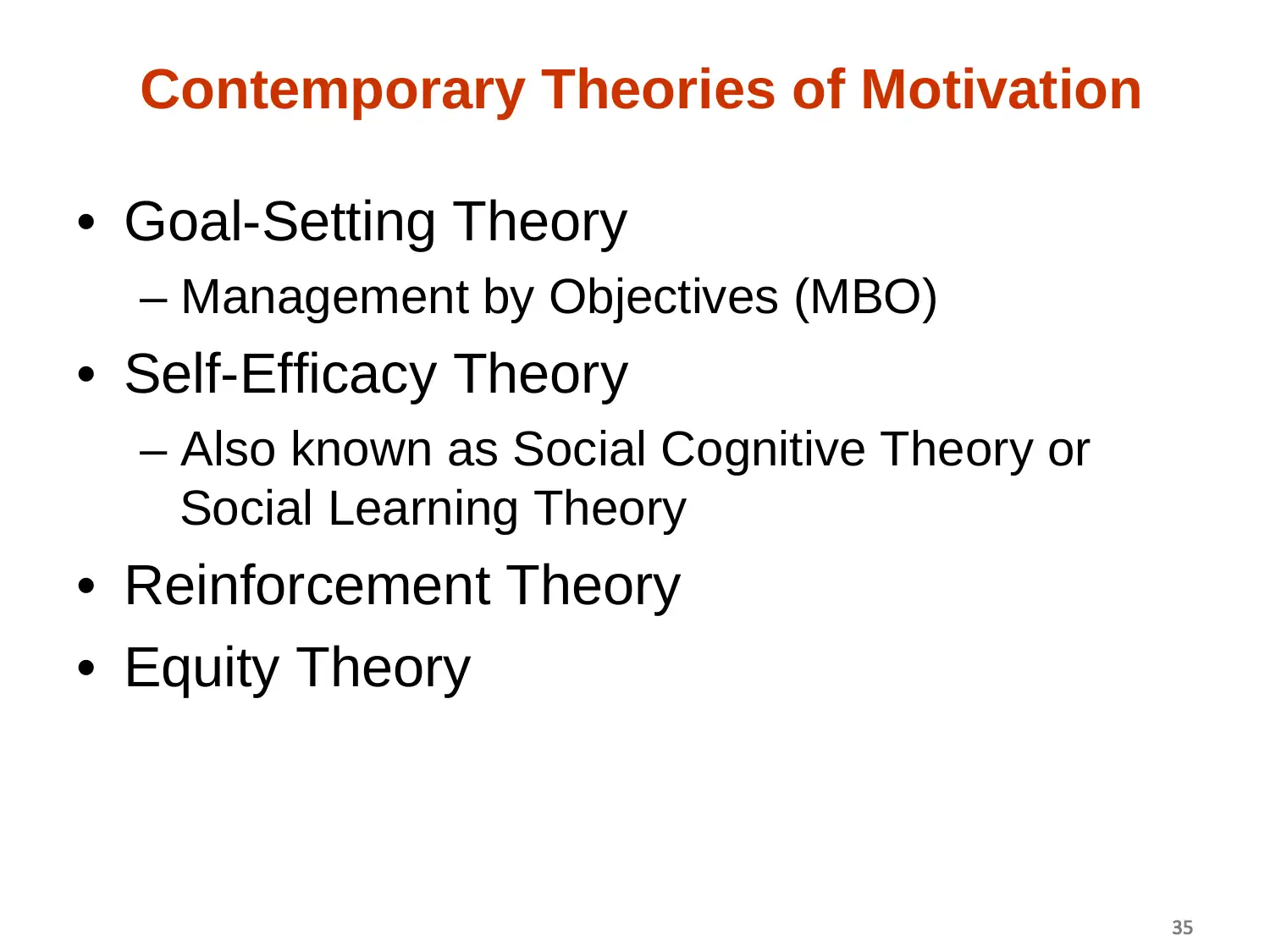
• Goal-Setting Theory
– Management by Objectives (MBO)
• Self-Efficacy Theory
– Also known as Social Cognitive Theory or
Social Learning Theory
• Reinforcement Theory
• Equity Theory
Contemporary Theories of Motivation
35
– Management by Objectives (MBO)
• Self-Efficacy Theory
– Also known as Social Cognitive Theory or
Social Learning Theory
• Reinforcement Theory
• Equity Theory
Contemporary Theories of Motivation
35
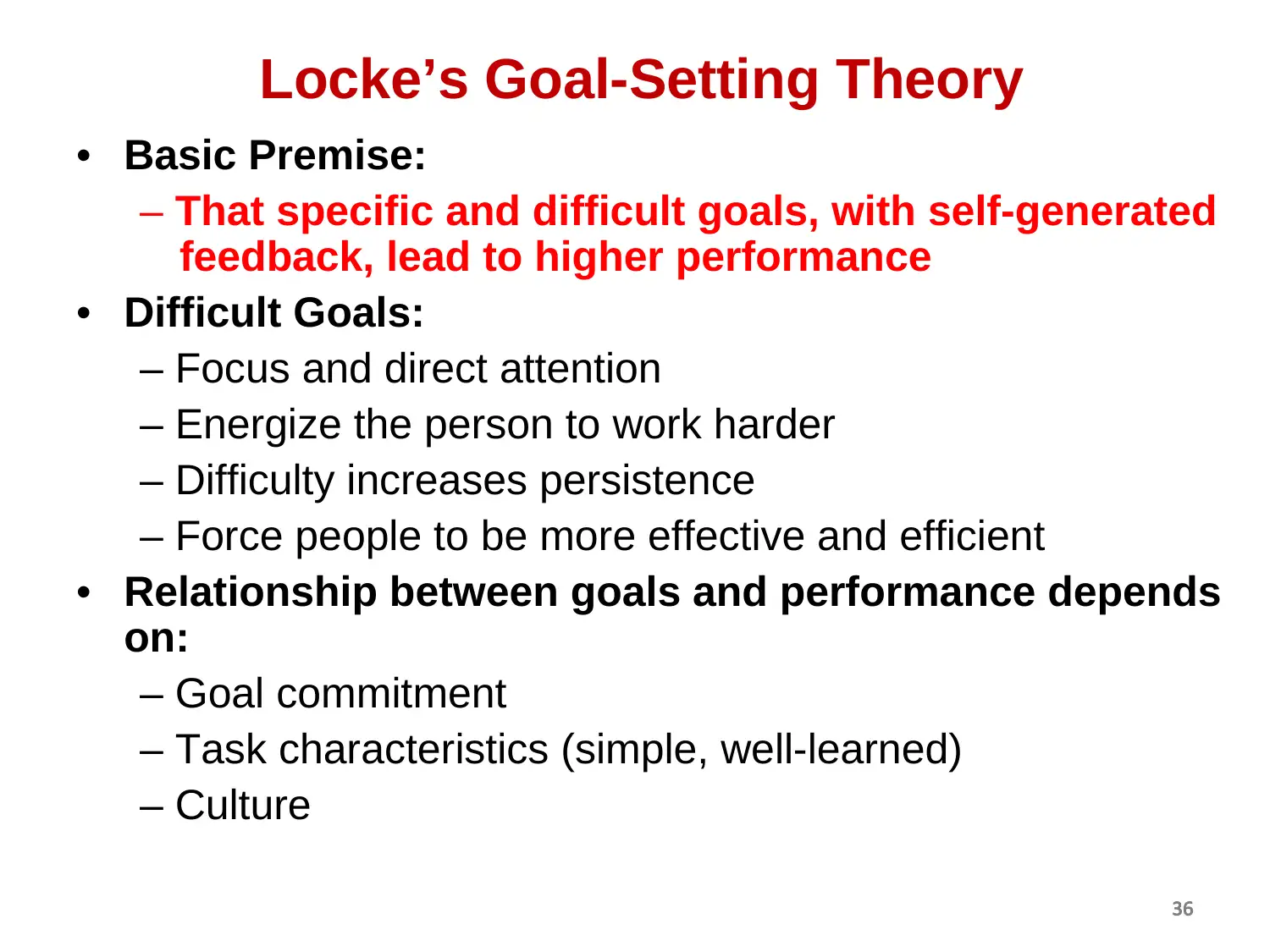
Locke’s Goal-Setting Theory
• Basic Premise:
– That specific and difficult goals, with self-generated
feedback, lead to higher performance
• Difficult Goals:
– Focus and direct attention
– Energize the person to work harder
– Difficulty increases persistence
– Force people to be more effective and efficient
• Relationship between goals and performance depends
on:
– Goal commitment
– Task characteristics (simple, well-learned)
– Culture
36
• Basic Premise:
– That specific and difficult goals, with self-generated
feedback, lead to higher performance
• Difficult Goals:
– Focus and direct attention
– Energize the person to work harder
– Difficulty increases persistence
– Force people to be more effective and efficient
• Relationship between goals and performance depends
on:
– Goal commitment
– Task characteristics (simple, well-learned)
– Culture
36
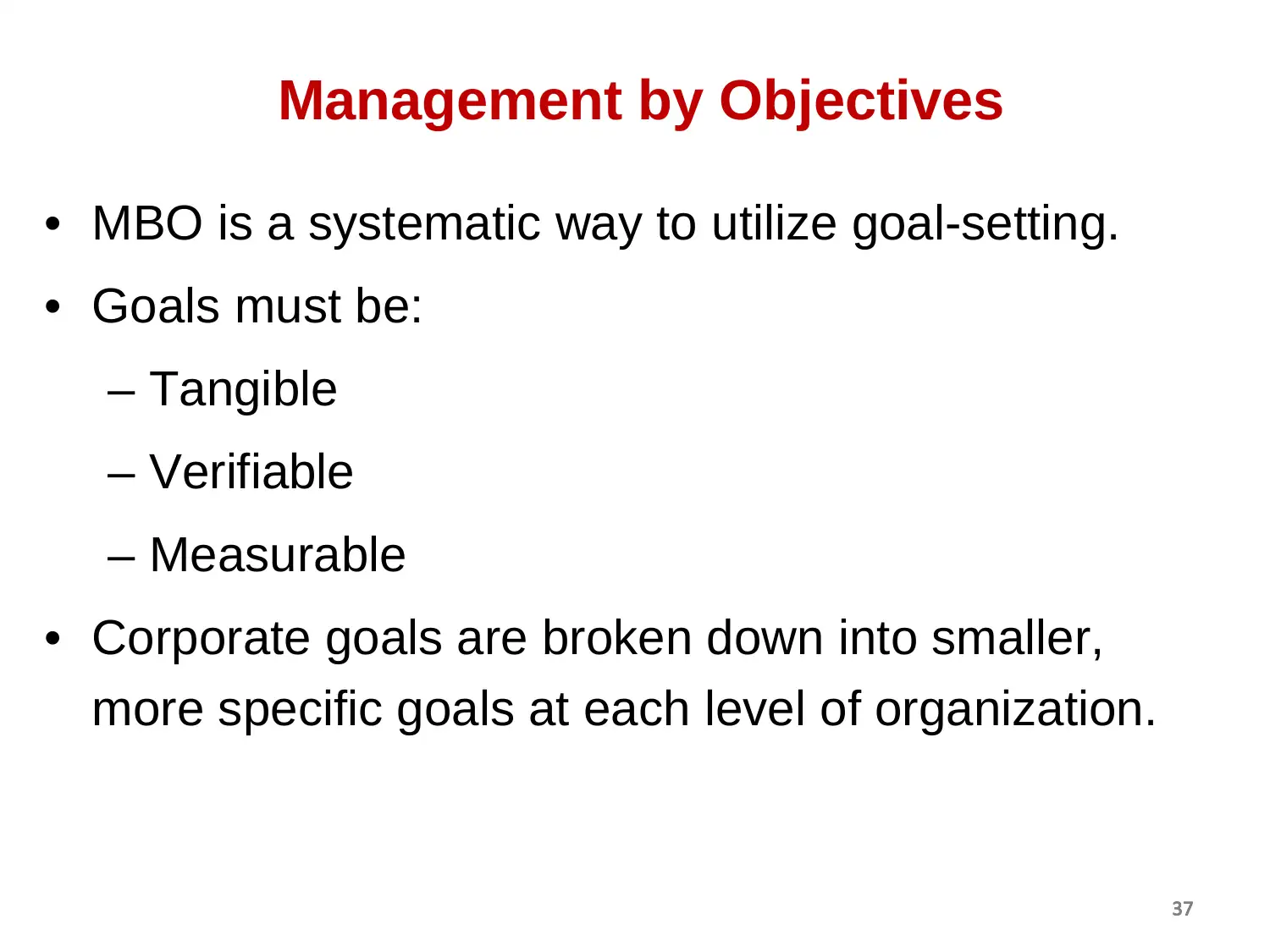
• MBO is a systematic way to utilize goal-setting.
• Goals must be:
– Tangible
– Verifiable
– Measurable
• Corporate goals are broken down into smaller,
more specific goals at each level of organization.
Management by Objectives
37
• Goals must be:
– Tangible
– Verifiable
– Measurable
• Corporate goals are broken down into smaller,
more specific goals at each level of organization.
Management by Objectives
37
Paraphrase This Document
Need a fresh take? Get an instant paraphrase of this document with our AI Paraphraser
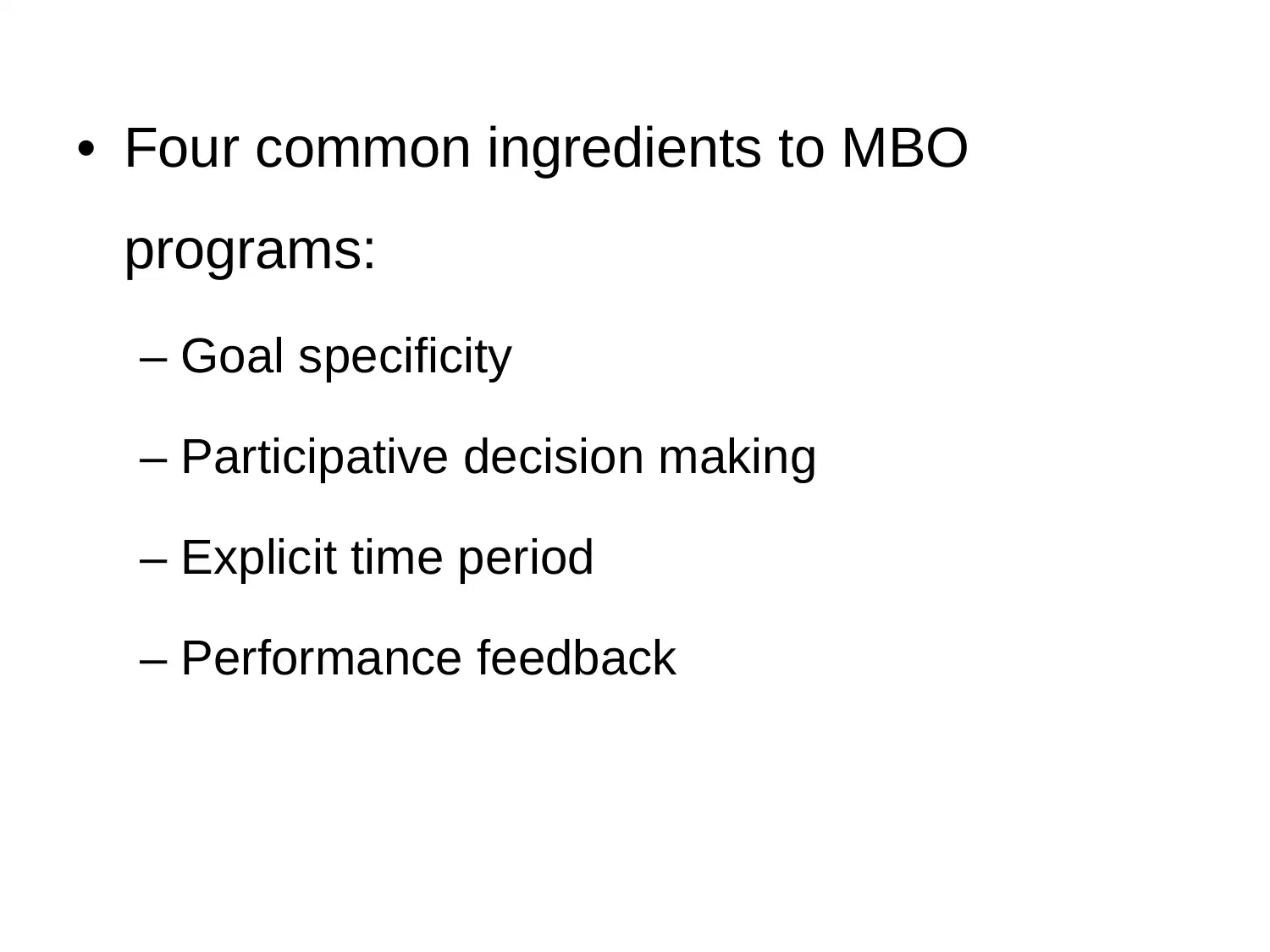
• Four common ingredients to MBO
programs:
– Goal specificity
– Participative decision making
– Explicit time period
– Performance feedback
programs:
– Goal specificity
– Participative decision making
– Explicit time period
– Performance feedback
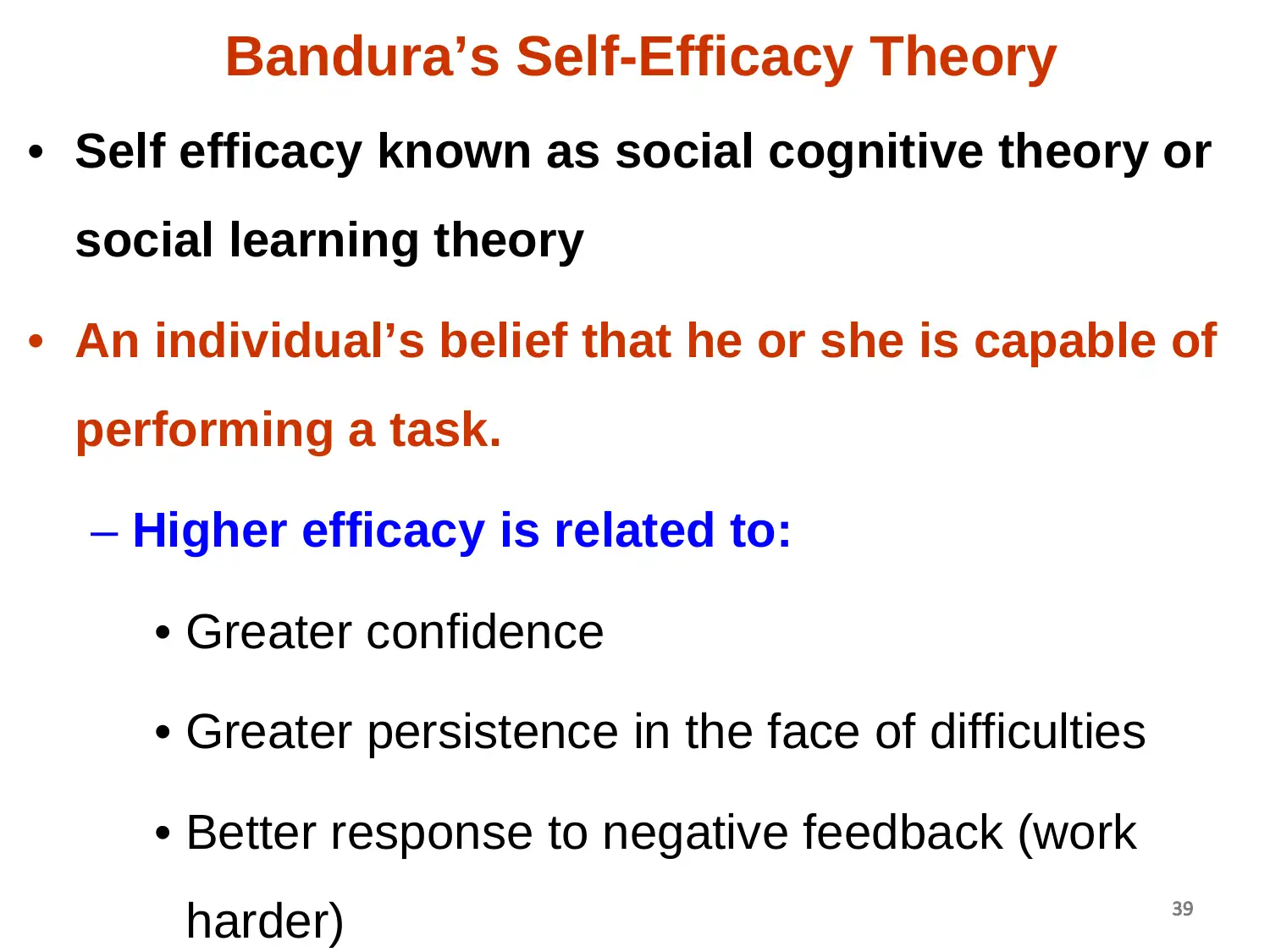
Bandura’s Self-Efficacy Theory
• Self efficacy known as social cognitive theory or
social learning theory
• An individual’s belief that he or she is capable of
performing a task.
– Higher efficacy is related to:
• Greater confidence
• Greater persistence in the face of difficulties
• Better response to negative feedback (work
harder) 39
• Self efficacy known as social cognitive theory or
social learning theory
• An individual’s belief that he or she is capable of
performing a task.
– Higher efficacy is related to:
• Greater confidence
• Greater persistence in the face of difficulties
• Better response to negative feedback (work
harder) 39
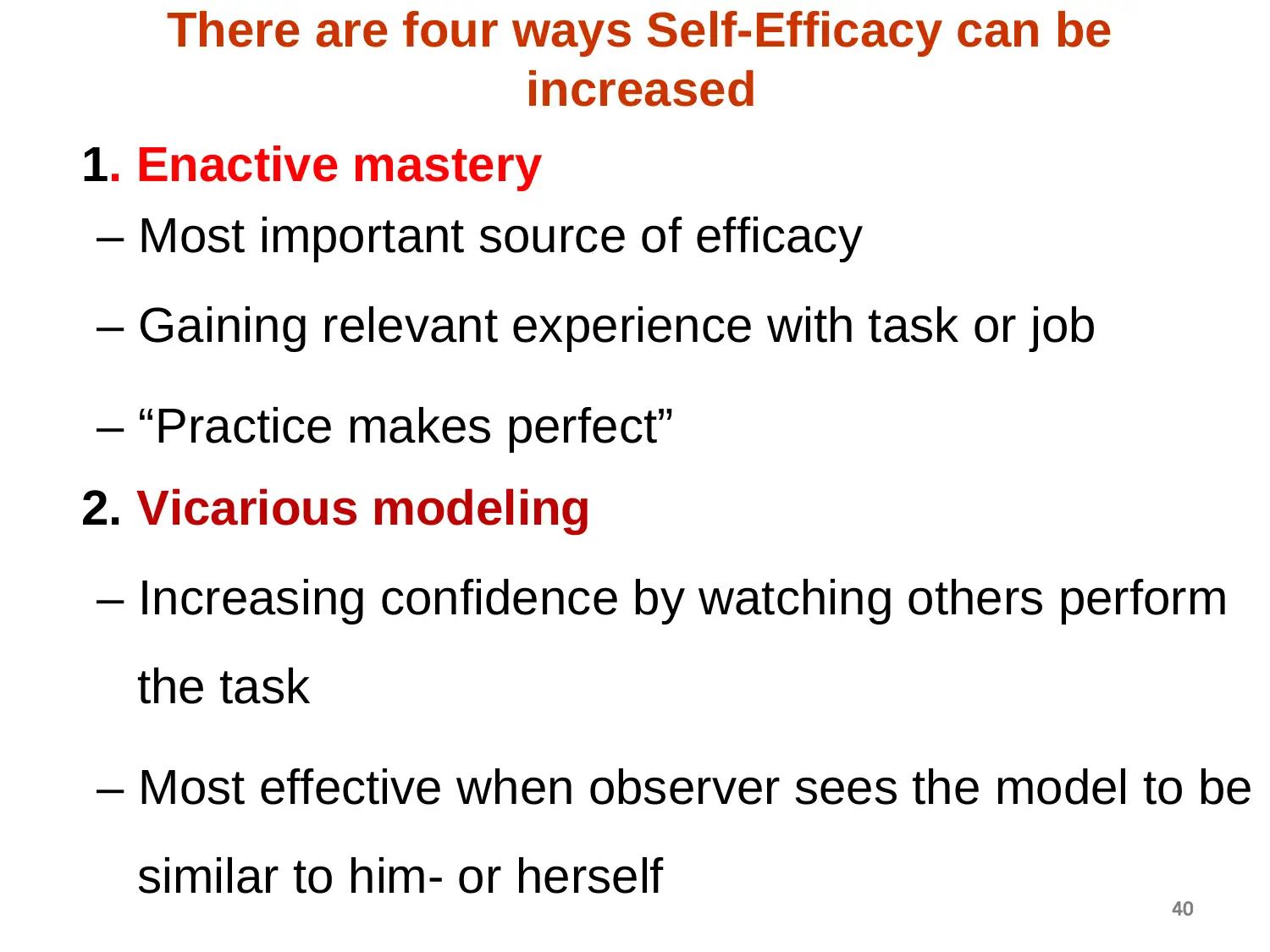
There are four ways Self-Efficacy can be
increased
1. Enactive mastery
– Most important source of efficacy
– Gaining relevant experience with task or job
– “Practice makes perfect”
2. Vicarious modeling
– Increasing confidence by watching others perform
the task
– Most effective when observer sees the model to be
similar to him- or herself 40
increased
1. Enactive mastery
– Most important source of efficacy
– Gaining relevant experience with task or job
– “Practice makes perfect”
2. Vicarious modeling
– Increasing confidence by watching others perform
the task
– Most effective when observer sees the model to be
similar to him- or herself 40
Secure Best Marks with AI Grader
Need help grading? Try our AI Grader for instant feedback on your assignments.
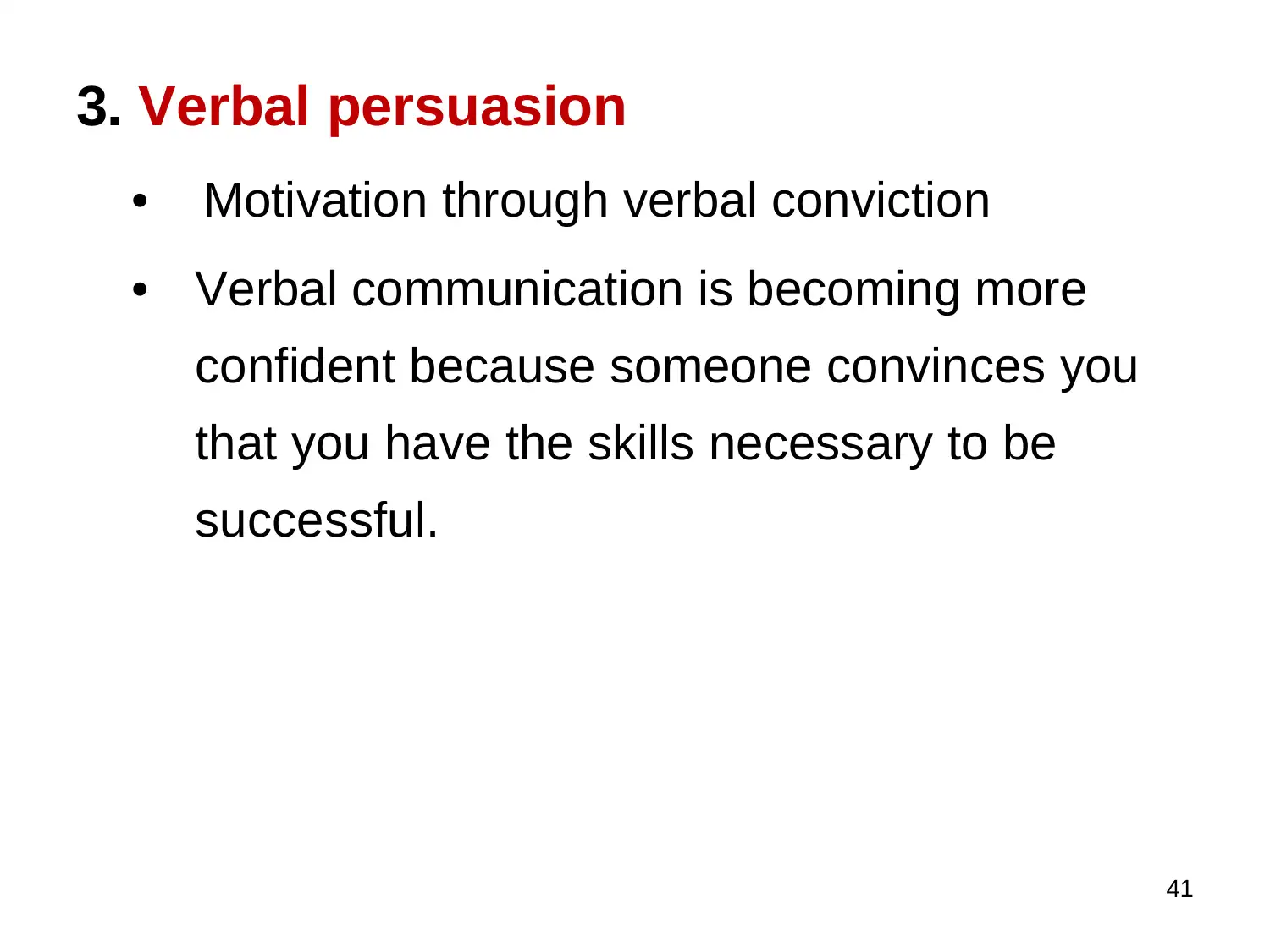
3. Verbal persuasion
• Motivation through verbal conviction
• Verbal communication is becoming more
confident because someone convinces you
that you have the skills necessary to be
successful.
41
• Motivation through verbal conviction
• Verbal communication is becoming more
confident because someone convinces you
that you have the skills necessary to be
successful.
41
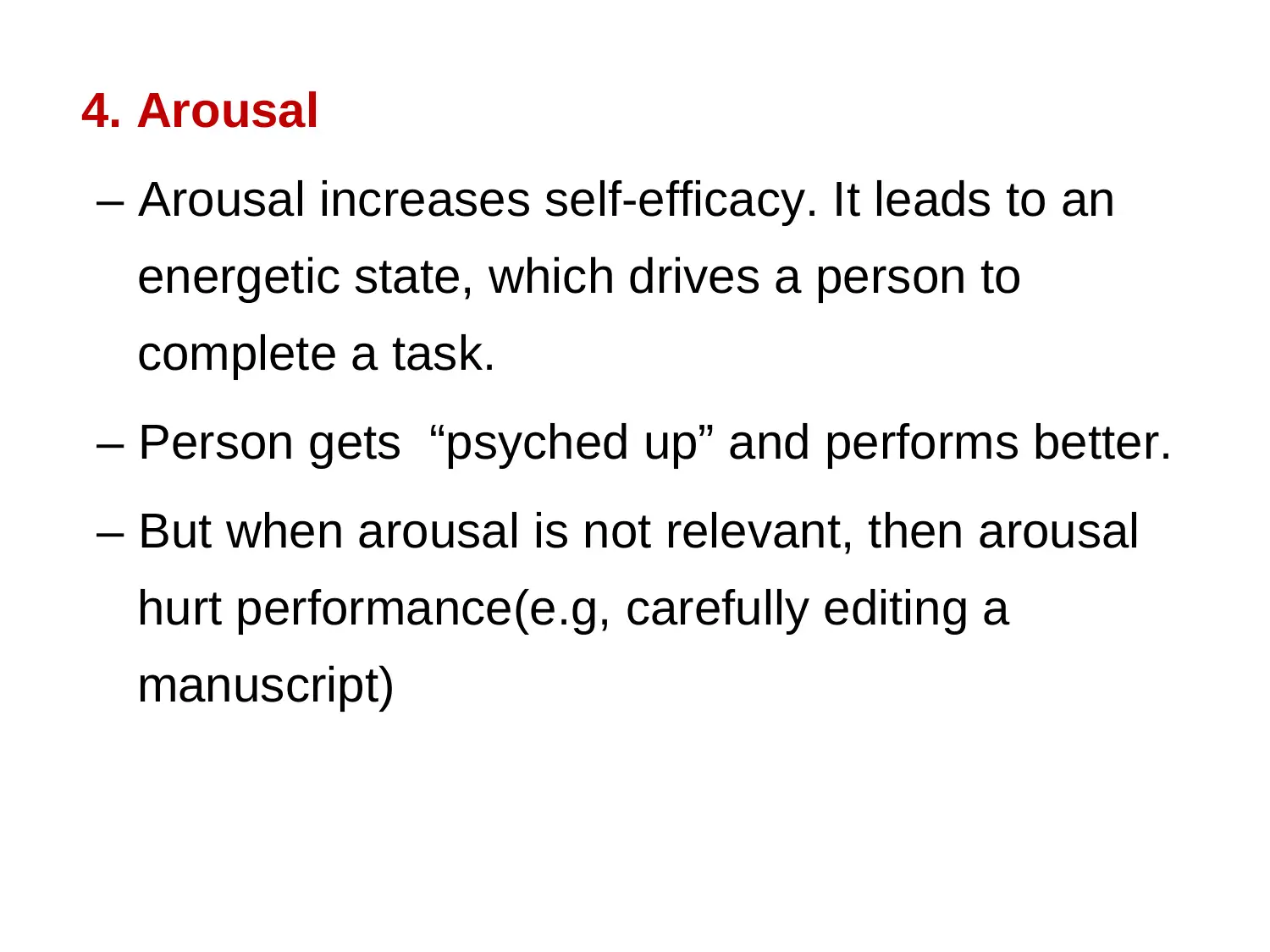
4. Arousal
– Arousal increases self-efficacy. It leads to an
energetic state, which drives a person to
complete a task.
– Person gets “psyched up” and performs better.
– But when arousal is not relevant, then arousal
hurt performance(e.g, carefully editing a
manuscript)
– Arousal increases self-efficacy. It leads to an
energetic state, which drives a person to
complete a task.
– Person gets “psyched up” and performs better.
– But when arousal is not relevant, then arousal
hurt performance(e.g, carefully editing a
manuscript)
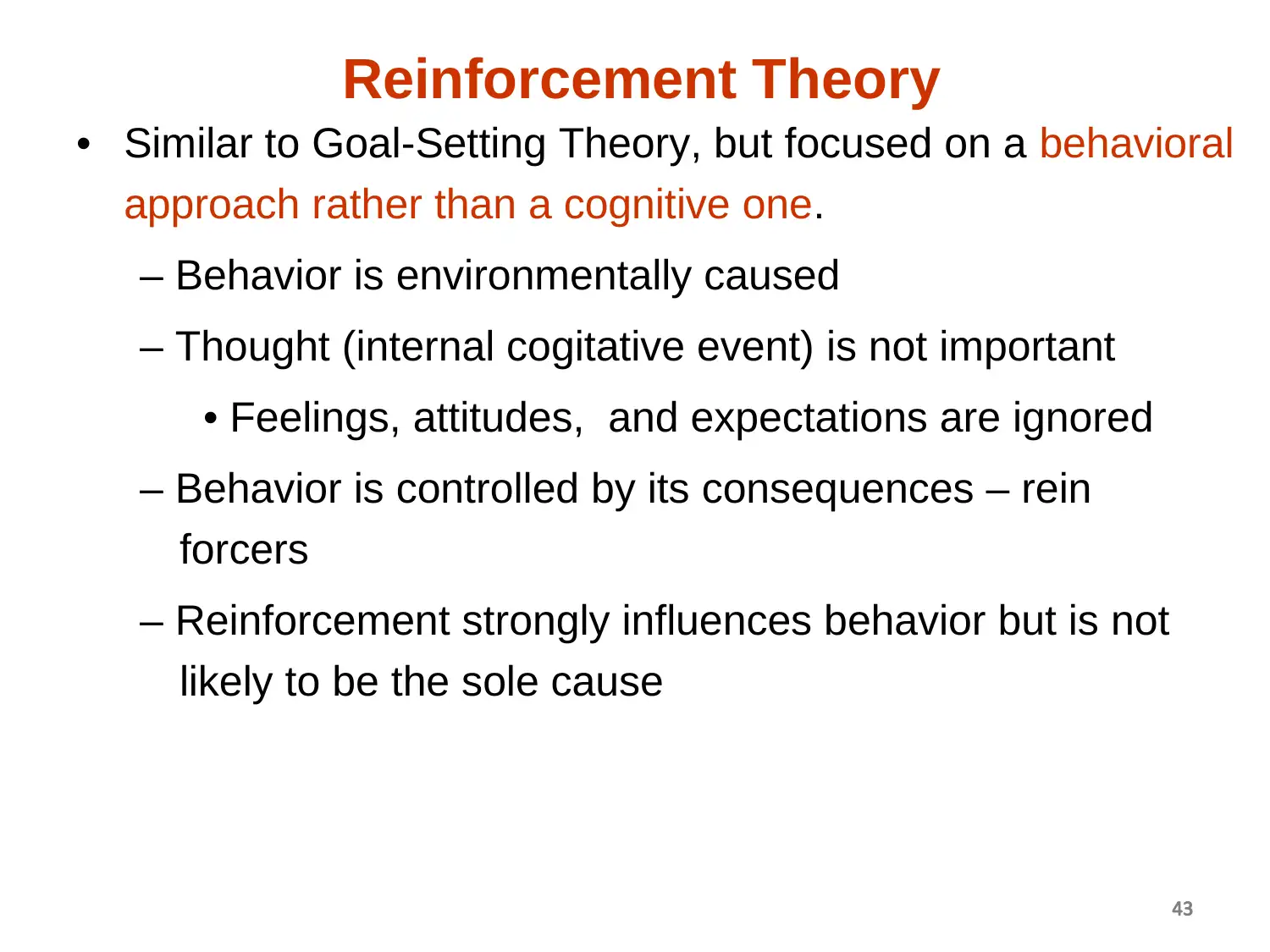
• Similar to Goal-Setting Theory, but focused on a behavioral
approach rather than a cognitive one.
– Behavior is environmentally caused
– Thought (internal cogitative event) is not important
• Feelings, attitudes, and expectations are ignored
– Behavior is controlled by its consequences – rein
forcers
– Reinforcement strongly influences behavior but is not
likely to be the sole cause
Reinforcement Theory
43
approach rather than a cognitive one.
– Behavior is environmentally caused
– Thought (internal cogitative event) is not important
• Feelings, attitudes, and expectations are ignored
– Behavior is controlled by its consequences – rein
forcers
– Reinforcement strongly influences behavior but is not
likely to be the sole cause
Reinforcement Theory
43
Paraphrase This Document
Need a fresh take? Get an instant paraphrase of this document with our AI Paraphraser
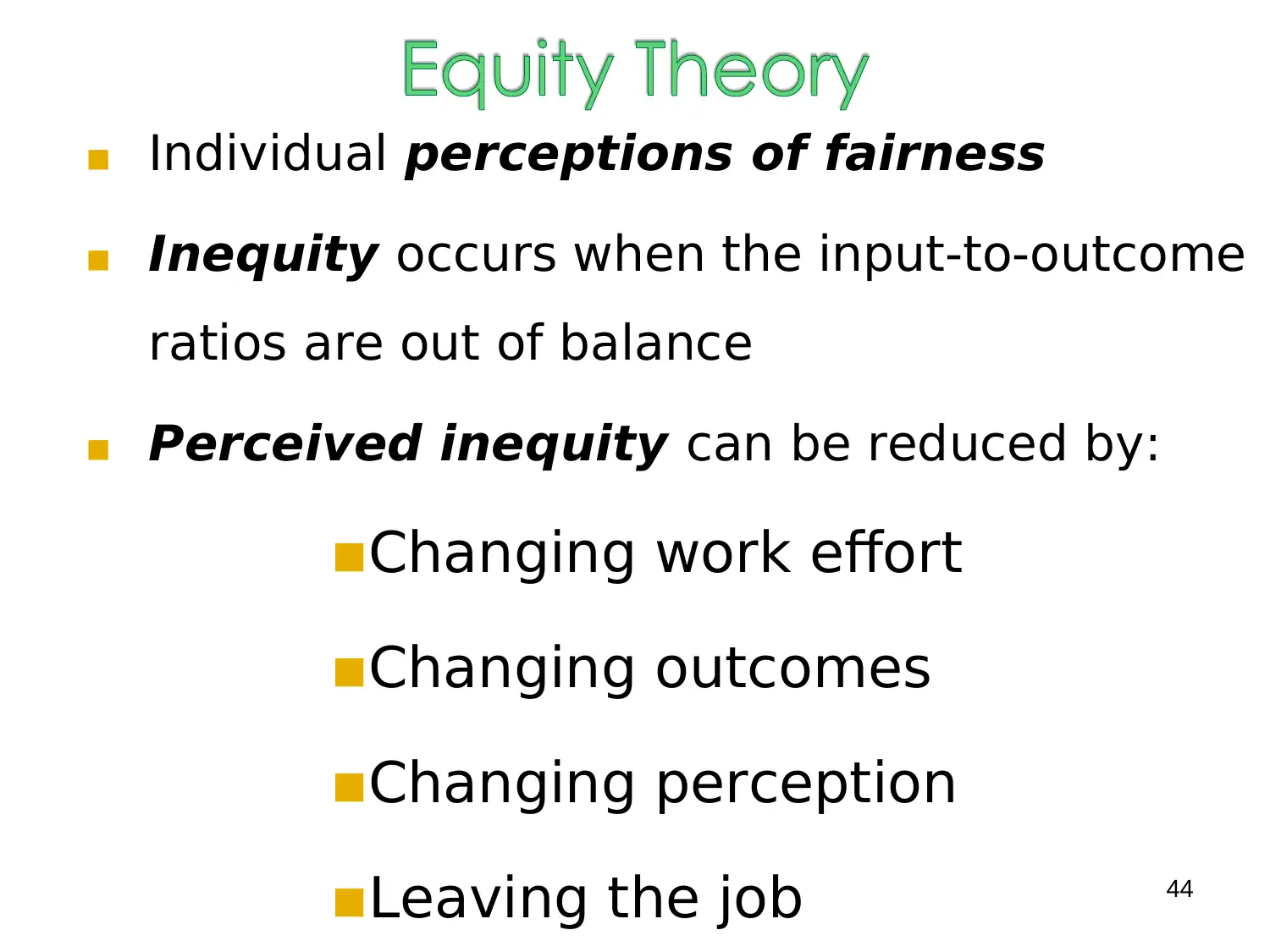
▪ Individual perceptions of fairness
▪ Inequity occurs when the input-to-outcome
ratios are out of balance
▪ Perceived inequity can be reduced by:
▪Changing work effort
▪Changing outcomes
▪Changing perception
▪Leaving the job 44
▪ Inequity occurs when the input-to-outcome
ratios are out of balance
▪ Perceived inequity can be reduced by:
▪Changing work effort
▪Changing outcomes
▪Changing perception
▪Leaving the job 44
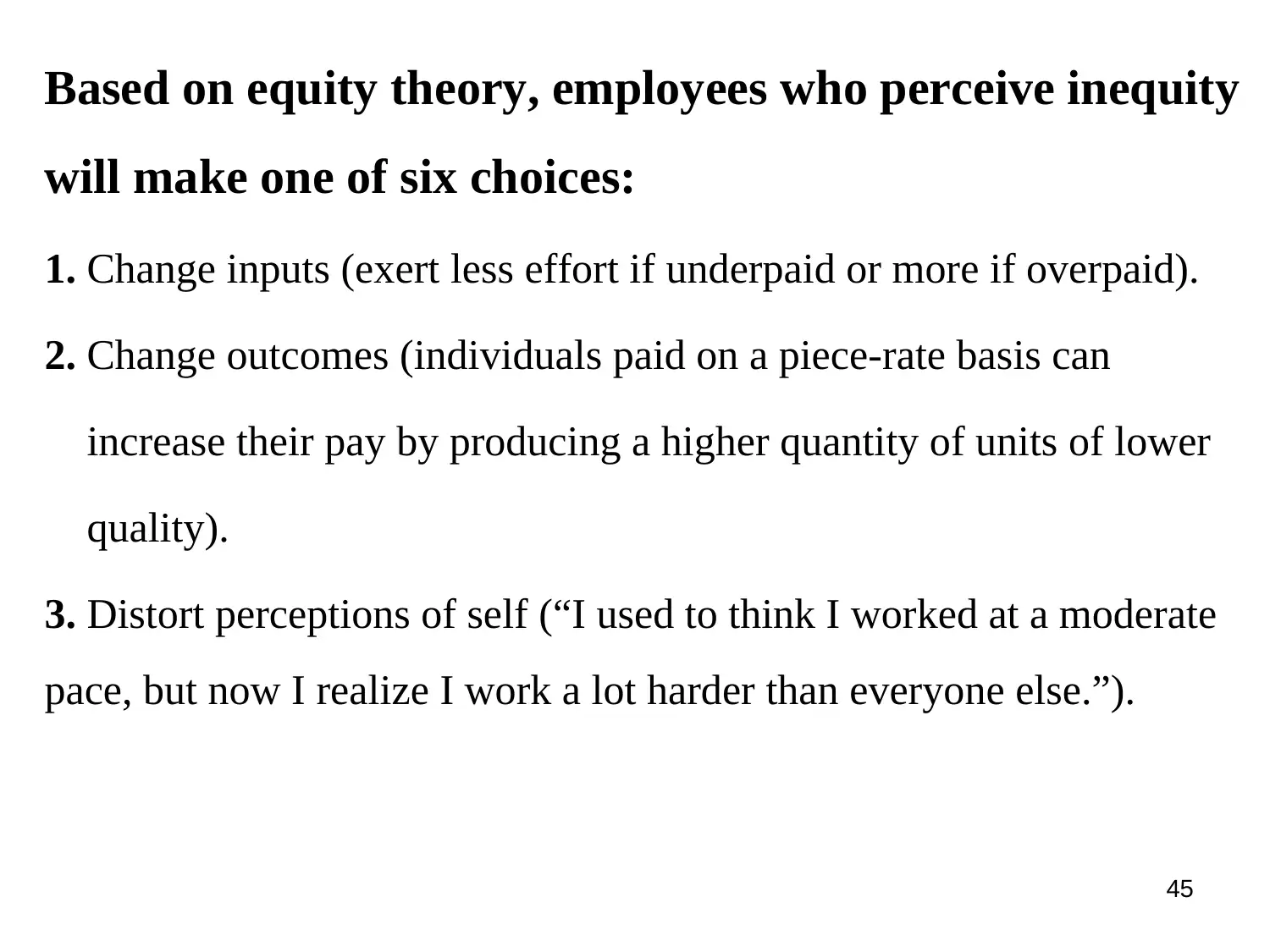
Based on equity theory, employees who perceive inequity
will make one of six choices:
1. Change inputs (exert less effort if underpaid or more if overpaid).
2. Change outcomes (individuals paid on a piece-rate basis can
increase their pay by producing a higher quantity of units of lower
quality).
3. Distort perceptions of self (“I used to think I worked at a moderate
pace, but now I realize I work a lot harder than everyone else.”).
45
will make one of six choices:
1. Change inputs (exert less effort if underpaid or more if overpaid).
2. Change outcomes (individuals paid on a piece-rate basis can
increase their pay by producing a higher quantity of units of lower
quality).
3. Distort perceptions of self (“I used to think I worked at a moderate
pace, but now I realize I work a lot harder than everyone else.”).
45
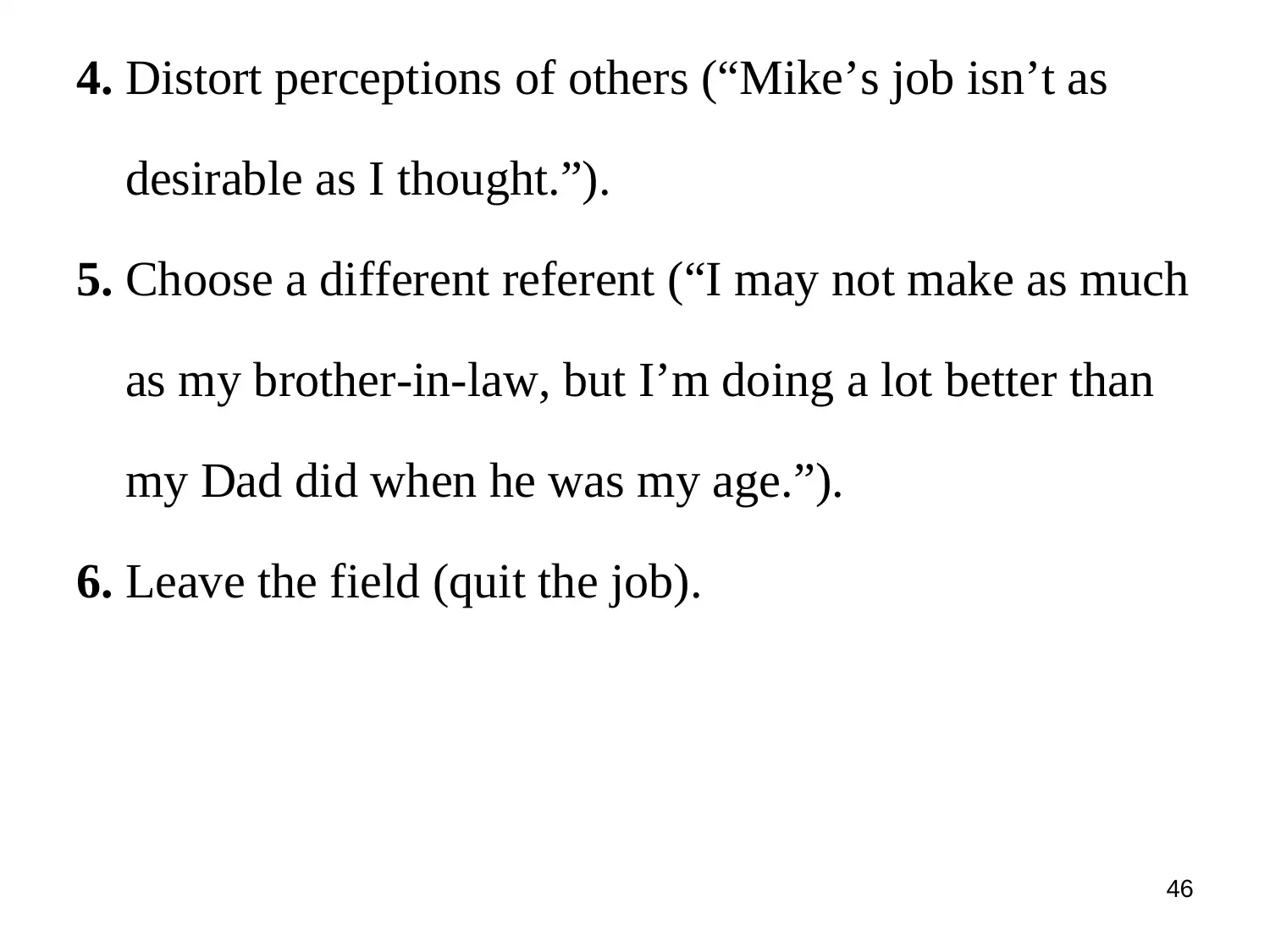
4. Distort perceptions of others (“Mike’s job isn’t as
desirable as I thought.”).
5. Choose a different referent (“I may not make as much
as my brother-in-law, but I’m doing a lot better than
my Dad did when he was my age.”).
6. Leave the field (quit the job).
46
desirable as I thought.”).
5. Choose a different referent (“I may not make as much
as my brother-in-law, but I’m doing a lot better than
my Dad did when he was my age.”).
6. Leave the field (quit the job).
46
Secure Best Marks with AI Grader
Need help grading? Try our AI Grader for instant feedback on your assignments.
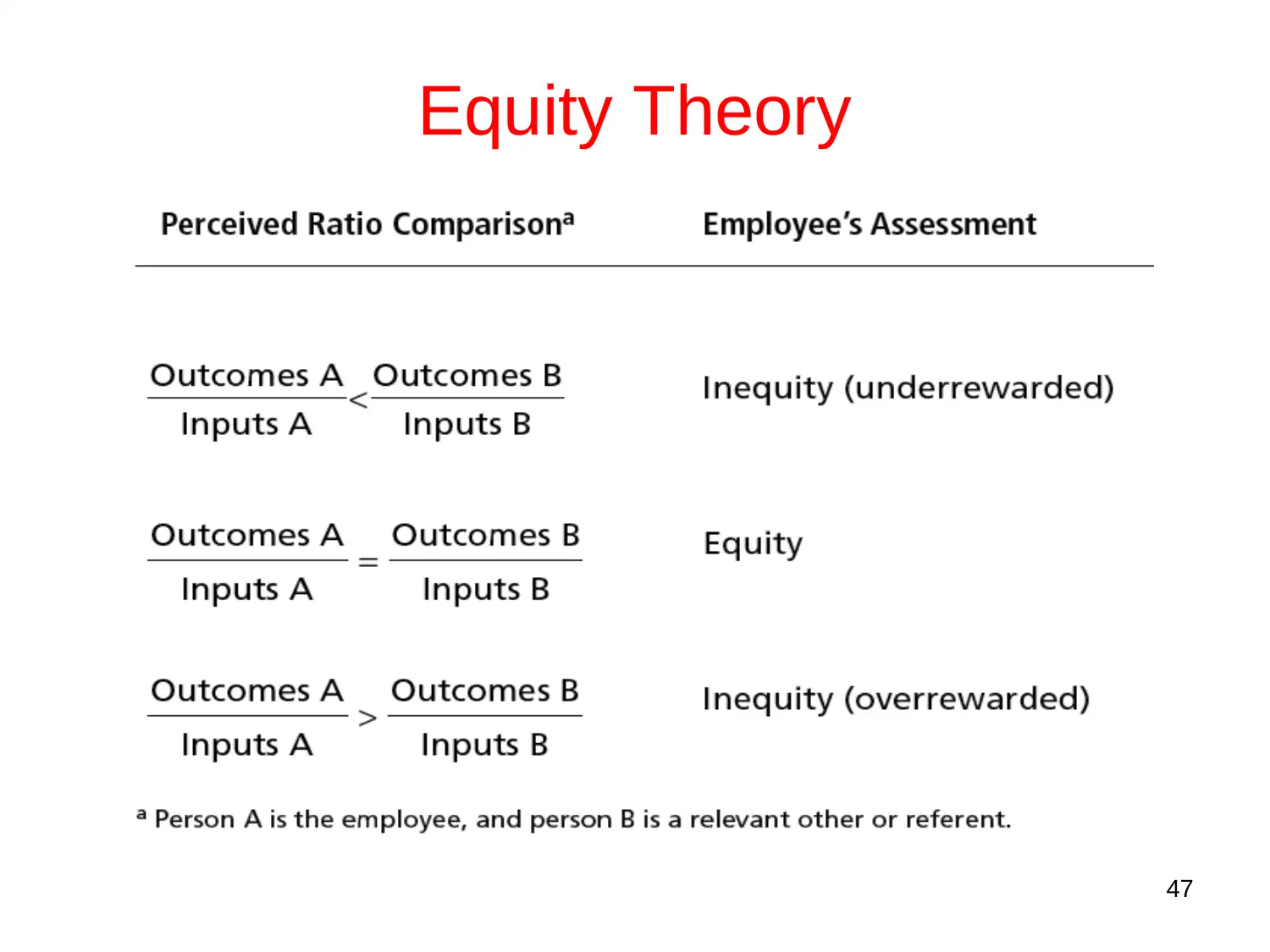
47
Equity Theory
Equity Theory
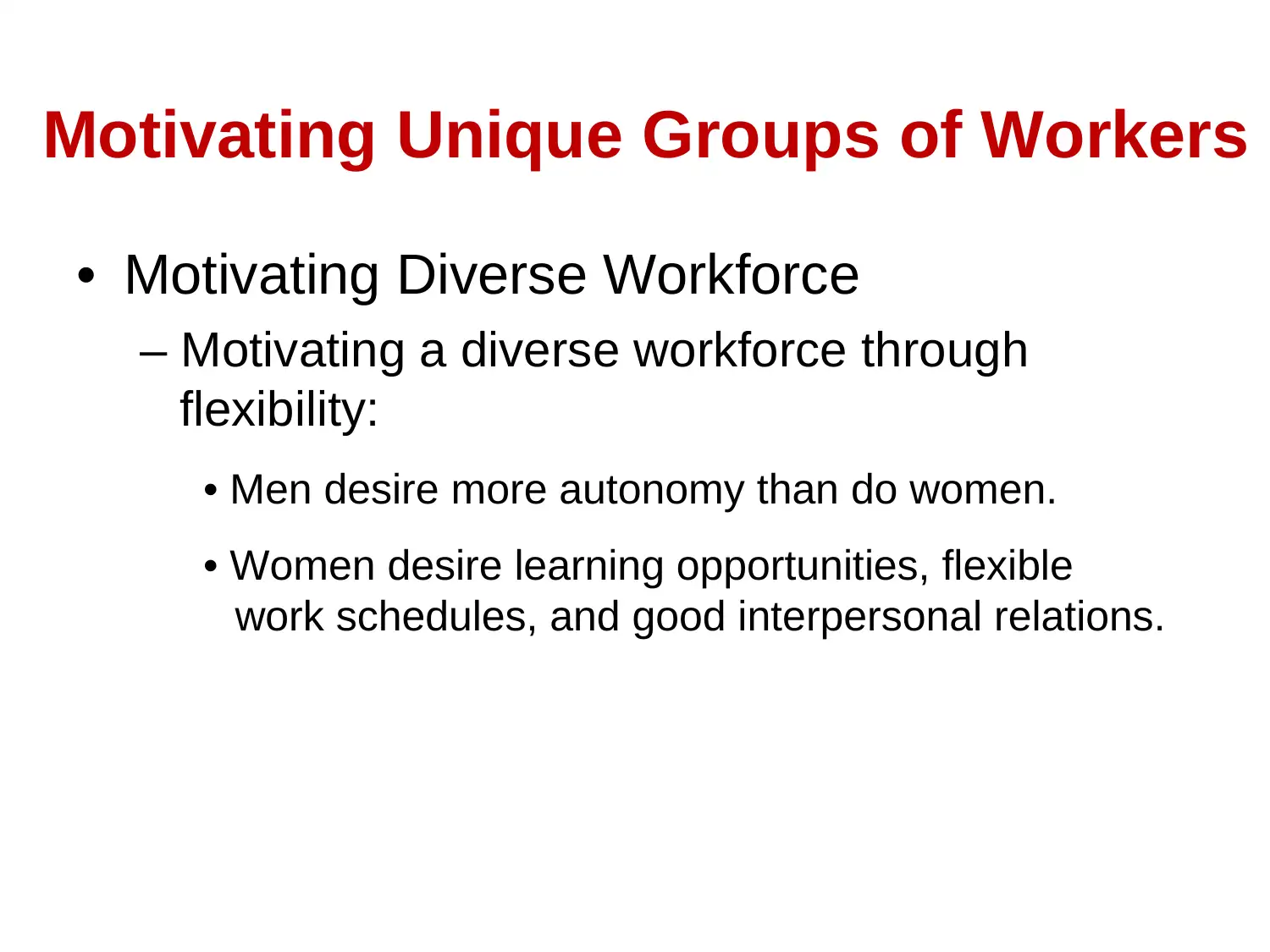
• Motivating Diverse Workforce
– Motivating a diverse workforce through
flexibility:
• Men desire more autonomy than do women.
• Women desire learning opportunities, flexible
work schedules, and good interpersonal relations.
Motivating Unique Groups of Workers
– Motivating a diverse workforce through
flexibility:
• Men desire more autonomy than do women.
• Women desire learning opportunities, flexible
work schedules, and good interpersonal relations.
Motivating Unique Groups of Workers
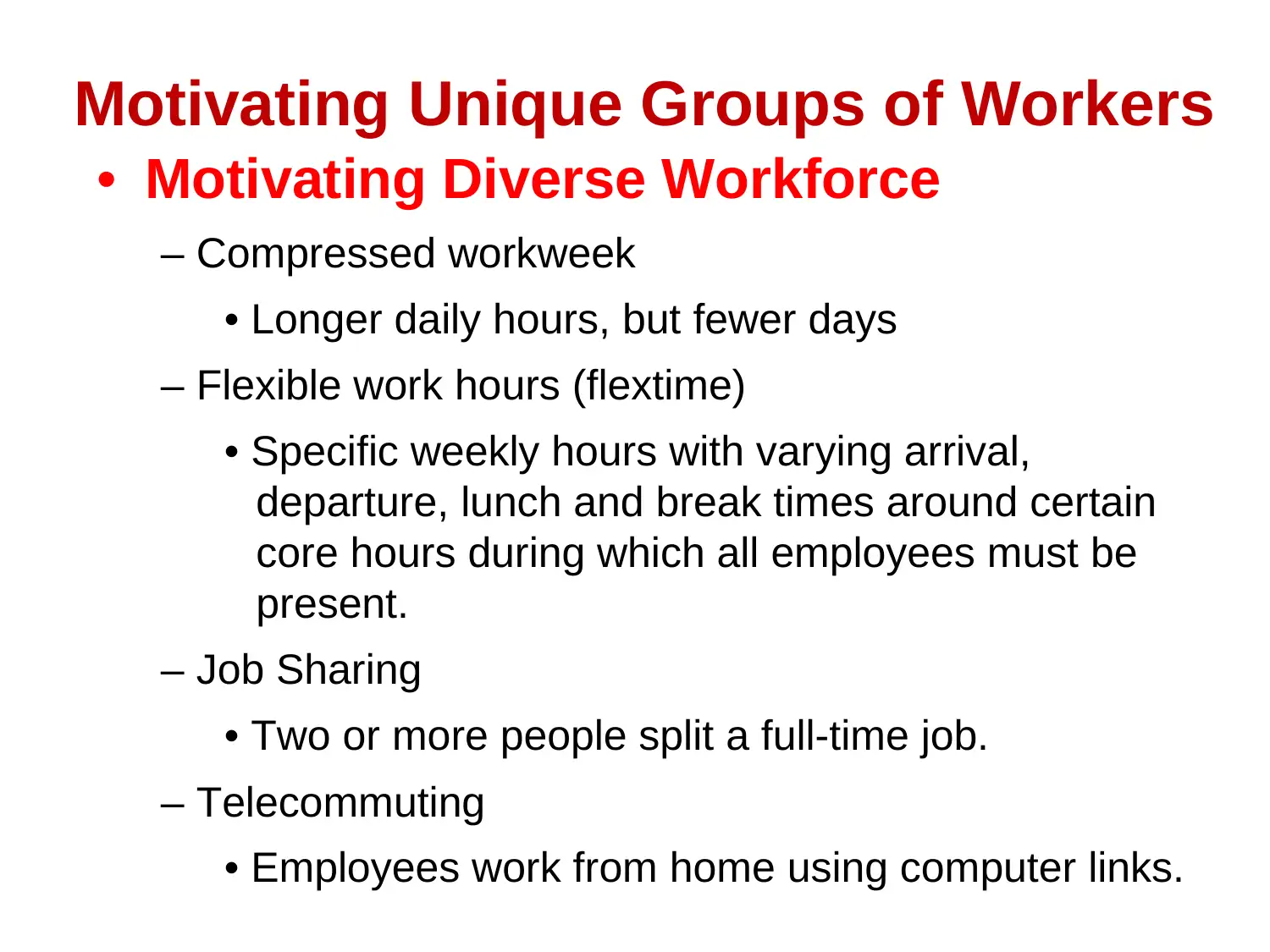
Motivating Unique Groups of Workers
• Motivating Diverse Workforce
– Compressed workweek
• Longer daily hours, but fewer days
– Flexible work hours (flextime)
• Specific weekly hours with varying arrival,
departure, lunch and break times around certain
core hours during which all employees must be
present.
– Job Sharing
• Two or more people split a full-time job.
– Telecommuting
• Employees work from home using computer links.
• Motivating Diverse Workforce
– Compressed workweek
• Longer daily hours, but fewer days
– Flexible work hours (flextime)
• Specific weekly hours with varying arrival,
departure, lunch and break times around certain
core hours during which all employees must be
present.
– Job Sharing
• Two or more people split a full-time job.
– Telecommuting
• Employees work from home using computer links.
Paraphrase This Document
Need a fresh take? Get an instant paraphrase of this document with our AI Paraphraser
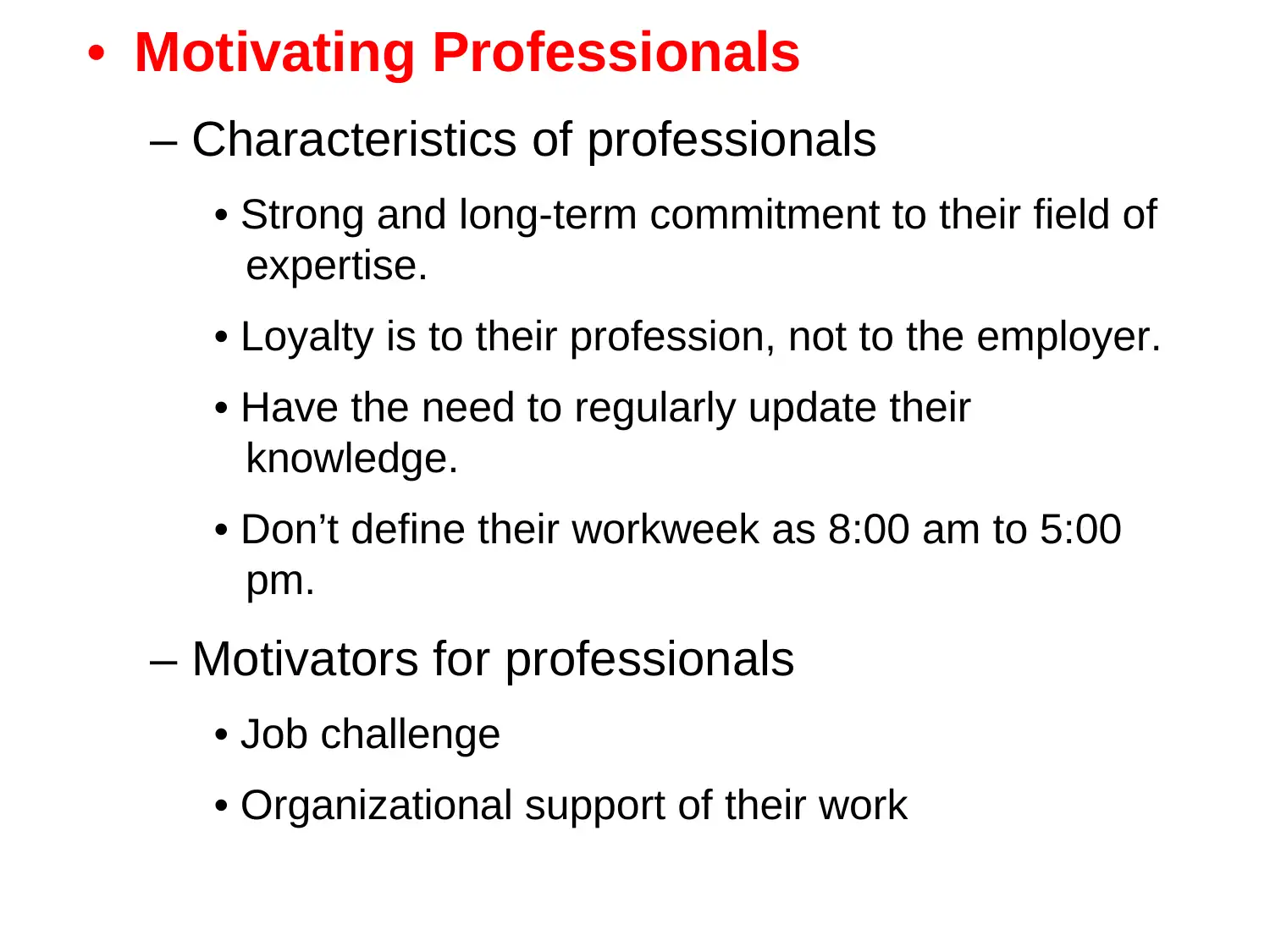
• Motivating Professionals
– Characteristics of professionals
• Strong and long-term commitment to their field of
expertise.
• Loyalty is to their profession, not to the employer.
• Have the need to regularly update their
knowledge.
• Don’t define their workweek as 8:00 am to 5:00
pm.
– Motivators for professionals
• Job challenge
• Organizational support of their work
– Characteristics of professionals
• Strong and long-term commitment to their field of
expertise.
• Loyalty is to their profession, not to the employer.
• Have the need to regularly update their
knowledge.
• Don’t define their workweek as 8:00 am to 5:00
pm.
– Motivators for professionals
• Job challenge
• Organizational support of their work
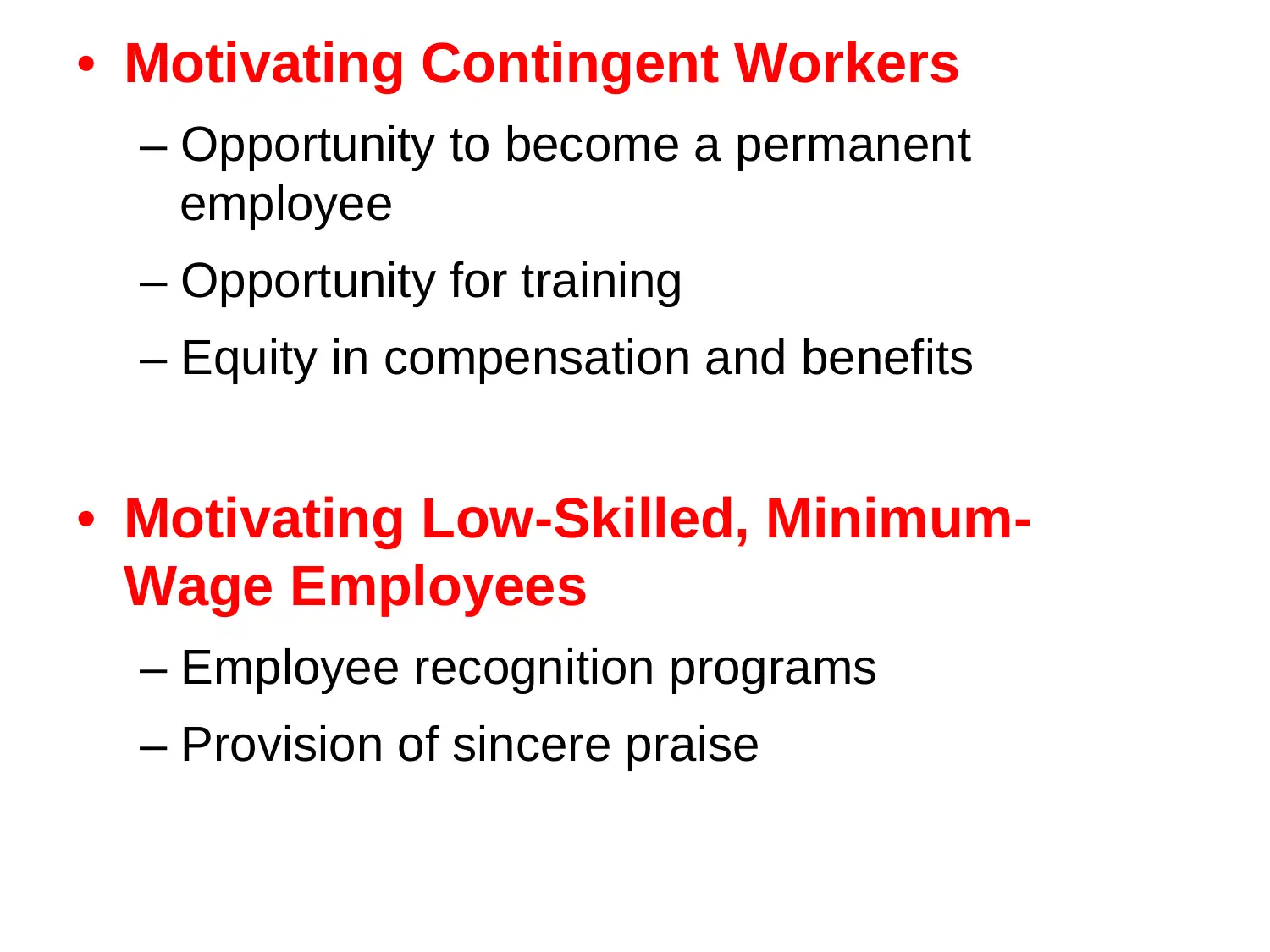
• Motivating Contingent Workers
– Opportunity to become a permanent
employee
– Opportunity for training
– Equity in compensation and benefits
• Motivating Low-Skilled, Minimum-
Wage Employees
– Employee recognition programs
– Provision of sincere praise
– Opportunity to become a permanent
employee
– Opportunity for training
– Equity in compensation and benefits
• Motivating Low-Skilled, Minimum-
Wage Employees
– Employee recognition programs
– Provision of sincere praise
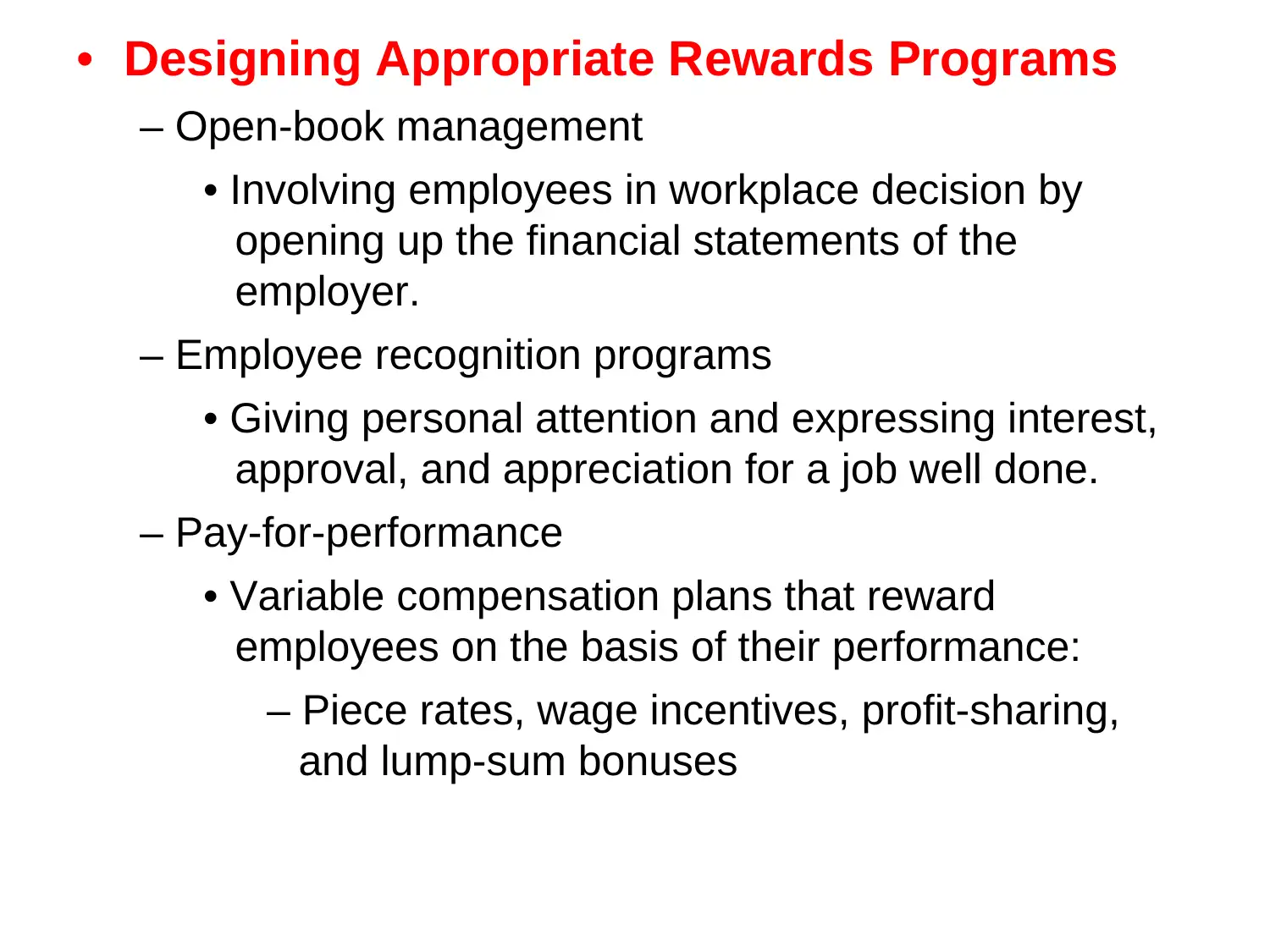
• Designing Appropriate Rewards Programs
– Open-book management
• Involving employees in workplace decision by
opening up the financial statements of the
employer.
– Employee recognition programs
• Giving personal attention and expressing interest,
approval, and appreciation for a job well done.
– Pay-for-performance
• Variable compensation plans that reward
employees on the basis of their performance:
– Piece rates, wage incentives, profit-sharing,
and lump-sum bonuses
– Open-book management
• Involving employees in workplace decision by
opening up the financial statements of the
employer.
– Employee recognition programs
• Giving personal attention and expressing interest,
approval, and appreciation for a job well done.
– Pay-for-performance
• Variable compensation plans that reward
employees on the basis of their performance:
– Piece rates, wage incentives, profit-sharing,
and lump-sum bonuses
Secure Best Marks with AI Grader
Need help grading? Try our AI Grader for instant feedback on your assignments.
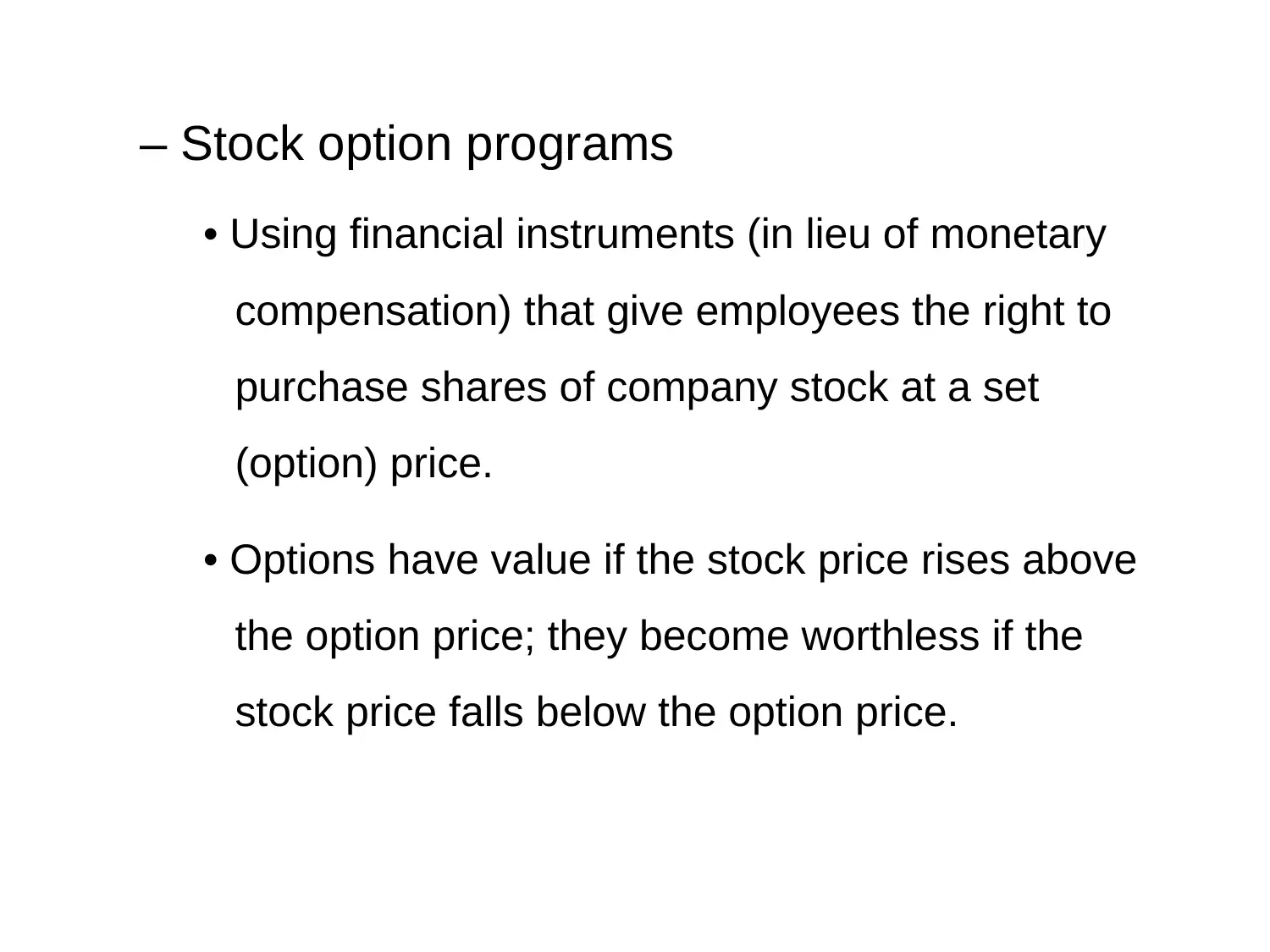
– Stock option programs
• Using financial instruments (in lieu of monetary
compensation) that give employees the right to
purchase shares of company stock at a set
(option) price.
• Options have value if the stock price rises above
the option price; they become worthless if the
stock price falls below the option price.
• Using financial instruments (in lieu of monetary
compensation) that give employees the right to
purchase shares of company stock at a set
(option) price.
• Options have value if the stock price rises above
the option price; they become worthless if the
stock price falls below the option price.
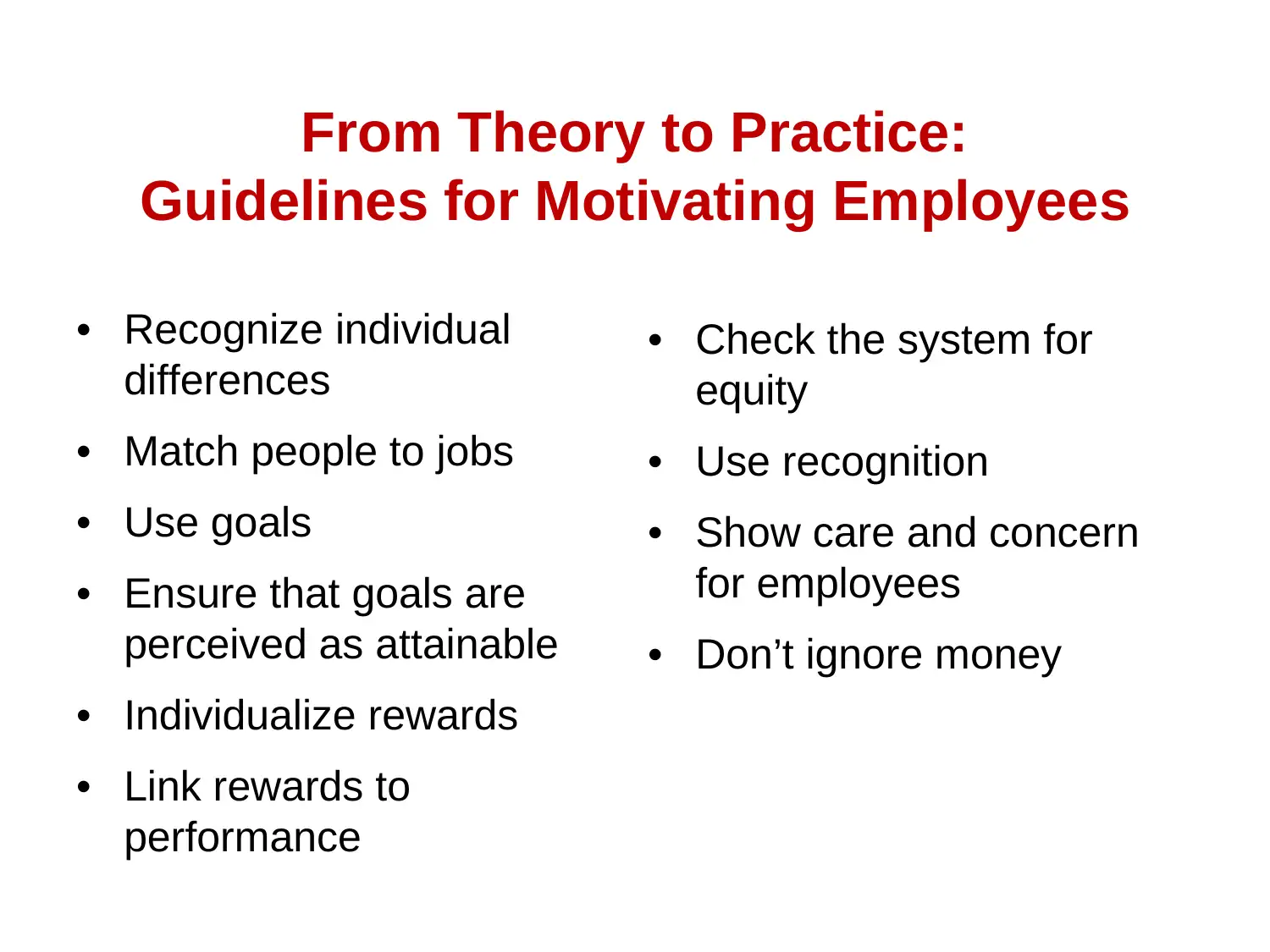
From Theory to Practice:
Guidelines for Motivating Employees
• Recognize individual
differences
• Match people to jobs
• Use goals
• Ensure that goals are
perceived as attainable
• Individualize rewards
• Link rewards to
performance
• Check the system for
equity
• Use recognition
• Show care and concern
for employees
• Don’t ignore money
Guidelines for Motivating Employees
• Recognize individual
differences
• Match people to jobs
• Use goals
• Ensure that goals are
perceived as attainable
• Individualize rewards
• Link rewards to
performance
• Check the system for
equity
• Use recognition
• Show care and concern
for employees
• Don’t ignore money
1 out of 54
Your All-in-One AI-Powered Toolkit for Academic Success.
+13062052269
info@desklib.com
Available 24*7 on WhatsApp / Email
![[object Object]](/_next/static/media/star-bottom.7253800d.svg)
Unlock your academic potential
© 2024 | Zucol Services PVT LTD | All rights reserved.